Wistron HC02U PDA with 802.11b Wireless LAN User Manual C2448bk0
Wistron Corporation PDA with 802.11b Wireless LAN C2448bk0
Wistron >
Contents
- 1. DoC Statements
- 2. Users Manual Revised
Users Manual Revised

www.dell.com | support.dell.com
Dell™ Axim™ X3
User’s Guide
Model HC02U

Notes, Notices, and Cautions
NOTE: A NOTE indicates important information that helps you make better
use of your computer.
NOTICE: A NOTICE indicates either potential damage to hardware or loss
of data and tells you how to avoid the problem.
CAUTION: A CAUTION indicates a potential for property
damage, personal injury, or death.
Abbreviations and Acronyms
For a complete list of abbreviations and acronyms, see "Glossary" on
page 183.
____________________
Information in this document is subject to change without notice.
© 2003 Dell Inc. All rights reserved.
Reproduction in any manner whatsoever without the written permission of Dell Inc. is strictly
forbidden.
Trademarks used in this text: Dell, the DELL logo, Axim, TrueMobile, and DellNet are trademarks
of Dell Inc.; Intel, Pentium, and Celeron are registered trademarks and XScale and StrataFlash
are trademarks of Intel Corporation; Microsoft, Windows, and ActiveSync are registered
trademarks of Microsoft Corporation; EMC is a trademark of EMC Corporation; Bluetooth is a
trademark owned by Bluetooth SIG, Inc. and is used by Dell Inc. under license.
Other trademarks and trade names may be used in this document to refer to either the entities
claiming the marks and names or their products. Dell Inc. disclaims any proprietary interest in
trademarks and trade names other than its own.
Model HC02U
August 2003 P/N C2448 Rev. A00

Contents 3
Contents
CAUTION: Safety Instructions . . . . . . . . . . 11
General . . . . . . . . . . . . . . . . . . . . 11
Power . . . . . . . . . . . . . . . . . . . . . 13
Battery . . . . . . . . . . . . . . . . . . . . 14
Air Travel . . . . . . . . . . . . . . . . . . . 15
EMC Instructions . . . . . . . . . . . . . . . 15
Ergonomic Computing Habits . . . . . . . . . 17
Protecting Against Electrostatic
Discharge . . . . . . . . . . . . . . . . . . . 17
Finding Information . . . . . . . . . . . . . . . 18
Battery Disposal . . . . . . . . . . . . . . . 18
1About Your Device
Front, Side, and Back Views . . . . . . . . . . . 22
Front and Side Views . . . . . . . . . . . . . 22
Back View . . . . . . . . . . . . . . . . . . 24
Using the Battery . . . . . . . . . . . . . . . . . 25
Installing and Removing the Battery . . . . . 25
Charging the Battery . . . . . . . . . . . . . 26
Connecting to a Computer . . . . . . . . . . . . 27
Using the Cradle . . . . . . . . . . . . . . . 27
Using the Sync Cable . . . . . . . . . . . . . 30

4Contents
Using Secure Digital Memory Cards . . . . . . . 32
Performing a Reset . . . . . . . . . . . . . . . . 33
Soft Reset . . . . . . . . . . . . . . . . . . . 33
Hard Reset . . . . . . . . . . . . . . . . . . . 33
2Using Microsoft® Pocket PC
Device Buttons and the Stylus . . . . . . . . . . 36
Today Screen . . . . . . . . . . . . . . . . . . . 36
Status Icons . . . . . . . . . . . . . . . . . . . . 38
Programs . . . . . . . . . . . . . . . . . . . . . 39
Program Buttons. . . . . . . . . . . . . . . . 39
Switcher Bar. . . . . . . . . . . . . . . . . . 40
Navigation Bar and Command Bar . . . . . . . . 41
Pop-Up Menus . . . . . . . . . . . . . . . . . . . 43
Finding and Organizing Information . . . . . . . 44
Backing Up Data. . . . . . . . . . . . . . . . . . 45
3Entering Information
Entering Text Using the Input Panel . . . . . . . 48
Typing With the Soft Keyboard . . . . . . . . . 50
Letter Recognizer . . . . . . . . . . . . . . . 50
Block Recognizer . . . . . . . . . . . . . . . 51
Transcriber . . . . . . . . . . . . . . . . . . 51
Editing Typed Text . . . . . . . . . . . . . . . 52

Contents 5
Writing on the Screen . . . . . . . . . . . . . . 52
Editing Written Text . . . . . . . . . . . . . 53
Drawing on the Screen . . . . . . . . . . . . . . 56
Creating a Drawing . . . . . . . . . . . . . . 56
Editing a Drawing . . . . . . . . . . . . . . . 57
Recording a Message . . . . . . . . . . . . . . . 58
Using My Text. . . . . . . . . . . . . . . . . . . 59
4Adjusting Settings
Personal Tab . . . . . . . . . . . . . . . . . . . 62
System Tab . . . . . . . . . . . . . . . . . . . . 62
Connections Tab . . . . . . . . . . . . . . . . . 63
5Using Microsoft® ActiveSync®
About ActiveSync. . . . . . . . . . . . . . . . . 66
Installing and Using ActiveSync . . . . . . . . . 67
6Scheduling and Communicating
About Microsoft® Pocket Outlook . . . . . . . . 70
Calendar . . . . . . . . . . . . . . . . . . . . . 70
Using the Summary Screen . . . . . . . . . . 72
Creating Meeting Requests . . . . . . . . . . 72

6Contents
Contacts . . . . . . . . . . . . . . . . . . . . . . 73
Finding a Contact . . . . . . . . . . . . . . . 74
Using the Summary Screen . . . . . . . . . . 75
Tasks . . . . . . . . . . . . . . . . . . . . . . . . 75
Notes . . . . . . . . . . . . . . . . . . . . . . . . 76
Inbox . . . . . . . . . . . . . . . . . . . . . . . . 78
Synchronizing E-Mail Messages . . . . . . . . 78
Connecting Directly to an E-Mail Server . . . . 79
Using the Message List . . . . . . . . . . . . 79
Composing Messages . . . . . . . . . . . . . . 81
Managing E-Mail Messages and Folders . . . . 83
Notifications . . . . . . . . . . . . . . . . . . . . 84
7Adding and Removing Programs
Adding Programs Using Microsoft®
ActiveSync®. . . . . . . . . . . . . . . . . . . . 86
Downloading Programs From the Internet . . . . 87
Adding a Program to the Start Menu . . . . . . . 88
Using File Explorer on the Device . . . . . . . 88
Using ActiveSync on the Computer . . . . . . . 88
Removing Programs . . . . . . . . . . . . . . . . 89

Contents 7
8Using Companion Programs
Microsoft Pocket Word . . . . . . . . . . . . . . 92
Pocket Excel . . . . . . . . . . . . . . . . . . . 94
Tips for Working in Pocket Excel . . . . . . . 96
MSN Messenger . . . . . . . . . . . . . . . . . 97
Setting Up . . . . . . . . . . . . . . . . . . 97
Working With Contacts . . . . . . . . . . . . 98
Chatting With Contacts . . . . . . . . . . . . 98
Windows® Media Player for Pocket PC . . . . . 99
Microsoft Reader . . . . . . . . . . . . . . . . . 99
Using the Library . . . . . . . . . . . . . . . 100
Reading a Book . . . . . . . . . . . . . . . . 100
Using Reader Features . . . . . . . . . . . . 101
Removing a Book . . . . . . . . . . . . . . . 103
9Using Microsoft® Pocket
Internet Explorer
Mobile Favorites . . . . . . . . . . . . . . . . . 106
Conserving Memory . . . . . . . . . . . . . . 107
Mobile Favorites Folder . . . . . . . . . . . . 108
Favorite Links . . . . . . . . . . . . . . . . . 108
Using AvantGo Channels . . . . . . . . . . . . . 108
Browsing Mobile Favorites and the Web . . . . . 109

8Contents
10 Getting Connected
Using Infrared . . . . . . . . . . . . . . . . . . 114
Using Wi-Fi (802.11b) . . . . . . . . . . . . . . 115
Creating a Modem Connection . . . . . . . . . 116
Creating an Ethernet Connection . . . . . . . . 117
Creating a VPN Connection . . . . . . . . . . . 118
Ending a Connection . . . . . . . . . . . . . . 119
Connecting Directly to an E-Mail Server . . . . 120
Getting Help on Connecting . . . . . . . . . . . 120
11 Appendix
Specifications . . . . . . . . . . . . . . . . . . 124
Regulatory Notices . . . . . . . . . . . . . . . 127
FCC Notices (U.S. Only) . . . . . . . . . . . 129
IC Notice (Canada Only) . . . . . . . . . . . 130
CE Notice (European Union) . . . . . . . . . 131
EN 55022 Compliance
(Czech Republic Only) . . . . . . . . . . . . 132
VCCI Notice (Japan Only) . . . . . . . . . . 132
MIC Notice (Republic of Korea Only) . . . . . 134
Polish Center for Testing and
Certification Notice . . . . . . . . . . . . . 135
BSMI Notice (Taiwan Only) . . . . . . . . . 138
NOM Information (Mexico Only) . . . . . . . 140

Contents 9
Wireless Regulatory Information . . . . . . . . . 140
Europe—CE Declaration of Conformity . . . . 141
Japan Standard . . . . . . . . . . . . . . . . 144
Canada—Industry Canada (IC) . . . . . . . . 144
FCC Standard . . . . . . . . . . . . . . . . . 144
Mexico . . . . . . . . . . . . . . . . . . . . 146
Australia and New Zealand . . . . . . . . . . 146
Singapore—Approved by IDA for use in
Singapore . . . . . . . . . . . . . . . . . . . 146
Korea . . . . . . . . . . . . . . . . . . . . . 146
Radio Approvals . . . . . . . . . . . . . . . 147
Contacting Dell . . . . . . . . . . . . . . . . . . 147
Limited Warranties and Return Policy . . . . . . 169
Limited Warranty for Dell-Branded
Hardware Products (U.S. Only) . . . . . . . . 169
"Total Satisfaction" Return Policy
(U.S. Only) . . . . . . . . . . . . . . . . . . 173
Limited Warranty Terms for Dell-Branded
Hardware Products (Canada Only) . . . . . . 174
"Total Satisfaction" Return Policy
(Canada Only) . . . . . . . . . . . . . . . . . 178
Dell Software and Peripherals
(Canada Only) . . . . . . . . . . . . . . . . . 179
1-Year End-User Manufacturer Guarantee
(Latin America and the Caribbean Only) . . . . 180
Glossary . . . . . . . . . . . . . . . . . . . . . . 183
Index . . . . . . . . . . . . . . . . . . . . . . . . . . 185

10 Contents

www.dell.com | support.dell.com
CAUTION: Safety Instructions 11
CAUTION: Safety Instructions
Use the following safety guidelines to help ensure your own personal
safety and to help protect your device and working environment from
potential damage.
General
• Do not attempt to service the device yourself unless you are a
trained service technician. Always follow installation instructions
closely.
• If you use an extension power cable with your AC adapter, ensure
that the total ampere rating of the products plugged in to the
extension power cable does not exceed the ampere rating of the
extension cable.
• Do not push objects into openings of your device. Doing so can
cause fire or electric shock by shorting out interior components.
• Keep your device away from radiators and heat sources. Avoid
placing loose papers underneath your device; do not place your
device in a closed-in wall unit or on a bed, sofa, or rug.
• Place the AC adapter in a ventilated area, such as a desk top or
on the floor, when you use it to run the device or to charge the
battery. Do not cover the AC adapter with papers or other items
that will reduce cooling; also, do not use the AC adapter inside a
carrying case.

www.dell.com | support.dell.com
12 CAUTION: Safety Instructions
• The AC adapter may become hot during normal operation of
your device. Use care when handling the adapter during or
immediately after operation.
• Do not use your device in a wet environment, for example, near a
bath tub, sink, or swimming pool or in a wet basement.
• If your device includes an integrated or optional modem,
disconnect the modem cable if an electrical storm is approaching
to avoid the remote risk of electric shock from lightning via the
telephone line.
• To help avoid the potential hazard of electric shock, do not
connect or disconnect any cables or perform maintenance or
reconfiguration of this product during an electrical storm. Do not
use your device during an electrical storm unless all cables have
been disconnected and the device is operating on battery power.
• If your device includes a modem, the cable used with the modem
should be manufactured with a minimum wire size of
26 American wire gauge (AWG) and an FCC-compliant RJ-11
modular plug.
• Cards may become very warm during normal operation. Use care
when removing cards after their continuous operation.
• Before you clean your device, disconnect the device from the
electrical outlet. Clean your device with a soft cloth dampened
with water. Do not use liquid or aerosol cleaners, which may
contain flammable substances.
CAUTION: Safety Instructions
(continued)

www.dell.com | support.dell.com
CAUTION: Safety Instructions 13
Power
• Use only the Dell-provided AC adapter approved for use with
this device. Use of another AC adapter may cause a fire or
explosion.
• Before you connect the device to an electrical outlet, check the
AC adapter voltage rating to ensure that the required voltage and
frequency match the available power source.
• To remove the device from all power sources, turn the device off,
remove the battery pack, and disconnect the AC adapter from
the electrical outlet.
• To help prevent electric shock, plug the AC adapter and device
power cables into properly grounded power sources. These power
cables may be equipped with 3-prong plugs to provide an earth
grounding connection. Do not use adapter plugs or remove the
grounding prong from the power cable plug. If you use a power
extension cable, use the appropriate type, 2-prong or 3-prong, to
mate with the AC adapter power cable.
• Be sure that nothing rests on your AC adapter’s power cable and
that the cable is not located where it can be tripped over or
stepped on. If you are using a multiple-outlet power strip, use
caution when plugging the AC adapter’s power cable in to the
power strip. Some power strips may allow you to insert the plug
incorrectly. Incorrect insertion of the power plug could result in
permanent damage to your device, as well as risk of electric shock
and/or fire. Ensure that the ground prong of the power plug is
inserted into the mating ground contact of the power strip.
CAUTION: Safety Instructions
(continued)

www.dell.com | support.dell.com
14 CAUTION: Safety Instructions
Battery
• Use only Dell™ battery modules that are approved for use with
this device. Use of other types may increase the risk of fire or
explosion.
• Do not carry a battery pack in your pocket, purse, or other
container where metal objects (such as car keys or paper clips)
could short-circuit the battery terminals. The resulting excessive
current flow can cause extremely high temperatures and may
result in damage to the battery pack or cause fire or burns.
• The battery poses a burn hazard if you handle it improperly. Do
not disassemble it. Handle a damaged or leaking battery pack
with extreme care. If the battery is damaged, electrolyte may leak
from the cells and may cause personal injury.
• Keep the battery away from children.
• Do not store or leave your device or battery pack near a heat
source such as a radiator, fireplace, stove, electric heater, or other
heat-generating appliance or otherwise expose it to temperatures
in excess of 60ºC (140ºF). When heated to excessive
temperatures, battery cells could explode or vent, posing a risk of
fire.
• Do not dispose of your device’s battery in a fire or with normal
household waste. Battery cells may explode. Discard a used
battery according to the manufacturer’s instructions or contact
your local waste disposal agency for disposal instructions.
Dispose of a spent or damaged battery promptly.
CAUTION: Safety Instructions
(continued)

www.dell.com | support.dell.com
CAUTION: Safety Instructions 15
Air Travel
• Certain Federal Aviation Administration regulations and/or
airline-specific restrictions may apply to the operation of your
Dell device while you are on board an aircraft. For example, such
regulations/restrictions may prohibit the use of any personal
electronic device (PED) that has the capacity for intentional
transmission of radio frequency or other electromagnetic signals
while on an aircraft.
– In order to best comply with all such restrictions, if your Dell
portable device is equipped with Dell TrueMobile™ or some
other wireless communication device, please disable this
device before you board the aircraft and follow all
instructions provided by airline personnel with regard to
such device.
– Additionally, the use of any PED, such as a portable device,
may be prohibited in aircraft during certain critical phases of
flight, for example, takeoff and landing. Some airlines may
further define the critical flight phase as any time the aircraft
is below 3050 m (10,000 ft). Please follow the airline’s
specific instructions as to when the use of a PED is allowed.
EMC Instructions
Use shielded signal cables to ensure that you maintain the appropriate
EMC classification for the intended environment. For parallel
printers, a cable is available from Dell. If you prefer, you can order a
cable from Dell at its worldwide website at www.dell.com.
• Static electricity can harm electronic components inside your
device. To prevent static damage, discharge static electricity from
your body before you touch any of your device’s electronic
components, such as a memory module. You can do so by
touching an unpainted metal surface.
CAUTION: Safety Instructions
(continued)

www.dell.com | support.dell.com
16 CAUTION: Safety Instructions
Observe the following safe-handling guidelines to prevent damage to
your device:
• When setting up the device for work, place it on a level surface.
• You can put your device through an X-ray security machine, but
never put your device through a metal detector. If you have the
device checked by hand, be sure to have a charged battery
available in case you are asked to turn on the device.
• Protect your device, battery, and hard drive from environmental
hazards such as dirt, dust, food, liquids, temperature extremes,
and overexposure to sunlight.
• When you move your device between environments with very
different temperature and/or humidity ranges, condensation may
form on or within the device. To avoid damaging the device,
allow sufficient time for the moisture to evaporate before using
the device.
NOTICE: When taking the device from low-temperature conditions into
a warmer environment or from high-temperature conditions into a cooler
environment, allow the device to acclimate to room temperature before
turning on power.
• When you disconnect a cable, pull on its connector or on its
strain-relief loop, not on the cable itself. As you pull out the
connector, keep it evenly aligned to avoid bending any connector
pins. Also, before you connect a cable make sure both connectors
are correctly oriented and aligned.
• Handle components with care.
CAUTION: Safety Instructions
(continued)

www.dell.com | support.dell.com
CAUTION: Safety Instructions 17
• Clean the display with a soft, clean cloth and water. Apply the
water to the cloth; then stroke the cloth across the display in one
direction, moving from the top of the display to the bottom.
Remove moisture from the display quickly and keep the display
dry. Long-term exposure to moisture can damage the display. Do
not use a commercial window cleaner to clean your display.
Ergonomic Computing Habits
CAUTION: Improper or prolonged use of the device may
result in injury.
CAUTION: Viewing the display for extended periods of time
may result in eye strain.
Protecting Against Electrostatic Discharge
Static electricity can harm electronic components inside your device.
To prevent static damage, discharge static electricity from your body
before you touch any of your device’s electronic components. You can
do so by touching an unpainted metal surface.
You can take the following steps to prevent damage from electrostatic
discharge (ESD):
• When unpacking a static-sensitive component from its shipping
carton, do not remove the component from the antistatic
packing material until you are ready to install the component.
Just before unwrapping the antistatic packaging, be sure to
discharge static electricity from your body.
• When transporting a sensitive component, first place it in an
antistatic container or packaging.
• Handle all sensitive components in a static-safe area. If possible,
use antistatic floor pads and workbench pads.
CAUTION: Safety Instructions
(continued)
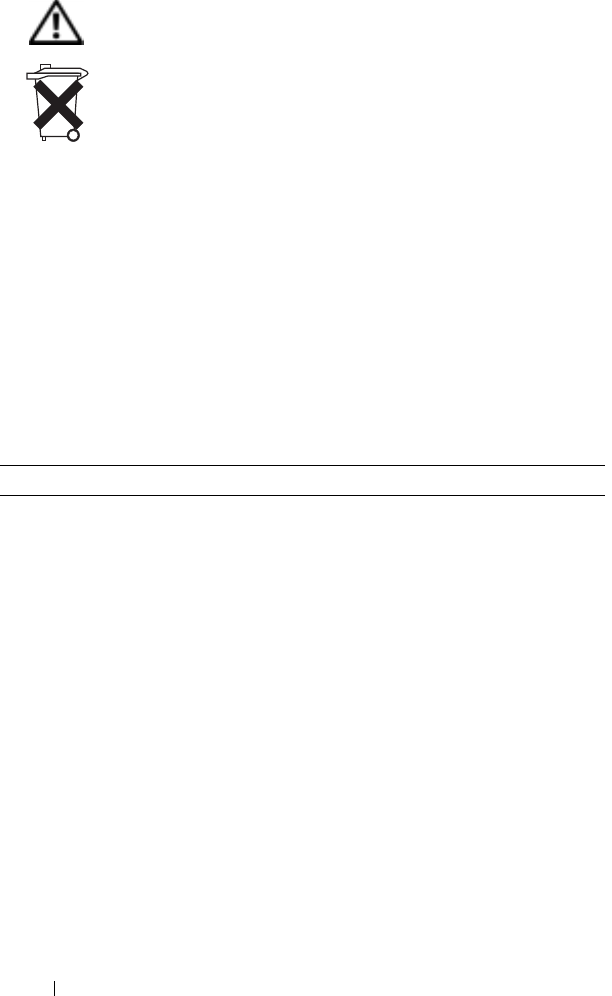
www.dell.com | support.dell.com
18 Finding Information
Finding Information
Battery Disposal
Your device uses a lithium-ion battery and a rechargeable NiMH
battery. For instructions about replacing the batteries in your device,
see "Using the Battery" on page 25.
Do not dispose of the battery along with household waste. Contact
your local waste disposal agency for the address of the nearest battery
deposit site.
What Are You Looking For? Find It Here:
How to set up my device and
information on the connectors and
buttons on my device
Getting Started placemat and the
Dell™ User’s Guide
Information on using my device. Dell User’s Guide and Pocket PC Help.
To view Help, tap the Start button and
tap Help.
Additional programs that can be
installed on my device Dell Companion CD
Information on using programs on my
device Pocket PC Help and, if available, tap
Help within a specific program
Connecting to and synchronizing with
a computer Dell User’s Guide and Microsoft®
ActiveSync® Help on your computer.
To view Help, click Help and click
Microsoft ActiveSync Help.
CAUTION: Safety Instructions
(continued)

www.dell.com | support.dell.com
Finding Information 19
Last-minute updates and detailed
technical information The readme files, located in the
ActiveSync folder on the computer and
on the Dell Companion CD.
Up-to-date information on your Pocket
PC www.microsoft.com/mobile/pocketpc
My service tag Label located in the battery slot
(remove the battery)
What Are You Looking For? Find It Here:

www.dell.com | support.dell.com
20 Finding Information

1
SECTION 1
About Your Device
Front, Side, and Back Views
Using the Battery
Connecting to a Computer
Using Secure Digital Memory Cards
Performing a Reset
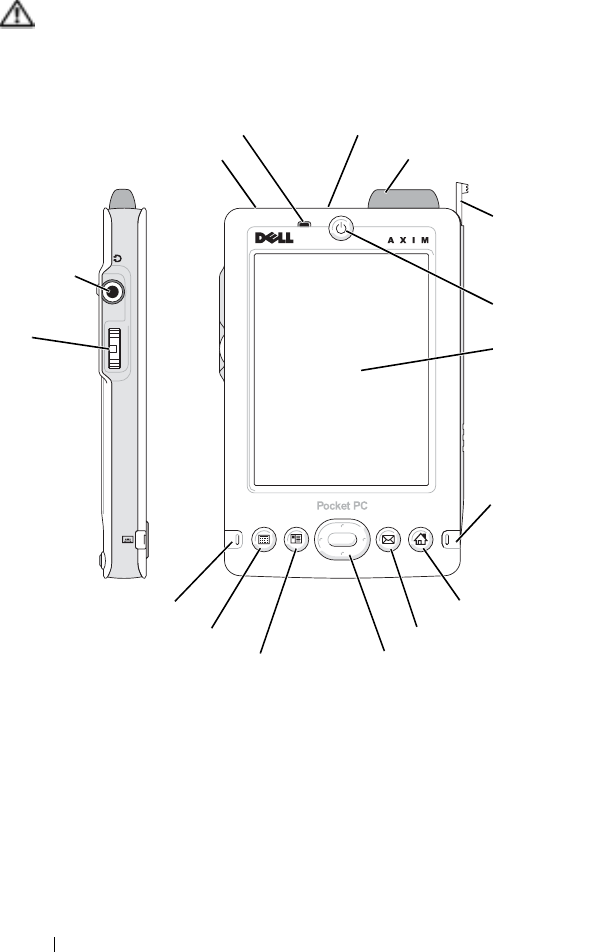
www.dell.com | support.dell.com
22 About Your Device
Front, Side, and Back Views
CAUTION: Before performing any of the procedures in this
section, read and follow the safety instructions on page 11.
Front and Side Views
INFRARED SENSOR —The infrared sensor lets you transfer files from your
device to another infrared-compatible device without using cable connections.
MICROPHONE —Allows you to record audio.
SECURE DIGITAL CARD SLOT —See "Using Secure Digital Memory Cards"
on page 32 for information on using Secure Digital memory cards.
WIRELESS ANTENNA —Allows you to transmit data (optional).
Secure Digital card slot (top)
stylus
(extended)
power button
touch screen
scroll
dial
navigator button
wireless/
Windows Medi
a
Player on/off
button
Home button
Contacts button
Calendar button
headphone
connector
infrared sensor (top)
Inbox button
microphone
record button
wireless antenna (optional)

www.dell.com | support.dell.com
About Your Device 23
STYLUS —Use the stylus to write or draw on the screen. To remove the stylus,
pull it straight up and out of the holder. To avoid losing the stylus, store the stylus
in the holder when you are not using it. Ensure that the stylus is oriented correctly
when you replace it in the slot.
POWER BUTTON —Press the power button to turn the device on or off. Press
and hold the power button to dim the display. Repeat to light the display.
• When the device is connected to external power and the main battery is fully
charged, the power button light is solid green.
• When the main battery charge is low, the power button light flashes amber.
• When the device relays a notification, the power button light rapidly flashes
amber.
TOUCH SCREEN —Use the touch screen and the stylus to enter information
into your device. See "Entering Information" on page 47.
WIRELESS OR MICROSOFT® WINDOWS® MEDIA PLAYER ON/OFF BUTTON —On
devices with wireless, this turns the wireless antenna on and off. Turn off the
antenna to conserve power. On non-wireless devices, this turns Windows Media
Player on and off.
HOME BUTTON —Press this button to launch Home or to turn on the device.
INBOX BUTTON —Press this button to launch your Inbox or to turn on the
device.
NAVIGATOR BUTTON —Press the right, left, top, or bottom of the navigator
button to move the cursor on the screen. Press the center to enter a selection.
CONTACTS BUTTON —Press this button to launch Contacts or to turn on the device.
CALENDAR BUTTON —Press this button to launch Calendar or to turn on the device.
RECORD BUTTON —See "Recording a Message" on page 58 for information on
using the record button.
SCROLL DIAL
• Press the scroll dial to perform actions similar to pressing <Enter> on a
keyboard.
• Rotate the scroll dial up or down to perform actions similar to using the up- and
down-arrow keys on a keyboard.
For information on the functionality of the scroll dial within programs, see Pocket
PC Help on your device.
HEADPHONE CONNECTOR —Attach headphones.
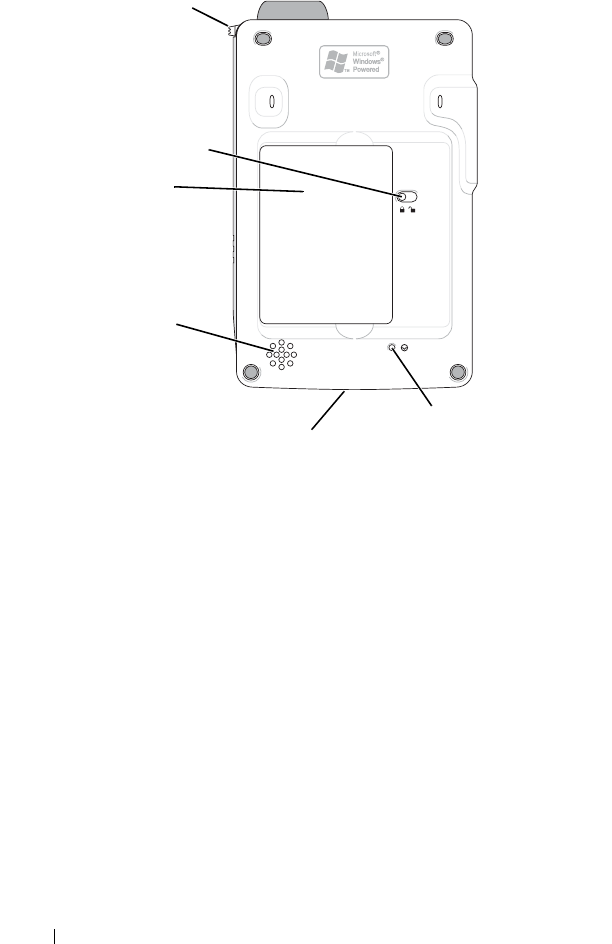
www.dell.com | support.dell.com
24 About Your Device
Back View
BATTERY LOCK —Use this switch to release and remove the main battery. See
"Installing and Removing the Battery" on page 25.
BATTERY —See "Using the Battery" on page 25 for information on the main
battery.
SPEAKER —Tap the speaker icon to adjust the volume.
CRADLE/SYNC CABLE CONNECTOR —Connect a cradle or sync cable. See
"Connecting to a Computer" on page 27.
RESET BUTTON —See "Performing a Reset" on page 33 for information on
using the reset button.
battery
stylus (secured)
battery lock
cradle/sync cable
connector (bottom) reset button
speaker
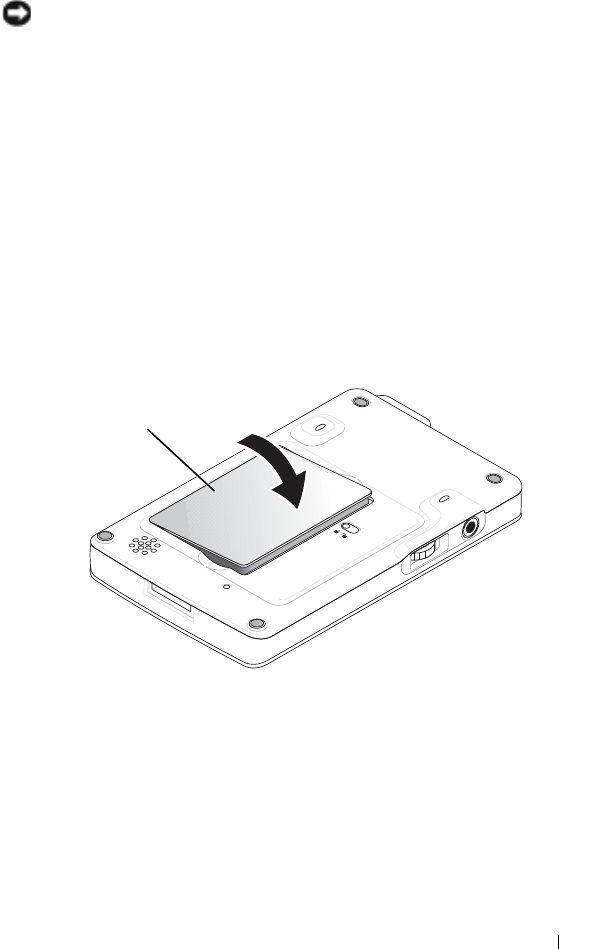
www.dell.com | support.dell.com
About Your Device 25
Using the Battery
NOTICE: Do not use your device until you have charged the main battery
for at least 4 hours.
Before you use your device for the first time, you must install and charge
the battery. Once the battery is charged, use the power properties to
monitor the battery charge. See Pocket PC Help on the device for more
information.
Installing and Removing the Battery
To install the battery:
1Ensure that the device is turned off.
2Insert the left side of the battery into the battery slot at an angle, and
lower the right side into the slot until it clicks.
battery
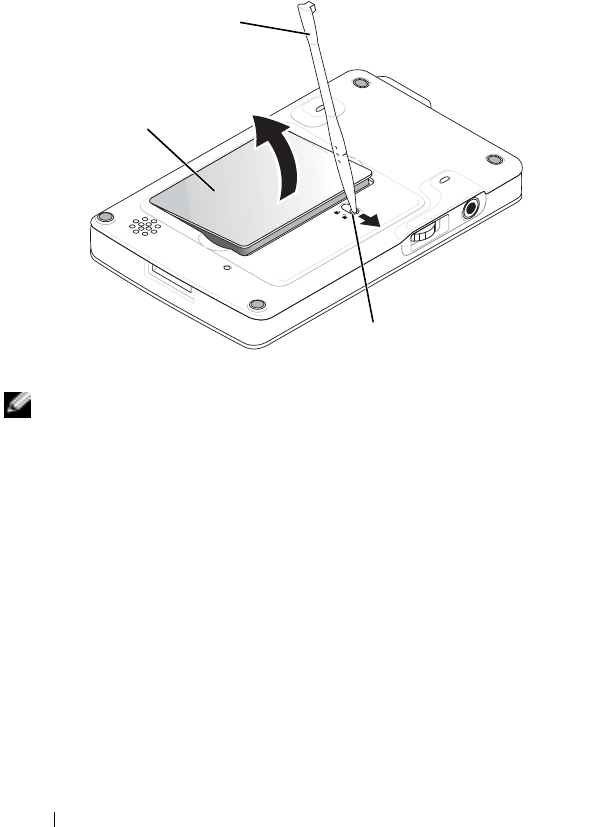
www.dell.com | support.dell.com
26 About Your Device
To remove the battery:
1Insert the tip of the stylus into the battery lock.
2Slide and hold the lock in the unlock position.
3Lift the battery out of the slot.
NOTE: Your service tag is located underneath the battery. You need
your service tag if you access Dell Support at support.dell.com or if
you call Dell for customer service or technical support.
Charging the Battery
Use one of the following options to charge the main battery:
• Connect the AC adapter directly to the charger adapter and then to
the device and to an electrical outlet.
• Connect the AC adapter directly to the sync cable and then to the
device and to an electrical outlet.
• Connect the AC adapter to the cradle, and insert the device into the
cradle. See "Using the Cradle" on page 27 for more information.
battery
stylus
battery lock

www.dell.com | support.dell.com
About Your Device 27
Connecting to a Computer
You either connect your device to a computer using a cradle or directly to
a computer using a sync cable. Connect your device to a computer to:
• Add programs to your device. See "Adding Programs Using
Microsoft® ActiveSync®" on page 86 for more information.
• Synchronize data on your device with data on your computer.
For information on synchronizing your data, see the following resources:
•"Using Microsoft
® ActiveSync®" on page 65
• ActiveSync Help on your computer
• ActiveSync Help on your device
Using the Cradle
NOTE: Depending on the configuration of your device, the cradle is
optional.
You can use the cradle to:
• Synchronize the data on your device with the data on your computer.
• Power the device with AC power to conserve battery power.
• Charge the main battery. See "Using the Battery" on page 25 for more
information.
• Charge a spare battery.
NOTE: Before connecting your device to a computer for the first
time, ensure that you install ActiveSync on the computer from the
Dell™ Companion CD.
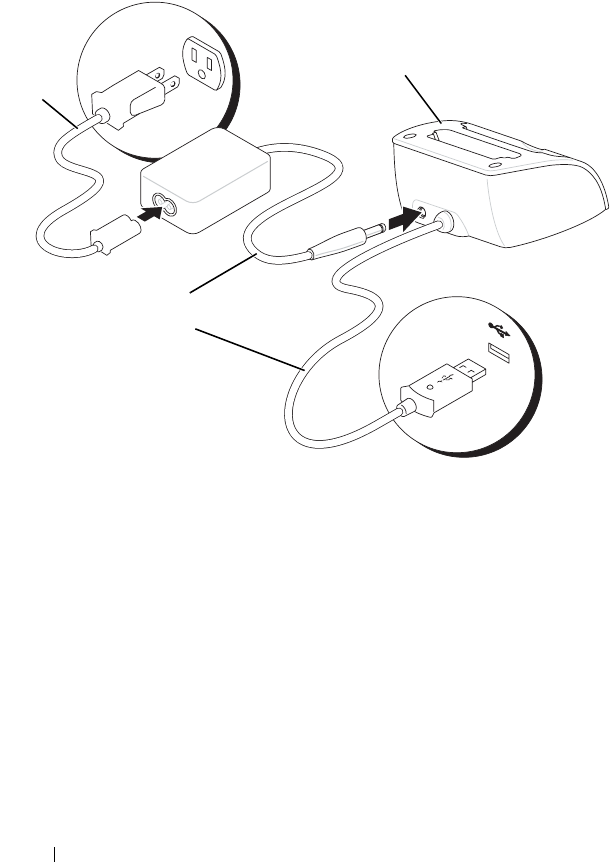
www.dell.com | support.dell.com
28 About Your Device
To connect your device to the cradle:
1Place the cradle on a flat, level surface near your computer.
2Connect the cradle cable to the USB connector on your computer.
power
cord cradle
USB connection
to the computer
AC adapter
cradle cable
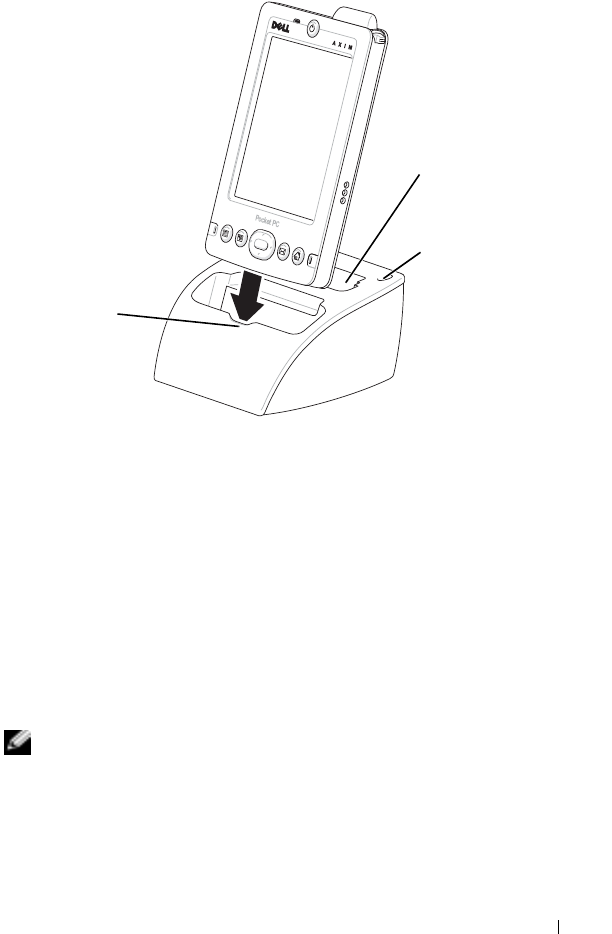
www.dell.com | support.dell.com
About Your Device 29
3Connect the AC adapter to the cradle and to an electrical outlet.
4Align the connector on the bottom of the device with the connector
on the cradle, and, keeping the front of the device flush with the
front of the cradle, lower the device onto the cradle.
When the device is docked in the cradle, the DELL™ logo on the cradle
lights up and the connection status icon appears on the command bar (see
page 37).
The spare battery status light on the cradle operates as follows:
• Green — The spare battery is fully charged.
• Amber — The spare battery is charging.
NOTE: The power button on the device indicates the charge status of
the main battery. See the description of the device status lights on
page 23 for more information.
front of
cradle
stylus holder (2)
spare battery
charger

www.dell.com | support.dell.com
30 About Your Device
To remove the device from the cradle, pull the device straight up and out
of the cradle.
Using the Sync Cable
Use the sync cable to connect your device directly to the computer
without using the cradle.
NOTE: Depending on the configuration of your device, the sync cable
is optional.
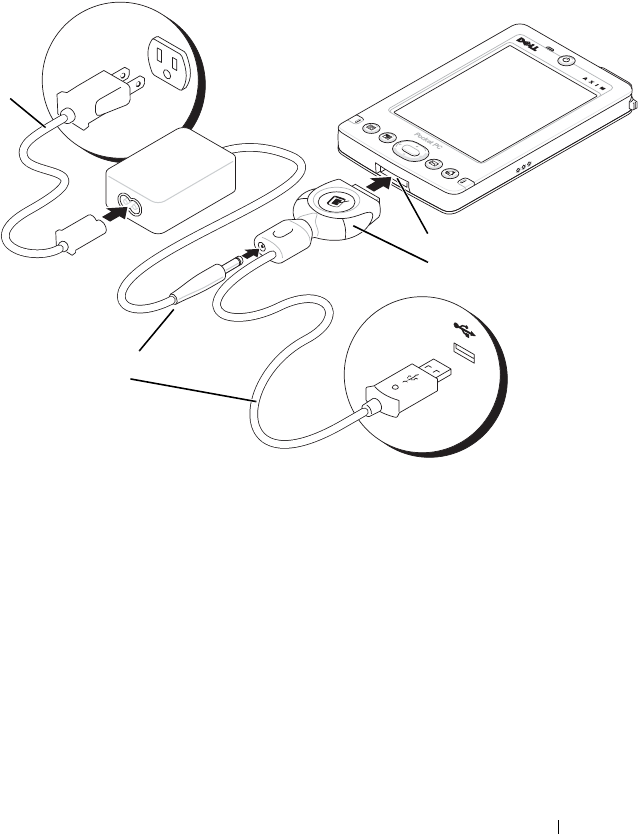
www.dell.com | support.dell.com
About Your Device 31
To connect the sync cable:
1Connect one end of the cable to the USB connector on your
computer.
2Connect the other end of the cable to your device.
sync cable connector
USB connection
to the computer
AC adapter
sync cable
device connector
power
cord
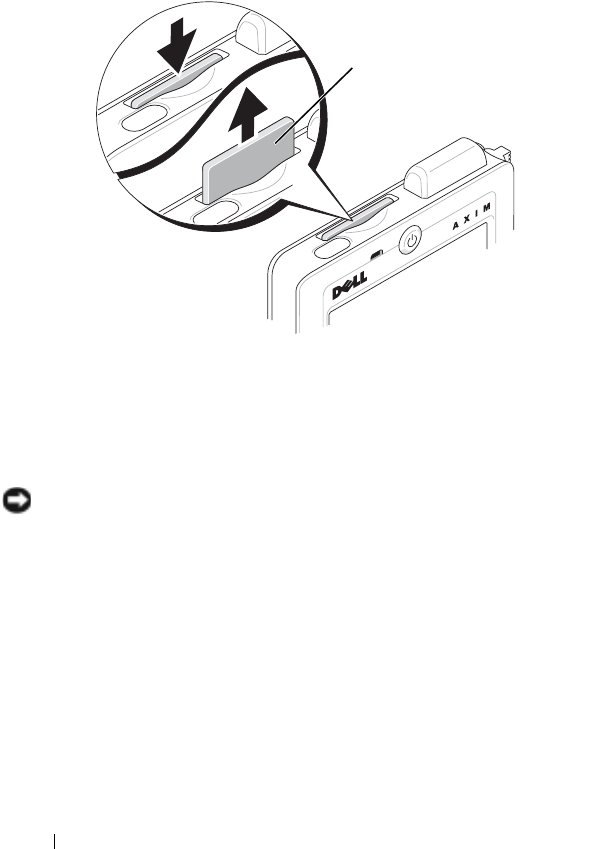
www.dell.com | support.dell.com
32 About Your Device
Using Secure Digital Memory Cards
Use Secure Digital memory cards to save or back up data.
To install a Secure Digital memory card:
1If a card is already installed, press in the card to release it, and then
remove it.
2Ensure that the card is oriented correctly, and slide it into the slot
until you feel a click.
NOTICE: Do not force the card. If you feel resistance, remove the card,
check the orientation, and reinsert it.
See the documentation that came with the card for information on using
the card.
blank
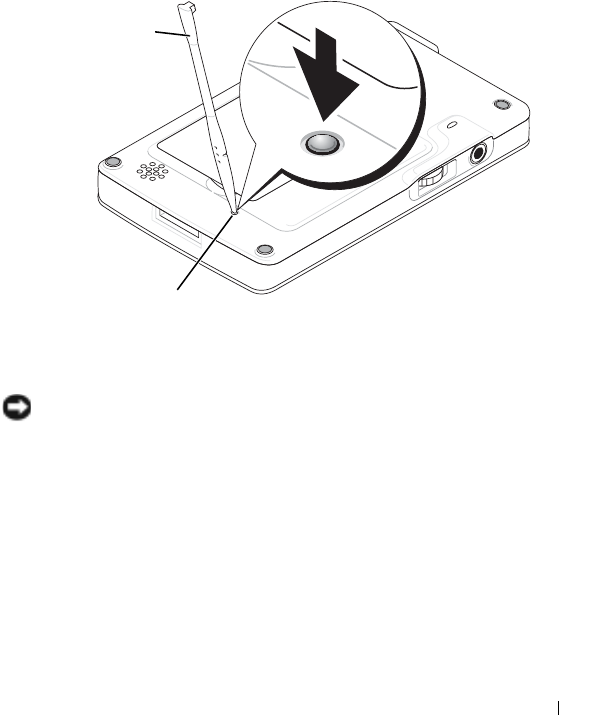
www.dell.com | support.dell.com
About Your Device 33
Performing a Reset
Soft Reset
When you perform a soft reset, the device deletes any data that has not
been saved but saves any data that has been stored in memory. Try
performing a soft reset if the device does not respond when you tap the
display or press a button.
To perform a soft reset, use the stylus to press the reset button.
Hard Reset
NOTICE: When you perform a hard reset, you lose all the data stored and
any program you installed on your device.
Perform a hard reset if:
• You want to delete all the data stored on your device.
• You forget your password and need to clear it.
• Your device is experiencing severe operational problems and you have
already attempted a soft reset.
stylus
reset button

www.dell.com | support.dell.com
34 About Your Device
NOTICE: It is strongly recommended that you back up your data before you
perform a hard reset. See ActiveSync Help on your computer for more
information.
To perform a hard reset:
1Press and hold the power button.
2With the stylus, hold the reset button for about 2 seconds.
3Follow the instructions on the screen.

2
SECTION 2
Using Microsoft®
Pocket PC
Device Buttons and the Stylus
Today Screen
Status Icons
Programs
Navigation Bar and Command Bar
Pop-Up Menus
Finding and Organizing Information
Backing Up Data

www.dell.com | support.dell.com
36 Using Microsoft® Pocket PC
Device Buttons and the Stylus
Your device has hardware buttons that control actions and scroll
functions, and a stylus for selecting items and entering information.
On the device, the stylus replaces the mouse:
• Tap — Touch the screen once with the stylus to open items and
select options.
• Drag — Hold the stylus and drag across the screen to select text and
images. Drag in a list to select multiple items.
• Tap and hold — Tap and hold the stylus on an item to see a list of
actions available for that item. On the pop-up menu that appears,
tap the action you want to perform.
See "Entering Information" on page 47 for more information.
Today Screen
When you turn on your device for the first time each day (or after 4 hours
of inactivity), the Today screen appears. You can also view the Today
screen by tapping the Start button and then tapping Today. The Today
screen displays the date and information about the device owner, today’s
calendar, and important tasks. To customize the Today screen:
1Tap the Start button and tap Settings.
2Tap the Personal tab and tap Today.
Use the Appearance tab to change the background that displays on
the Today screen.
Use the Items tab to change the items that appear on the Today
screen.
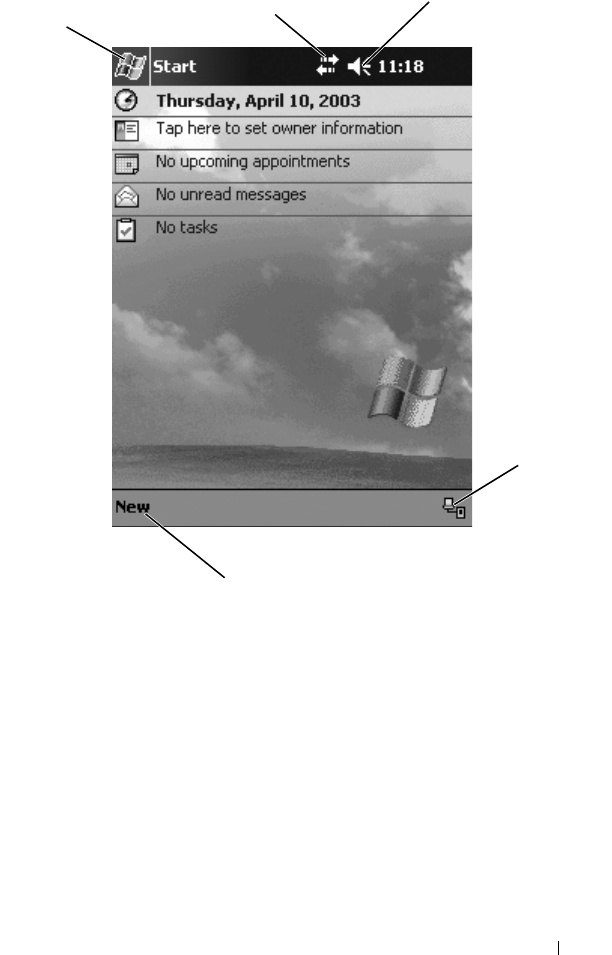
www.dell.com | support.dell.com
Using Microsoft® Pocket PC 37
Start
button
connection
status icon
New items menu
volume control icon
connection
configuration icon
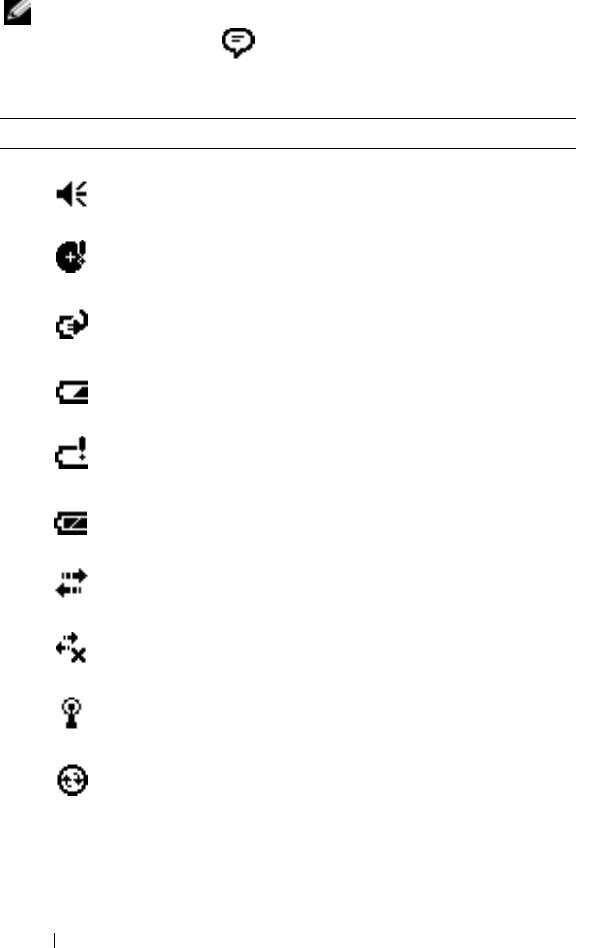
www.dell.com | support.dell.com
38 Using Microsoft® Pocket PC
Status Icons
NOTE: If there is not enough room to display all notification icons,
the notification icon, , displays. Tap the notification icon to view
all notifications.
Icon Description
Turns sound on and off.
Backup battery is low.
Main battery is charging.
Main battery is low.
Main battery is very low.
Main battery is full.
Connection is active. Tap the icon to configure
connections.
Connection is not detected.
Wireless network is detected.
Synchronization is beginning or ending.
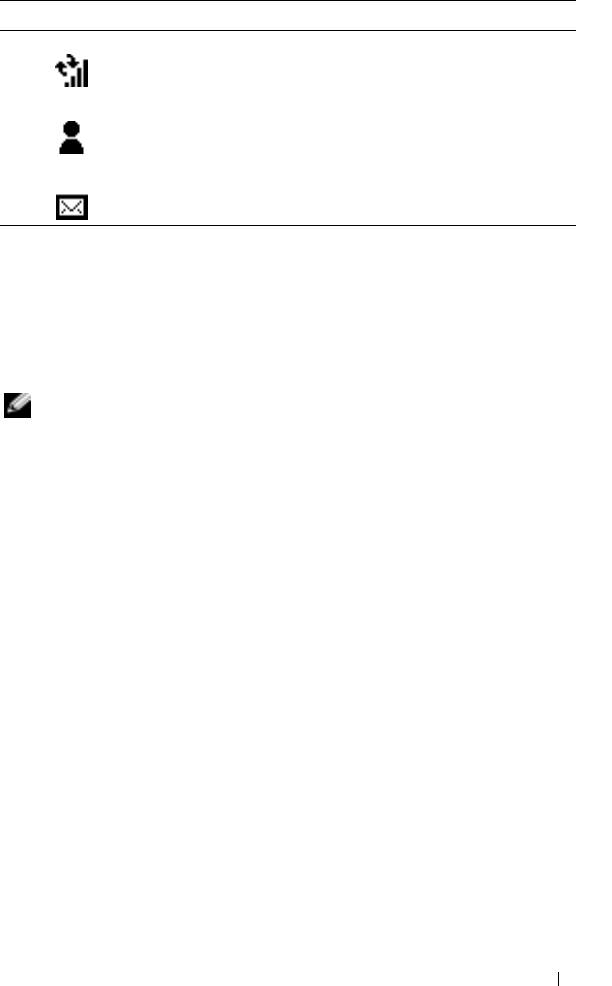
www.dell.com | support.dell.com
Using Microsoft® Pocket PC 39
Programs
You can switch from one program to another by selecting a program from
the Start menu. To access programs that are not listed in the Start menu,
tap the Start button, tap Programs, and then tap the program name.
NOTE: Some programs have abbreviated labels for check boxes and
drop-down menus. To see the full spelling of an abbreviated label,
tap and hold the stylus on the label. Drag the stylus off the label so
that the command is not carried out.
Program Buttons
You can also switch to some programs by pressing a program button. Your
device has four program buttons located on the front of the device. The
icons on the buttons identify the programs to which they switch. By
default, the buttons launch Home, Inbox, Contacts, and Calendar.
Synchronization is occurring.
New instant message(s).
New e-mail message(s).
Icon Description
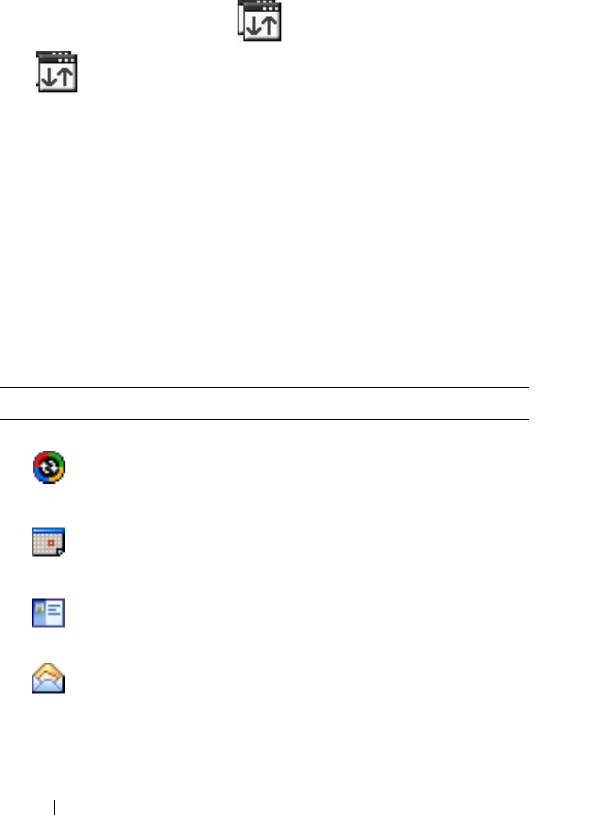
www.dell.com | support.dell.com
40 Using Microsoft® Pocket PC
Switcher Bar
You can also use Switcher Bar to switch to or close open programs. To
launch Switcher Bar:
1Tap the Start button and tap Settings.
2Tap the System tab and tap Switcher Bar.
The Switcher Bar icon, , appears in the navigation bar.
Tap to view a list of all open programs. In the Switcher Bar menu:
•Tap Brightness settings or Power settings to configure those settings.
• Tap a program name to switch to that program.
•Tap Exit current program to close the current program.
•Tap Exit all programs to close all open programs.
•Tap Exit Switcher Bar to close the menu.
The following table contains a partial list of programs that are on your
device. See the Dell™ Companion CD for additional programs that you
can install on your device.
Icon Program Description
ActiveSync Synchronize information
between your device and
your computer.
Calendar Keep track of your
appointments and create
meeting requests.
Contacts Keep track of your friends
and colleagues.
Inbox Send and receive e-mail
messages.
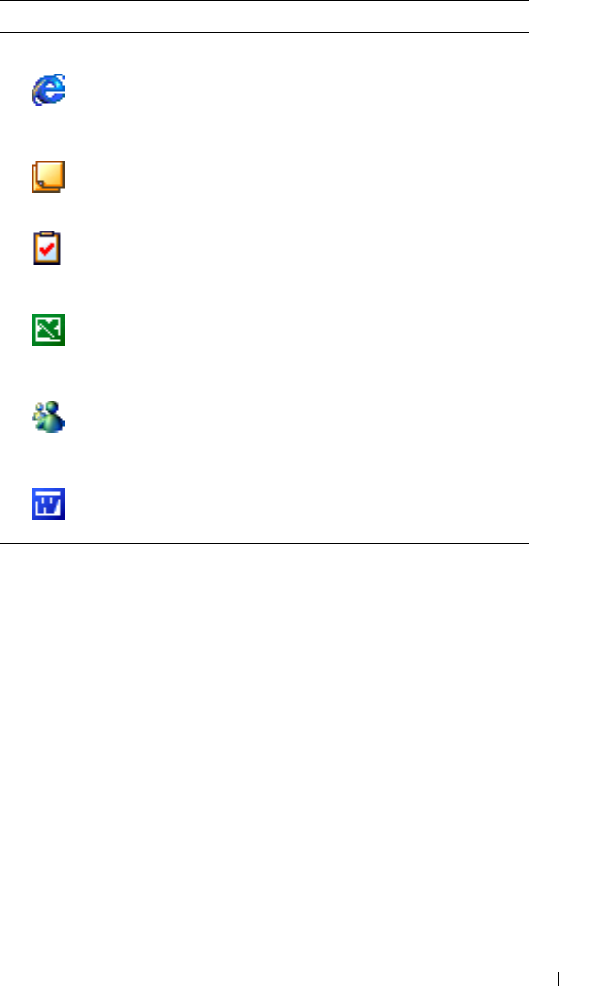
www.dell.com | support.dell.com
Using Microsoft® Pocket PC 41
Navigation Bar and Command Bar
The navigation bar is located at the top of the screen. It displays the active
program and current time and allows you to switch to other programs and
close screens.
Use the command bar at the bottom of the screen to perform tasks in
programs. The command bar includes menu names, icons, and the input
panel icon. To create a new item in the current program, tap New. To see
the name of an icon, tap and hold the stylus on the icon. Drag the stylus
off the icon so that the command is not carried out.
Pocket Internet Explorer
Browse websites and WAP
sites, and download new
programs and files from the
Internet.
Notes Create handwritten or
typed notes, drawings, or
recordings.
Tasks Keep track of your tasks.
Pocket Excel
Create new workbooks or
view and edit Excel
workbooks that you created
on your computer.
MSN Messenger Send and receive instant
messages with your MSN
Messenger contacts.
Pocket Word
Create new documents or
view and edit Word
documents that you created
on your computer.
Icon Program Description
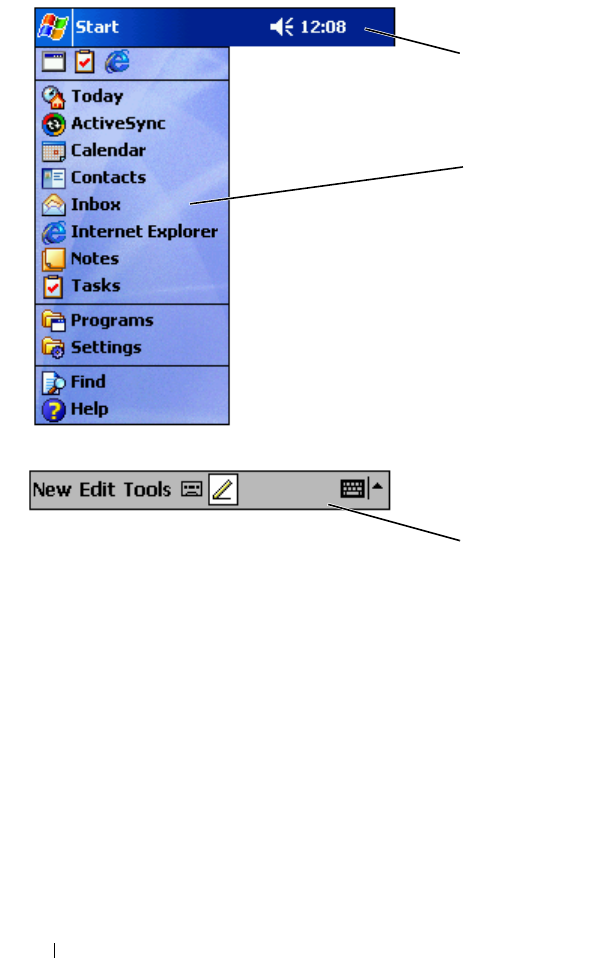
www.dell.com | support.dell.com
42 Using Microsoft® Pocket PC
navigation bar
Start menu
command bar
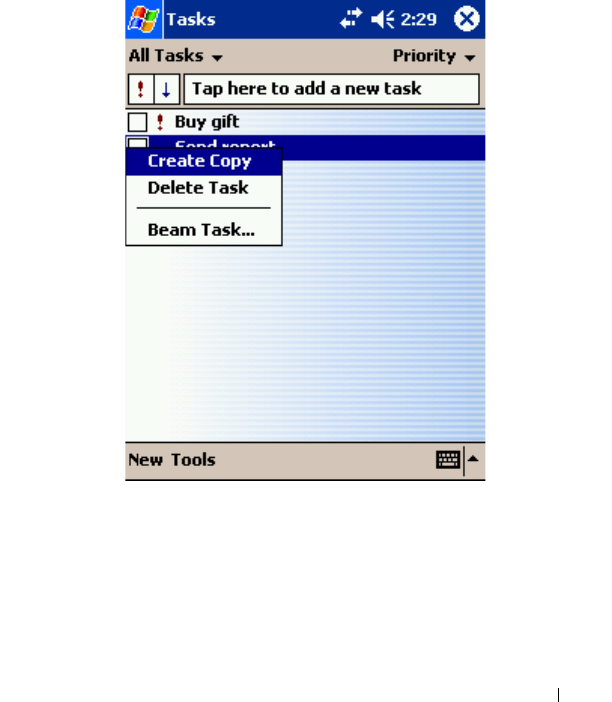
www.dell.com | support.dell.com
Using Microsoft® Pocket PC 43
Pop-Up Menus
With pop-up menus, you can quickly select an action for an item. For
example, you can use the pop-up menu in the contact list to delete a
contact, make a copy of a contact, or send an e-mail message to a contact.
The actions in the pop-up menus vary from program to program. To
access a pop-up menu, tap and hold the stylus on an item name. When
the menu appears, lift the stylus and tap the action you want to perform.
To close the menu without performing an action, tap anywhere outside
the menu.
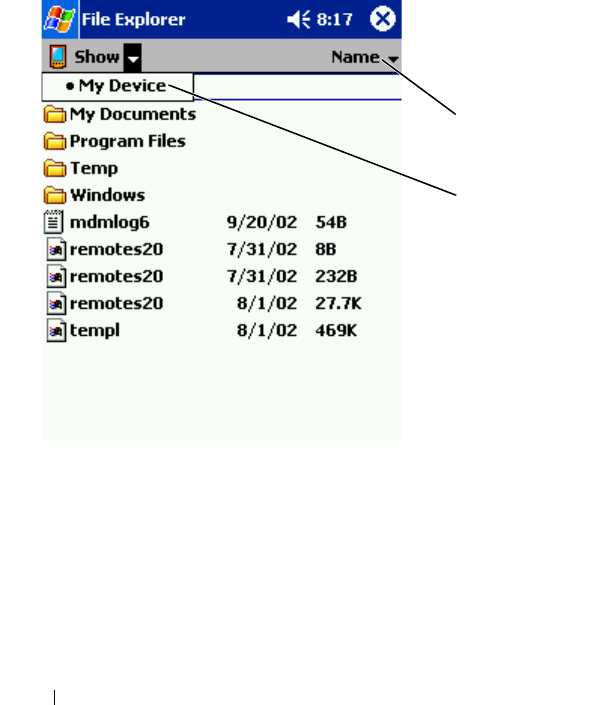
www.dell.com | support.dell.com
44 Using Microsoft® Pocket PC
Finding and Organizing Information
The Find feature on your device helps you to quickly locate information.
On the Start menu, tap Find. Enter the item that you want to find, select
a data type from the drop-down menu, and then tap Go to start the
search.
You can also use the File Explorer to find files on your device and to
organize your files into folders. On the Start menu, tap Programs and tap
File Explorer.
sort menu
folder location

www.dell.com | support.dell.com
Using Microsoft® Pocket PC 45
Backing Up Data
NOTICE: If you are upgrading to Pocket PC 2003 from Pocket PC 2002,
do not use the Data Backup utility on your device or the Backup/Restore
option in ActiveSync to back up your files. You cannot recover your data
after you install the upgrade if you do so. Follow the instructions included
with the Pocket PC 2003 System Update to back up your data.
To prevent or minimize data loss, you should periodically back up the data
stored on your device. Use ActiveSync to synchronize the files on your
device with the files on your computer. You can also drag and drop files
from your device to your computer using Windows Explorer. See the
ActiveSync Help on your computer for additional information.

www.dell.com | support.dell.com
46 Using Microsoft® Pocket PC

3
SECTION 3
Entering
Information
Entering Text Using the Input Panel
Writing on the Screen
Drawing on the Screen
Recording a Message
Using My Text
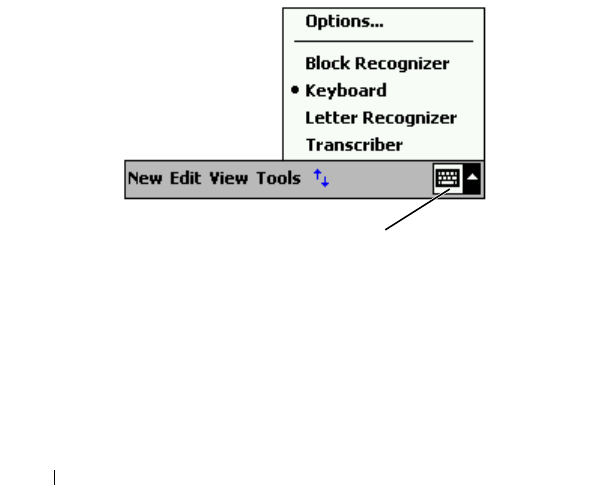
www.dell.com | support.dell.com
48 Entering Information
You have several options for entering information:
• Use the input panel to enter typed text using the soft keyboard or
another input method.
• Write directly on the screen with the stylus.
• Draw pictures on the screen with the stylus.
• Speak into your device microphone to record a message.
Use Microsoft® ActiveSync® to synchronize or copy information from
your computer to your device. For more information on ActiveSync, see
ActiveSync Help on your computer.
Entering Text Using the Input Panel
Use the input panel to enter information in any program on your device.
You can type using the soft keyboard or write using Letter Recognizer,
Block Recognizer, or Transcriber. The characters appear as typed text on
the screen.
To show or hide the input panel, tap the input panel icon. Tap the arrow
next to the input panel icon to change input methods.
input panel icon
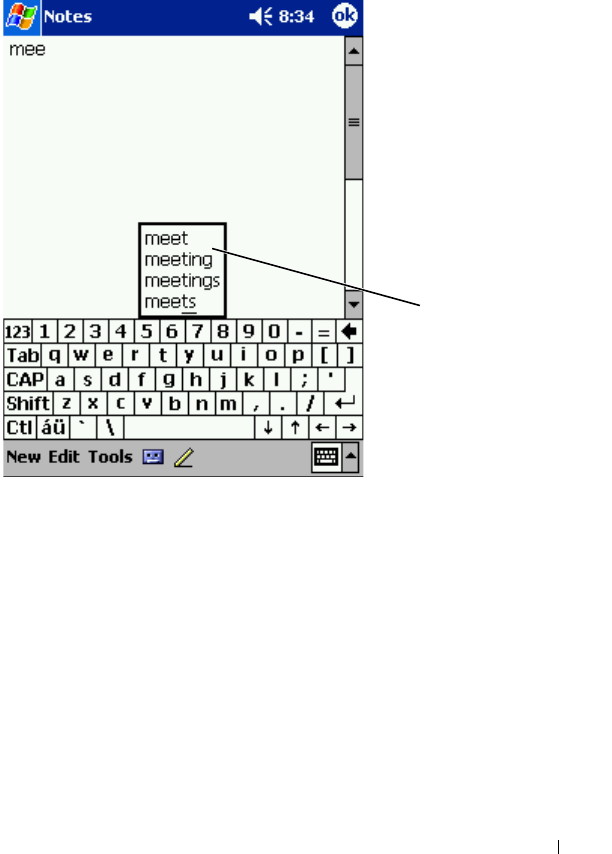
www.dell.com | support.dell.com
Entering Information 49
When you use the input panel, your device anticipates the word you are
typing or writing and displays it above the input panel. When you tap the
displayed word, the word is inserted at the insertion point. The more you
use your device, the more words it learns to anticipate.
To change word suggestion options, such as the number of words
suggested:
1Tap the Start button and tap Settings.
2Tap the Personal tab, tap Input, and then tap the Word Completion
tab.
3Select the desired settings and tap OK.
suggested words

www.dell.com | support.dell.com
50 Entering Information
Typing With the Soft Keyboard
1Tap the arrow next to the input panel icon and tap Keyboard.
2Tap the keys on the soft keyboard with your stylus.
Letter Recognizer
Letter Recognizer allows you to use your stylus to write letters on the
screen as you would write them on paper.
NOTE: Letter Recognizer is included with the English, French,
German, Italian, and Spanish operating systems. Other versions do
not support Letter Recognizer.
1Tap the arrow next to the input panel icon and tap Letter
Recognizer.
2With your stylus, write a letter between the lines that appear on the
bottom of the screen.
The letters are converted to typed text on the screen. For specific
instructions on using Letter Recognizer, tap the question mark next
to the writing area.
NOTE: Tap Demo to learn the character strokes that the device can
recognize.

www.dell.com | support.dell.com
Entering Information 51
Block Recognizer
Block Recognizer allows you to use character strokes that are similar to
those used on other handheld devices.
NOTE: Block Recognizer is included with the English, French,
German, Italian, and Spanish operating systems. Other versions do
not support Block Recognizer.
1Tap the arrow next to the input panel icon and tap Block Recognizer.
2Using your stylus, write the appropriate character stroke in the box
that appears at the bottom of the screen.
The character strokes are converted to typed text on the screen. For
specific instructions on using Block Recognizer, tap the question
mark next to the writing area.
NOTE: Tap Demo to learn the character strokes that the device can
recognize.
Transcriber
Transcriber allows you to write anywhere on the screen using the stylus
similar to the way that you would write on paper. Unlike Letter Recognizer
and Block Recognizer, you can write a sentence or more, and then pause to
let Transcriber change the written characters to typed characters.
NOTE: Transcriber is included with the English, French, and German
operating systems. Other versions do not support Transcriber.
1Tap the arrow next to the input panel icon and tap Transcriber.
2With your stylus, write anywhere on the screen.
When you pause, Transcriber converts your written characters to
typed characters. For specific instructions on using Transcriber, tap
the question mark in the lower right hand corner of the screen.

www.dell.com | support.dell.com
52 Entering Information
Editing Typed Text
To edit or format typed text, you must select it first:
1Drag the stylus across the text that you want to select.
2Tap and hold the selected text.
3Tap the appropriate editing command in the pop-up menu.
You can also tap Edit at the bottom of the screen to select editing
commands.
Writing on the Screen
In any program that accepts written text, such as the Notes program and
the Notes tab in some programs, you can use your stylus to write directly
on the screen. You can edit and format what you have written and convert
the information to text at a later time.
NOTE: Some programs that accept written text may not have the pen
icon. See the documentation for that program to find out how to
switch to writing mode.
To write on the screen, tap the pen icon to switch to writing mode. This
action displays lines on the screen to help you write.
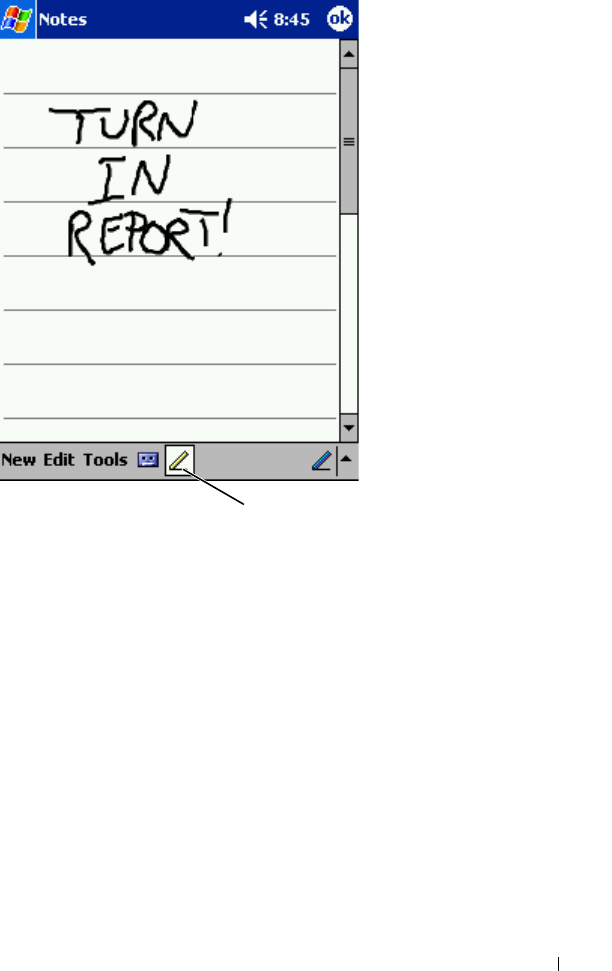
www.dell.com | support.dell.com
Entering Information 53
Editing Written Text
To edit or format written text, you must select it first:
1Tap the pen icon to deselect it.
2Drag the stylus across the text that you want to select.
3Tap and hold the selected text.
4Tap the appropriate editing command in the pop-up menu.
You can also tap Edit at the bottom of the screen to select editing
commands.
5Tap the pen icon to switch back to writing mode.
pen icon
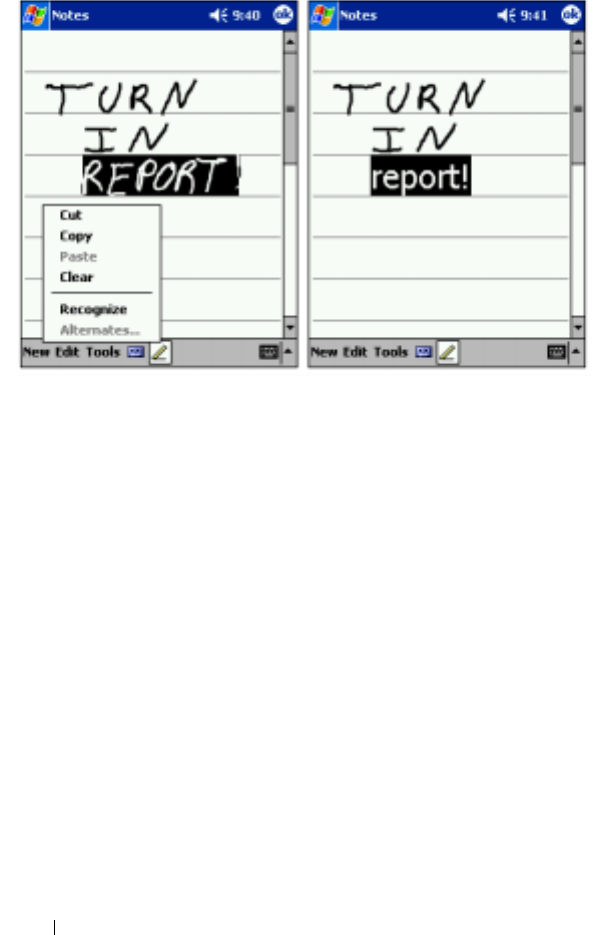
www.dell.com | support.dell.com
54 Entering Information
To convert written text to print-style text, tap Tools and tap Recognize.
If you want to convert only certain words, select them before tapping
Recognize (or tap and hold the selected words and then tap Recognize on
the pop-up menu). If a word is not recognized, it is not converted to print-
style text.
If the conversion is incorrect, you can select different words from a list of
alternatives or return to the original written text:
1Tap and hold the incorrect word.
2On the pop-up menu, tap Alternates.
A menu with a list of alternative words appears.
3Tap the correct word, or tap the written text at the top of the menu
to return to the original written text.
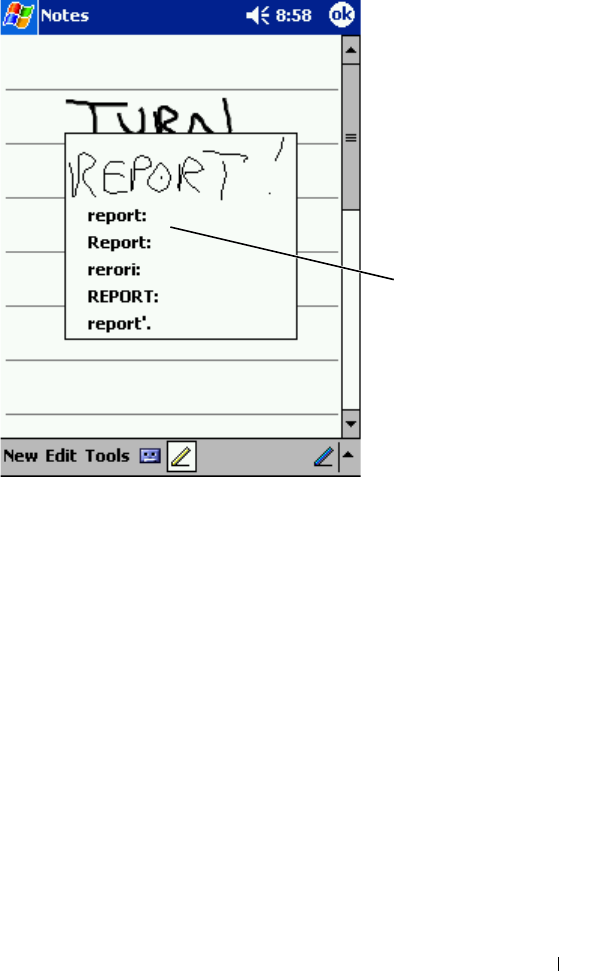
www.dell.com | support.dell.com
Entering Information 55
Tips for getting good recognition:
• Write neatly.
• Write on the lines and draw descenders below the line. Write the
cross of the "t" and apostrophes below the top line so that they are
not confused with the word above. Write periods and commas above
the line.
• For better recognition, try changing the zoom level to 300 percent
using the Tools menu.
• Write the letters of a word closely and leave big gaps between words
so that the device can easily determine where words begin and end.
• Hyphenated words, foreign words that use special characters such as
accents, and some punctuation cannot be converted.
alternate
words

www.dell.com | support.dell.com
56 Entering Information
• You cannot add written text to a word to change it after the word has
been recognized. You must delete the written word and write the new
word.
Drawing on the Screen
You can draw on the screen the same way that you write on the screen;
however, selecting and editing drawings is different than selecting and
editing written text. For example, selected drawings can be resized, while
written text cannot.
Creating a Drawing
NOTE: To zoom in or out on your drawing, tap Tools and tap a zoom
level.
Cross three ruled lines on your first stroke. A drawing box appears.
Subsequent strokes that touch or are inside of the drawing box become
part of the drawing. Drawings that do not cross three ruled lines are
treated as written text.
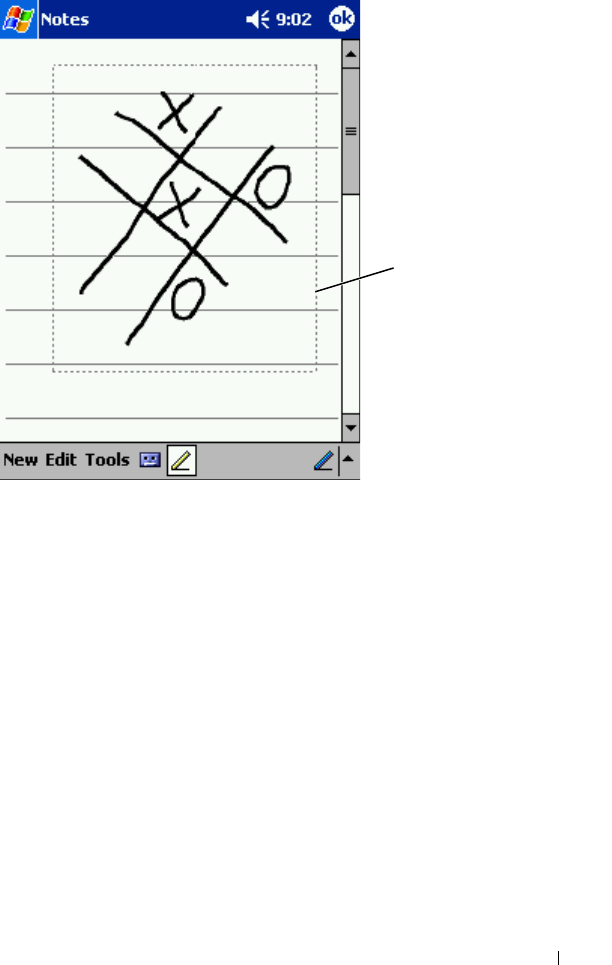
www.dell.com | support.dell.com
Entering Information 57
Editing a Drawing
To edit or format a drawing, you must select it first:
1Tap and hold the stylus on the drawing until the selection handle
appears.
To select multiple drawings, deselect the pen icon and drag to select
the drawings.
2Tap and hold the selected drawing and tap an editing command on
the pop-up menu.
drawing box

www.dell.com | support.dell.com
58 Entering Information
3You can cut, copy, and paste selected drawings by tapping and
holding the selected drawing and then tapping an editing command
on the pop-up menu.
You can also tap Edit at the bottom of the screen to select editing
commands.
To resize a drawing, ensure that the Pen icon is not selected, and drag a
selection handle.
Recording a Message
In any program where you can write or draw on the screen, you can also
quickly capture thoughts, reminders, and phone numbers by recording a
message. In Calendar, Tasks, and Contacts, you can include a recording in
the Notes tab. In the Notes program, you can either create a stand-alone
recording or include a recording in a written note. If you want to include
the recording in a note, open the note first. In the Inbox program, you can
add a recording to an e-mail message.
To record a message:
1Hold the microphone near your mouth or other source of sound.
2Press and hold the Record button on the side of your device until it
beeps.
3While holding down the Record button, make your recording.
4To stop recording, release the Record button.
The device beeps twice. The new recording appears in the note list or
as an embedded icon.
NOTE: You can also make a recording by tapping the Record icon on
the Recording toolbar.
To play a recording, tap the name of the recording in the list or tap the
speaker icon in the note.
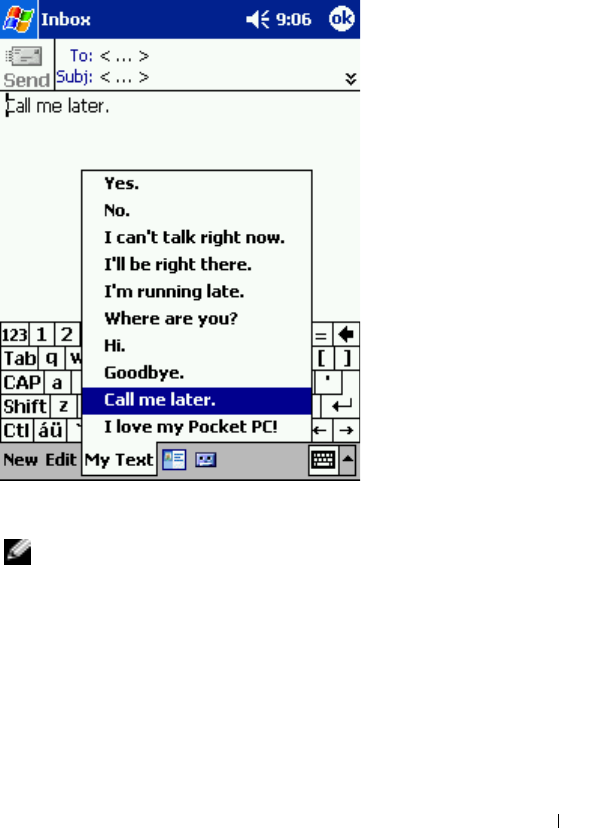
www.dell.com | support.dell.com
Entering Information 59
Using My Text
When using Inbox or MSN Messenger, use My Text to quickly insert
preset or frequently used messages. To insert a message, tap My Text and
tap a message.
NOTE: You can add text to a My Text message after you insert the
message.
To edit a My Text message:
1In Inbox or MSN Messenger, tap Tools.
2Ta p Edit My Text Messages.
3Make the changes and tap OK.

www.dell.com | support.dell.com
60 Entering Information

4
SECTION 4
Adjusting Settings
Personal Tab
System Tab
Connections Tab

www.dell.com | support.dell.com
62 Adjusting Settings
You can adjust the device settings to suit the way you work. To see
available options, tap the Start button and tap Settings.
NOTE: Depending on the features of your device, you might have
additional tabs and additional items on the tabs.
See Pocket PC Help on your device for additional information on
adjusting settings (tap the Start button and tap Help).
Personal Tab
•Buttons — Assign the programs that launch when you press the
hardware buttons.
•Input — Adjust the settings for input method, word completion,
and other options.
•Menus — Add or remove items from the Start menu.
•Navigator Button — Configure your device to allow you to press the
center of the navigator button to perform functions similar to
pressing <Enter> on a keyboard.
•Owner Information — Enter your contact information.
•Password — Set a password to protect the data stored on your device.
•Sounds & Notification — Adjust the volume and set notifications.
See "Notifications" on page 84 for more information.
•Today — Customize the look and the information that is displayed
on the Today screen.
System Tab
•About — Find information about Microsoft® Pocket PC and your
device.
•Brightness — Adjust the brightness settings to conserve power.

www.dell.com | support.dell.com
Adjusting Settings 63
•Certificates — View or delete certificates stored on your device.
Certificates help establish your identity and the identity of other
computers to prevent unauthorized users from accessing your data.
•Clock — Change the time or set the alarm.
•Microphone — Adjust the microphone gain.
•Power — Check the battery or charge status. Set the amount of time
that the device can remain idle before it turns off.
•Regional Settings — View and change the formatting for regional
settings, such as currency, time, and date.
•Remove Programs — Remove programs from your device. For more
information, see "Adding and Removing Programs" on page 85.
•Screen — Adjust the screen if your device is not responding
accurately to taps.
•Switcher Bar — Adjust the settings of the Switcher Bar program
launcher utility.
•System Information — View technical information about your
device.
Connections Tab
•Beam — Receive infrared beams from other devices.
•Bluetooth — Turn the Bluetooth™ radio on and off, and create and
edit bonded devices. By default, the Bluetooth radio is off.
•Connections — Add and configure modem or server connections.
•Wireless Ethernet — Configure your network adapter settings.

www.dell.com | support.dell.com
64 Adjusting Settings

5
SECTION 5
Using Microsoft®
ActiveSync®
About ActiveSync
Installing and Using ActiveSync

www.dell.com | support.dell.com
66 Using Microsoft® ActiveSync®
About ActiveSync
You can synchronize the information on your computer with the
information on your device with ActiveSync. Synchronization compares
the data on your device with the data on your computer and updates both
with the most recent information. For example:
• Keep Microsoft Pocket Outlook data up-to-date by synchronizing
your device with Microsoft Outlook data on your computer.
• Synchronize Microsoft Word and Microsoft Excel files between your
device and your computer. Your files are automatically converted to
the correct format.
NOTE: By default, ActiveSync does not automatically synchronize
all types of information. You can change ActiveSync options to
synchronize specific types of information.
With ActiveSync, you can also:
• Back up and restore your device data.
NOTICE: If you are upgrading to Pocket PC 2003 from Pocket PC 2002,
do not use the Data Backup utility on your device or the Backup/Restore
option in ActiveSync to back up your files. You cannot recover your data
after you install the upgrade if you do so. Follow the instructions included
with the Pocket PC 2003 System Update to back up your data.
• Copy (rather than synchronize) files between your device and your
computer.
• Select a synchronization mode to control when synchronization
occurs. For example, you can synchronize continuously or only when
you select the synchronize command.
• Select which information types are synchronized and control how
much data is synchronized. For example, you can choose how many
weeks of past appointments you want synchronized.

www.dell.com | support.dell.com
Using Microsoft® ActiveSync®67
To synchronize your data, you need both the Microsoft Windows® and
Pocket PC versions of ActiveSync. You must install the Windows version
of ActiveSync on your computer using the Dell™ Companion CD. The
Pocket PC version is already installed on your device.
NOTE: Before connecting your device to a computer for the first
time, ensure that you install ActiveSync on the computer from the
Dell™ Companion CD.
Installing and Using ActiveSync
To install ActiveSync:
1Insert the Dell Companion CD.
2Click the yellow triangle to access the main menu.
3Click Start Here.
4Click Install ActiveSync and follow the instructions on the screen.
After the installation is complete, the ActiveSync Setup Wizard helps you
to connect your device to your computer, set up a partnership so that you
can synchronize information between your device and your computer, and
customize your synchronization settings. Your first synchronization
process automatically begins when you complete the wizard.
During your first synchronization, information that was stored in Outlook
on your computer is copied to Calendar, Contacts, and Tasks on your
device.
After you set up ActiveSync and complete the first synchronization
process, you can initiate synchronization from your device. To switch to
ActiveSync on your device, tap the Start button and tap ActiveSync. If
you have a wireless LAN card, you can synchronize remotely from your
device.
To find information on using ActiveSync on your device, open ActiveSync
on your device, tap the Start button, and then tap Help.

www.dell.com | support.dell.com
68 Using Microsoft® ActiveSync®
To find information on using ActiveSync on your computer, open
ActiveSync on your computer, and click Help→ Microsoft ActiveSync
Help.

6
SECTION 6
Scheduling and
Communicating
About Microsoft® Pocket Outlook
Calendar
Contacts
Tasks
Notes
Inbox
Notifications

www.dell.com | support.dell.com
70 Scheduling and Communicating
About Microsoft® Pocket Outlook
Pocket Outlook includes Calendar, Contacts, Tasks, Inbox, and Notes. You
can use these programs individually or together. For example, e-mail
addresses stored in Contacts can be used to address e-mail messages in
Inbox.
Using Microsoft ActiveSync®, you can synchronize information in
Microsoft Outlook or Microsoft Exchange on your computer with your
device. You can also synchronize this information directly with an
Exchange server. Each time you synchronize, ActiveSync compares the
changes you made on your device and computer or server and updates
both computers with the latest information. For information on using
ActiveSync, see ActiveSync Help on your computer.
You can switch to any of the following programs through the Start menu.
Calendar
Use Calendar to schedule appointments, including meetings and other
events. You can check your appointments in one of several views (Agenda,
Day, Week, Month, and Year) and easily switch views by using the view
menu. Tap the today icon to view the current date.
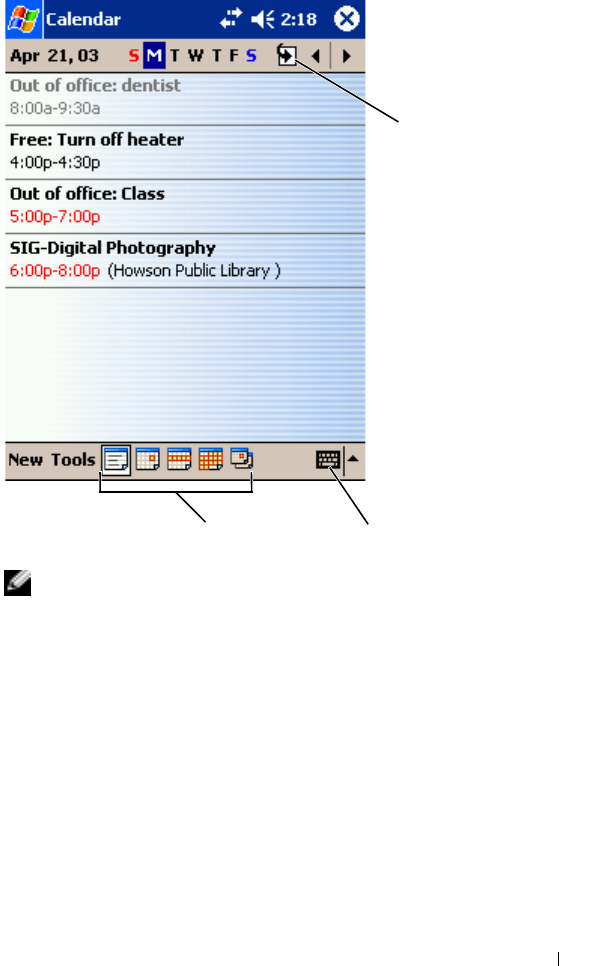
www.dell.com | support.dell.com
Scheduling and Communicating 71
NOTE: To customize Calendar, such as changing the first day of the
week, tap Tools and tap Options.
To create an appointment:
1In the Day or Week view, tap the desired date and time for the
appointment.
2Ta p New.
3Tap a field to select it, and enter a description and a location using
the input panel.
4If necessary, tap the date and time to change them.
today icon
view menu input panel icon

www.dell.com | support.dell.com
72 Scheduling and Communicating
5To see all available fields, tap the input panel icon to hide it. Enter
the remaining information, if necessary.
6To add notes, tap the Notes tab.
You can enter text, draw, or create a recording. For more information
on creating notes, see "Notes" on page 76.
7When you have finished entering information, tap OK to return to
the calendar.
To receive a notification for an appointment, select Remind me in the
appointment settings. You can configure notifications through the
Sounds & Notifications icon. For more information, see "Notifications"
on page 84.
Using the Summary Screen
When you tap an appointment in Calendar, a summary screen displays.
To change the appointment, tap Edit.
Creating Meeting Requests
You can use Calendar to set up meetings with users of Outlook or Pocket
Outlook. The meeting request is automatically created when you
synchronize Inbox or when you connect to your e-mail server. To set how
you want meeting requests sent, tap Tools and tap Options. If you send
and receive e-mail messages through ActiveSync, select ActiveSync.
To schedule a meeting:
1Create an appointment.
2On the Appointment tab, tap the input panel to hide it, and then
tap Attendees.
The Attendees field lists the e-mail addresses that you have entered
in Contacts.
3Select the meeting attendees.
The meeting notice is created automatically and placed in the
Outbox folder.
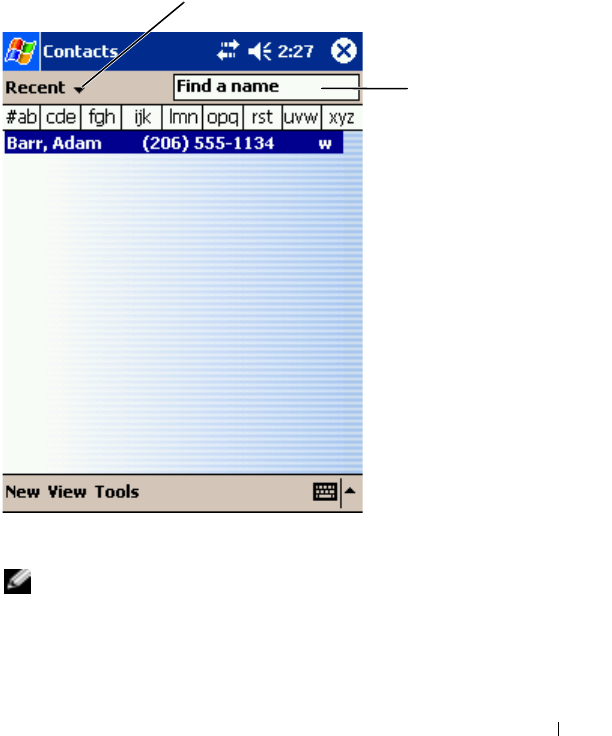
www.dell.com | support.dell.com
Scheduling and Communicating 73
For more information on sending and receiving meeting requests, tap the
Start button, tap Help, and then tap Calendar or Inbox.
Contacts
Use Contacts to maintain a list of your friends and colleagues. You can
quickly share Contacts information with other device users using the
infrared port.
NOTE: To change the way information is displayed in the list, tap
Tools and tap Options.
search field
category

www.dell.com | support.dell.com
74 Scheduling and Communicating
To create a contact:
1Tap the Start button and tap Contacts.
2Ta p New.
3Using the input panel, enter a name and other contact information.
Scroll down to see all available fields.
4To assign the contact to a category, tap Categories and select a
category from the list.
In the contact list, you can display contacts by category.
5To add notes, tap the Notes tab. You can enter text, draw, or create a
recording. For more information on creating notes, see "Notes" on
page 76.
6When you have finished entering information, tap OK to return to
the calendar.
Finding a Contact
You can find a contact using one of the following methods:
• In Contacts, enter a contact name in the field under the navigation
bar. To show all contacts, clear text from the box or tap the arrow to
the right of the box.
• In Contacts, tap the category list (labeled All Contacts by default)
and select a category. To show all contacts again, tap All Contacts.
To view a contact not assigned to a category, select None.
• To view the names of companies your contacts work for, tap View in
the contact list and tap By Company. The number of contacts that
work for that company is displayed to the right of the company
name.
•Tap the Start button, tap Find, and then enter the contact name. In
the Type drop-down menu, tap Contacts, and then tap Go.
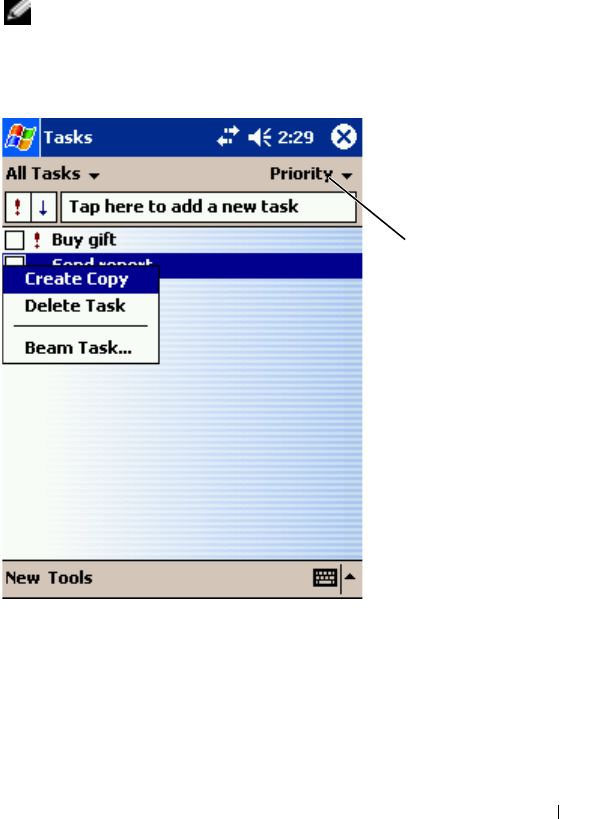
www.dell.com | support.dell.com
Scheduling and Communicating 75
Using the Summary Screen
When you tap a contact in the contact list, a summary screen is displayed.
To change the contact information, tap Edit.
Tasks
NOTE: To change the way information is displayed in the list, tap
Tools and tap Options.
Use Tasks to keep a list of things that you need to do.
sort menu

www.dell.com | support.dell.com
76 Scheduling and Communicating
To create a task:
1Tap the Start button and tap Tasks.
2Ta p New.
3Enter a description using the input panel.
4If necessary, enter a start date and due date or other information by
first tapping the field. Tap the input panel icon to hide it to see all
available fields.
5To assign the task to a category, tap Categories and select a category
from the list. In the task list, you can display tasks by category.
6To add notes, tap the Notes tab. You can enter text, draw, or create a
recording. For more information on creating notes, see "Notes" on
page 76.
7When you have finished entering information, tap OK to return to
the calendar.
NOTE: To quickly create a task with only a subject, tap Tools and tap
Entry Bar. Tap Tap here to add a new task, and enter your task
information.
Notes
Quickly capture thoughts, reminders, ideas, drawings, and phone numbers
with Notes. You can create a written note or a recording. You can also
include a recording in a note. If a note is open when you create the
recording, it is included in the note as an icon. If a note is not open, the
recording is saved as a stand-alone recording.
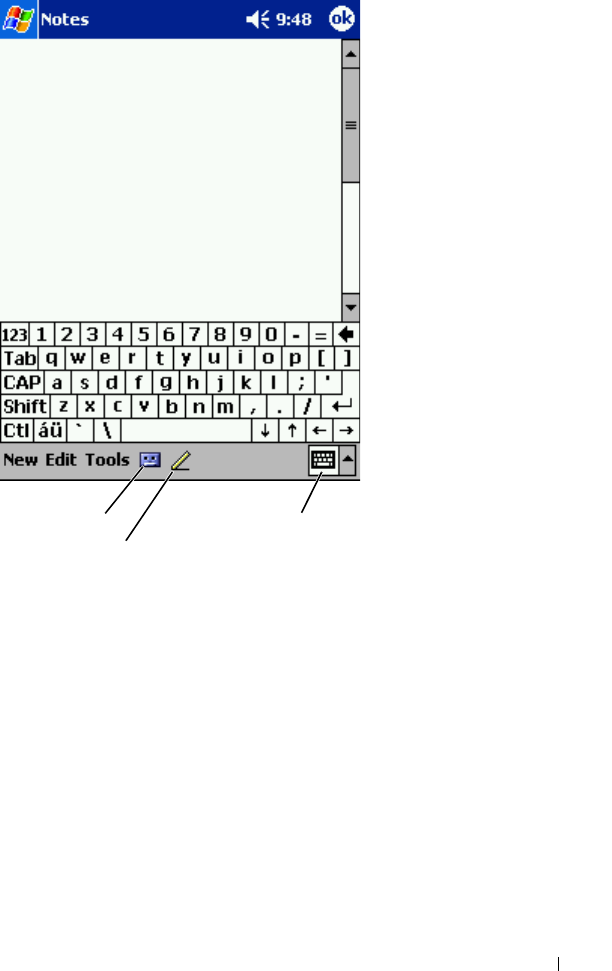
www.dell.com | support.dell.com
Scheduling and Communicating 77
To create a note:
1Tap the Start menu and tap Notes.
2Ta p New.
3Create your note by writing, drawing, typing, or recording. For more
information on using the input panel, writing and drawing on the
screen, and creating recordings, see "Entering Information" on
page 47.
record icon
pen icon input panel icon

www.dell.com | support.dell.com
78 Scheduling and Communicating
Inbox
Use Inbox to send and receive e-mail messages:
• Synchronize e-mail messages using Exchange or Outlook on your
computer.
• Send and receive e-mail messages by connecting directly to an e-mail
server through an ISP or a network.
Synchronizing E-Mail Messages
You can synchronize e-mail messages along with the rest of your data if
you enable Inbox synchronization in ActiveSync. For information on
enabling Inbox synchronization, see ActiveSync Help on your computer.
NOTE: You can also synchronize e-mail messages with your
computer from a remote location. For more information, see "Getting
Connected" on page 113.
During synchronization:
• Messages are copied from the e-mail folders of Exchange or Outlook
on your computer to the ActiveSync folder in Inbox on your device.
By default, you receive:
– Messages from the past 3 days
– The first 100 lines of each message
– File attachments of less than 100 KB in size
•E-mail messages in the Outbox folder on your device are transferred
to Exchange or Outlook on your computer, and then sent from those
programs.
• E-mail messages in subfolders on your computer must be selected in
ActiveSync to be transferred.

www.dell.com | support.dell.com
Scheduling and Communicating 79
Connecting Directly to an E-Mail Server
In addition to synchronizing e-mail messages with your computer, you can
send and receive e-mail messages by connecting to an e-mail server using a
modem or network card connected to your device. You need to set up a
remote connection to a network or an ISP, and a connection to your e-mail
server. For more information, see "Getting Connected" on page 113.
When you connect to the e-mail server:
• New messages are downloaded to the device Inbox folder.
• Messages in the device Outbox folder are sent.
• Messages that have been deleted on the e-mail server are removed
from the device Inbox folder.
Messages that you receive directly from an e-mail server are linked to your
e-mail server rather than to your computer. When you delete a message on
your device, it is also deleted from the e-mail server the next time you
connect depending on the settings you selected in ActiveSync.
When you are working online, you read and respond to messages while
connected to the e-mail server. Messages are sent as soon as you tap Send,
which saves space on your device.
After you have downloaded new message headers or partial messages, you
can disconnect from the e-mail server and then decide which messages to
download completely. The next time you connect, Inbox downloads the
messages you have marked for retrieval and sends the messages you have
composed.
Using the Message List
Messages you receive are displayed in the message list. By default, the
most recently received messages are displayed first in the list.
When you receive a message, tap to open it. Unread messages are
displayed in bold.
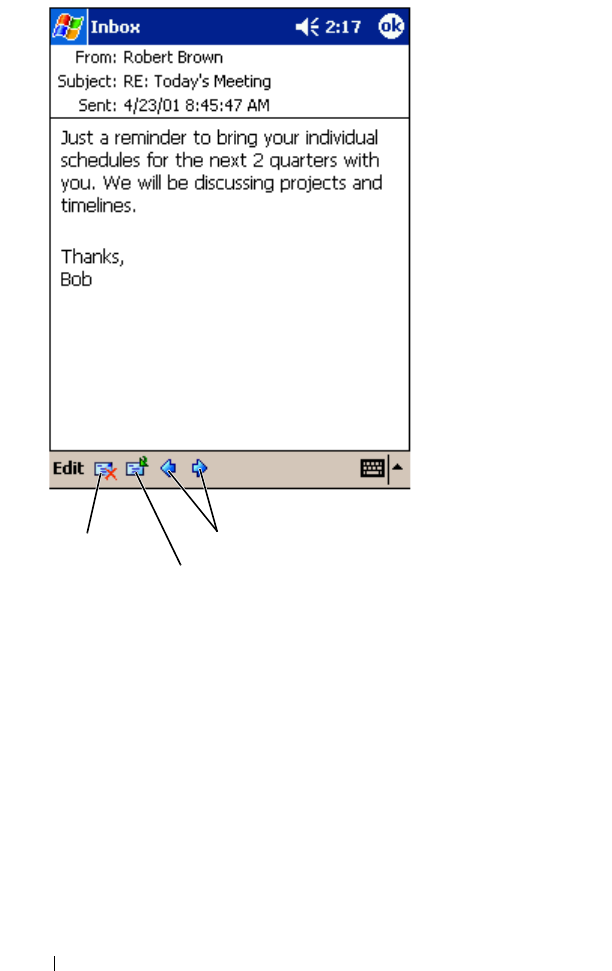
www.dell.com | support.dell.com
80 Scheduling and Communicating
When you connect to your e-mail server or synchronize with your
computer, you receive by default:
• Messages from the last 5 days
• The first 100 lines of each new message
• File attachments of less than 100 KB in size
delete icon
forward icon
previous/next message

www.dell.com | support.dell.com
Scheduling and Communicating 81
The original messages remain on the e-mail server or your computer. You
can mark the messages that you want to retrieve in full during your next
synchronization or e-mail server connection. In the message list, tap and
hold the message that you want to retrieve. On the pop-up menu, tap
Mark for Download. The icons in the Inbox message list indicate message
status.
You specify your downloading preferences when you set up the service or
select your synchronization options. You can change the settings at any
time:
• Change options for Inbox synchronization using ActiveSync options.
For more information, see ActiveSync Help on your computer.
• Change options for direct e-mail server connections in Inbox on your
device. Tap Tools and tap Options. On the Service tab, tap the
service that you want to change. Tap and hold the service and select
Delete to remove a service.
Composing Messages
To compose a message:
1Tap the Start button and tap Inbox.
2Ta p New.
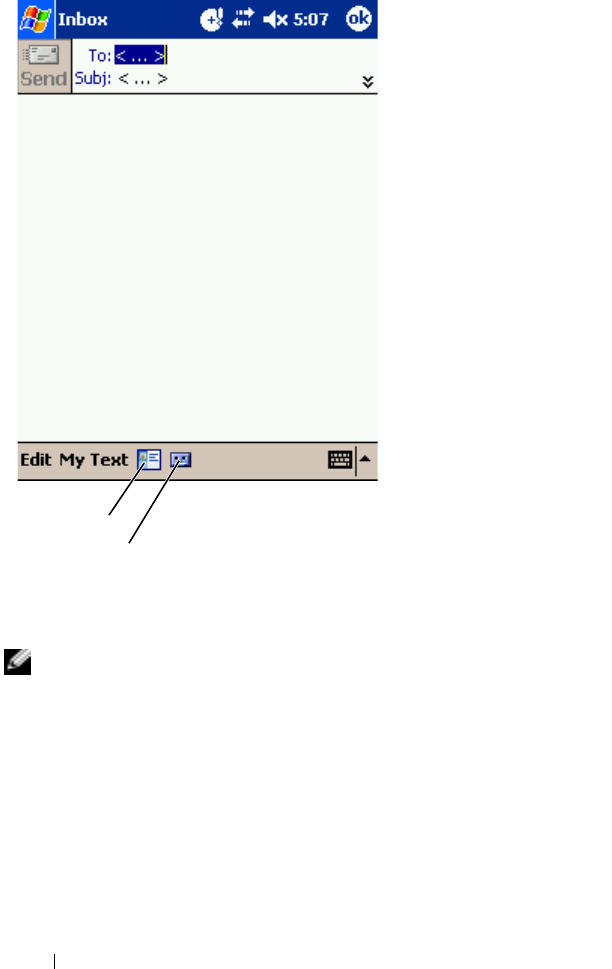
www.dell.com | support.dell.com
82 Scheduling and Communicating
3In the To field, enter an e-mail of one or more recipients, separating
them with a semicolon. Or tap the Contacts icon to select names
from the contact list.
NOTE: All e-mail addresses entered in the e-mail fields in Contacts
appear in the Address Book.
4Compose your message. To enter preset or frequently used messages,
tap My Text and select a message.
Contacts icon
record icon

www.dell.com | support.dell.com
Scheduling and Communicating 83
5Ta p Send when you have finished the message.
If you are working offline, the message is moved to the Outbox folder
and sent the next time you connect.
Managing E-Mail Messages and Folders
By default, messages are displayed in one of five folders for each service
you have created: Inbox, Deleted Items, Drafts, Outbox, or Sent Items.
The Deleted Items folder contains messages that have been deleted on
the device. The behavior of the Deleted Items and Sent Items folders
depends on the options you have selected.To change the options, tap
Tools in the message list and tap Options. On the Message tab, select
your options.
To create a new folder, tap Tools, and tap Manage Folders. To move a
message to another folder, tap and hold the message in the message list
and tap Move to on the pop-up menu.
Folder Behavior With a Direct Connection to an E-Mail Server
The behavior of the folders you create depends on whether you use
ActiveSync, POP3, or IMAP4.
•If you use ActiveSync, e-mail messages in the Inbox folder in Outlook
are automatically synchronized with your device. You can select to
synchronize additional folders by designating them for ActiveSync.
The folders you create and the messages you move are then mirrored
on the server. For example, if you move messages from the Inbox
folder to a folder named Family, and you have designated Family for
synchronization, the server creates a copy of the Family folder and
copies the messages into that folder. You can then read the messages
while away from your computer.

www.dell.com | support.dell.com
84 Scheduling and Communicating
•If you use POP3 and you move e-mail messages to a folder you created,
the link is broken between the messages on the device and their
copies on the e-mail server. The next time you connect, the e-mail
server detects that the messages are missing from the device Inbox
and deletes them from the server. This prevents you from having
duplicate copies of a message. However, you no longer have access to
messages that you move to folders created from anywhere except the
device.
•If you use IMAP4, the folders you create and the e-mail messages you
move are mirrored on the server. Therefore, messages are available to
you any time you connect to your e-mail server, whether it is from
your device or computer. This synchronization of folders occurs
whenever you connect to the server, create new folders, or
rename/delete folders when connected.
Notifications
You can set your device to remind you when you have something to do.
For example, if you have set up an appointment in Calendar, a task with a
due date in Tasks, or an alarm in Clock, you are notified in one of the
following ways:
• A message box appears on the screen.
• A sound, which you can specify, is played.
• A light flashes on your device.
To configure the reminders and sounds for your device:
1Tap the Start button and tap Settings.
2On the Personal tab, tap Sounds & Notifications.
•Volume tab — Adjust the volume and enable sounds.
•Notifications tab — Set notifications for specific events.

7
SECTION 7
Adding and
Removing Programs
Adding Programs Using Microsoft® ActiveSync®
Downloading Programs From the Internet
Adding a Program to the Start Menu
Removing Programs

www.dell.com | support.dell.com
86 Adding and Removing Programs
Programs that were already installed when you received your device are
stored in ROM. You cannot remove these programs, and you never
accidentally lose ROM contents. ROM programs can be updated using
installation programs with the *.xip extension. You can save data to either
ROM or RAM.
You can install any program created for your device as long as your device
has sufficient memory. The most popular place to find software for your
device is on the Microsoft Pocket PC website:
www.microsoft.com/mobile/pocketpc.
Adding Programs Using Microsoft®
ActiveSync®
You need to install the appropriate software for your device on your
computer before installing software on your device. See "Using Microsoft®
ActiveSync®" on page 65 for more information.
1Determine your device and processor type so that you know which
version of the software to install:
aTap the Start button and tap Settings.
bOn the System tab, tap About.
cFrom the Version tab, record the processor information.
2Download the software to your computer (or insert the CD or floppy
disk that contains the software into your computer). You may see a
single *.xip, *.exe, or *.zip file, a Setup.exe file, or several versions of
files for different device types and processors. Ensure that you select
the program designed for the Pocket PC and your device processor
type.
3Read any installation instructions, readme files, or documentation
that comes with the program. Many programs provide special
installation instructions.
4Connect your device to your computer.

www.dell.com | support.dell.com
Adding and Removing Programs 87
5Double-click the *.exe file.
If the file is an installer file, the installation wizard begins. Follow the
directions on the screen. Once the software has been installed on
your computer, the installer automatically transfers the software to
your device.
If the file is not an installer file, you receive an error message stating
that the program is valid but that it is designed for a different type of
computer. You need to move this file to your device. If you cannot
find any installation instructions for the program in the readme file
or documentation, use ActiveSync Explore to copy the program file
to the Program Files folder on your device. For more information on
copying files using ActiveSync, see ActiveSync Help on your
computer.
To open a program after the installation is complete, tap the Start button,
tap Programs, and then tap the program icon.
Downloading Programs From the
Internet
1Determine your device and processor type so that you know which
version of the software to install:
aTap the Start button and tap Settings.
bOn the System tab, tap About.
cFrom the Version tab, record the processor information.
2Using Pocket Internet Explorer, download the program to your
device. You may see a single *.xip, *.exe or *.zip file, a Setup.exe file,
or several versions of files for different device types and processors.
Ensure that you select the program designed for the Pocket PC and
your device processor type.
3Read any installation instructions, readme files, or documentation
that comes with the program. Many programs provide special
installation instructions.

www.dell.com | support.dell.com
88 Adding and Removing Programs
4Tap the file, such as a *.xip or *.exe file.
The installation wizard begins. Follow the directions on the screen.
Adding a Program to the Start Menu
1Tap the Start button and tap Settings.
2Ta p Menus, tap the Start Menu tab, and then tap the check box for
the program.
If the program is not listed, you can either use File Explorer on the
device to move the program to the Start Menu folder, or use
ActiveSync on the computer to create a shortcut to the program and
place the shortcut in the Start Menu folder.
Using File Explorer on the Device
1Tap the Start button, tap Programs, and tap File Explorer.
2Locate the program. Tap the folder list (labeled My Documents by
default) and then tap My Device to see a list of all folders on the
device.
3Tap and hold the program name and tap Cut on the pop-up menu.
4Open the Start Menu folder located in the Windows® folder.
5Tap and hold a blank area of the window, and tap Paste on the pop-
up menu.
The program now appears on the Start menu. For more information on
using File Explorer, see "Finding and Organizing Information" on page 44.
Using ActiveSync on the Computer
Use Explorer in ActiveSync to explore your device files and locate the
program. Right-click the program and click Create Shortcut. Move the
shortcut to the Start Menu folder in the Windows folder. The shortcut
now appears on the Start menu. For more information, see ActiveSync
Help on your computer.

www.dell.com | support.dell.com
Adding and Removing Programs 89
Removing Programs
1Tap the Start button and tap Settings.
2Tap the System tab and tap Remove Programs.
If the program does not appear in the list of installed programs, use
File Explorer on your device to locate the program.
3Tap and hold the name of the program, and tap Delete on the pop-
up menu.

www.dell.com | support.dell.com
90 Adding and Removing Programs

8
SECTION 8
Using Companion
Programs
Microsoft Pocket Word
Pocket Excel
MSN Messenger
Windows® Media Player for Pocket PC
Microsoft Reader

www.dell.com | support.dell.com
92 Using Companion Programs
The companion programs include Microsoft® Pocket Word, Microsoft
Pocket Excel, Microsoft Money, Windows Media Player for Pocket PC,
and Microsoft Reader.
To switch to a companion program on your device, tap the Start button,
tap Programs, and then tap the program name.
Microsoft Pocket Word
Pocket Word works with Microsoft Word on your computer to give you
easy access to copies of your documents. You can create new documents
on your device, or you can copy documents from your computer to your
device. Synchronize documents between your computer and your device
so that you have the most up-to-date content in both locations.
Use Pocket Word to create documents, such as letters, meeting minutes,
and travel reports. To create a new file:
1Tap the Start button→ Programs→ Pocket Word.
2Ta p New.
A blank document appears. Or, if you selected a template for new
documents in the Options dialog box, the template appears with
appropriate text and formatting already provided.
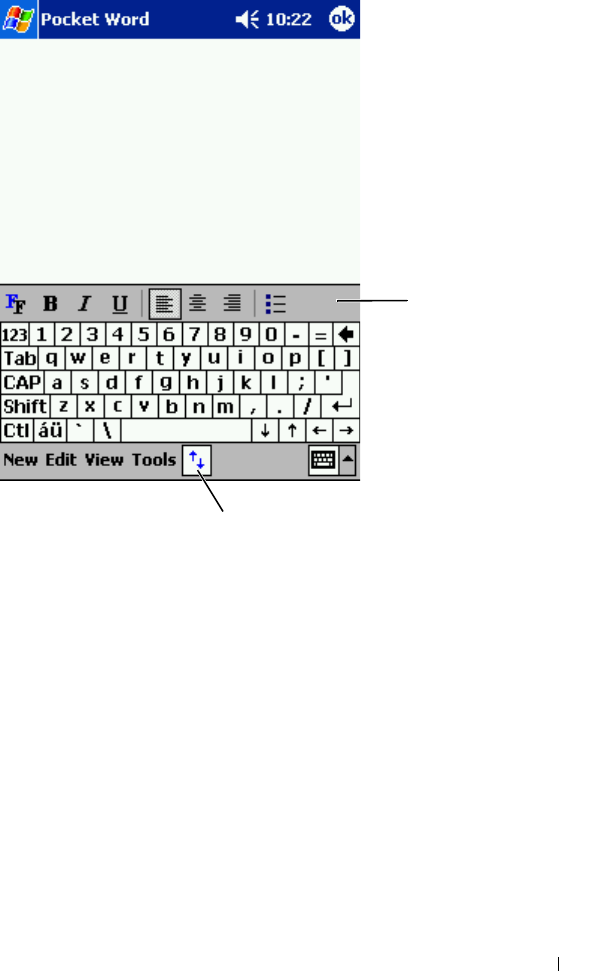
www.dell.com | support.dell.com
Using Companion Programs 93
You can open only one document at a time. If you open a second
document, you are asked to save the first one. You can create, save, or edit
a document in a variety of formats, including Word (.doc), Pocket Word
(.psw), Rich Text Format (.rtf), and Plain Text (.txt).
Pocket Word contains a list of the files stored on your device. Tap a file in
the list to open it. To delete, make copies of, or send files, tap and hold a
file in the list. Then select the appropriate action in the pop-up menu.
formatting
toolbar
show/hide
formatting toolbar

www.dell.com | support.dell.com
94 Using Companion Programs
You can enter information in Pocket Word in one of four modes: typing,
writing, drawing, or recording. These modes are displayed on the View
menu. Each mode has its own toolbar, which you can show and hide by
tapping the Show/Hide Toolbar icon on the command bar.
To change the zoom magnification, tap View, tap Zoom, and then select
the percentage that you want. Select a higher percentage to enter text and
a lower percentage to see more of your document.
If you are opening a Word document created on a computer, select Wrap
to Window on the View menu so that you can see the entire document.
Pocket Excel
Pocket Excel works with Microsoft Excel on your computer to give you
easy access to copies of your workbooks. You can create new workbooks on
your device, or you can copy workbooks from your computer to your
device. Synchronize workbooks between your computer and your device so
that you have the most up-to-date content in both locations.
Use Pocket Excel to create workbooks, such as expense reports and
mileage logs. To create a new file:
1Tap the Start button→ Programs→ Pocket Excel.
2Ta p New.
A blank workbook appears. Or, if you selected a template for new
workbooks in the Options dialog box, the template appears with
appropriate text and formatting already provided.
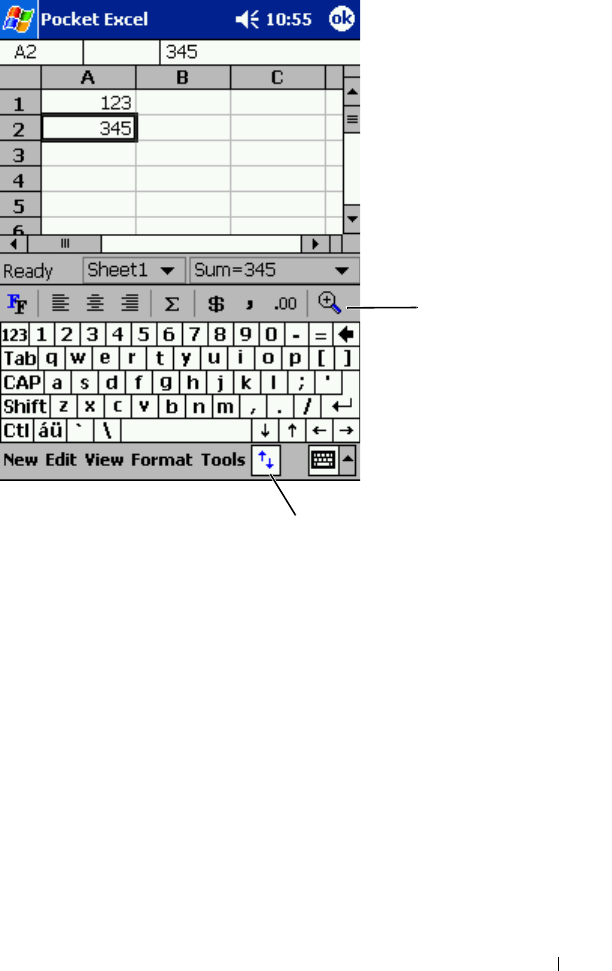
www.dell.com | support.dell.com
Using Companion Programs 95
You can open only one workbook at a time. If you open a second
workbook, you are asked to save the first one. You can create, save, or edit
a workbook in a variety of formats, including Pocket Excel (.pxl) and Excel
(.xls).
Pocket Excel contains a list of the files stored on your device. Tap a file in
the list to open it. To delete, make copies of, or send files, tap and hold a
file in the list. Then select the appropriate action from the pop-up menu.
Pocket Excel provides fundamental spreadsheet tools, such as formulas,
functions, sorting, and filtering. To display the toolbar, tap View and tap
Toolbar.
show/hide
formatting toolbar
formatting
toolbar

www.dell.com | support.dell.com
96 Using Companion Programs
If your workbook contains sensitive information, you can protect it with a
password. To set a password, open the workbook, tap Edit, and then tap
Password. Every time you open the workbook, you need to enter the
password, so choose one that is easy for you to remember but difficult for
others to guess.
Tips for Working in Pocket Excel
Use the following tips when working in large worksheets in Pocket Excel:
•Tap View and tap Full Screen to see as much of your worksheet as
possible. To exit full-screen mode, tap Restore.
• Show and hide window elements. Tap View and then tap the
elements that you want to show or hide.
• Freeze panes on a worksheet. First select the cell where you want to
freeze panes. Tap View and tap Freeze Panes. You might want to
freeze the top and leftmost panes in a worksheet to keep row and
column labels visible as you scroll through a sheet.
• Split panes to view different areas of a large worksheet. Tap View and
tap Split. Drag the split bar to where you want it. To remove the
split, tap View and tap Remove Split.
• Show and hide rows and columns. To hide a row or column, select a
cell in the row or column you want to hide. Tap Format, tap Row or
Column, and then tap Hide. To show a hidden row or column, tap
Tools, tap Go To, and then type a reference that is in the hidden row
or column. Then tap Format, tap Row or Column, and then tap
Unhide.
For more information on using Pocket Excel, tap the Start button and tap
Help.

www.dell.com | support.dell.com
Using Companion Programs 97
MSN Messenger
With the MSN Messenger instant message program, you can:
•See who is online.
• Send and receive instant messages.
• Have instant message conversations with groups of contacts.
To use MSN Messenger, you must have a Microsoft Passport account or a
Microsoft Exchange e-mail account. You must have a Passport to use MSN
Messenger Service. If you have a Hotmail or MSN account, you already
have a Passport. Once you have obtained either a Microsoft Passport or a
Microsoft Exchange account, you are ready to set up your account.
NOTE: Sign up for a Microsoft Passport account at
www.passport.com. Get a free Microsoft Hotmail e-mail address at
www.hotmail.com.
To switch to MSN Messenger, tap the Start button→ Programs→ MSN
Messenger.
Setting Up
Before you can connect, you must enter Passport or Exchange account
information.
To set up an account and sign in:
1Tap the Start button→ Programs→ MSN Messenger.
2Ta p Tools and tap Options.
3On the Accounts tab, enter your Passport or Exchange account
information.
4To sign in, tap the sign-in screen and enter your e-mail address and
password.

www.dell.com | support.dell.com
98 Using Companion Programs
Working With Contacts
The MSN Messenger window shows all of your messenger contacts at a
glance, divided into Online and Not Online categories. From this view,
while connected, you can chat, send an e-mail, block the contact from
chatting with you, or delete contacts from your list using the pop-up
menu.
NOTE: If you already use MSN Messenger on your computer, your
contacts show up on your device without having to be added.
To see others online without them seeing you, tap Tools→ My Status→
Appear Offline.
If you block a contact, you appear offline but remain on the blocked
contact's list. To unblock a contact, tap and hold the contact, and then tap
Unblock on the pop-up menu.
Chatting With Contacts
• Tap a contact name to open a chat window. Enter your message in
the text entry area at the bottom of the screen or tap My Text to
enter a preset message, and then tap Send.
• To invite another contact to a multiuser chat, tap Tools, tap Invite,
and then tap the contact you want to invite.
• To switch back to the main window without closing a chat, tap the
Contacts icon. To revert back to your chat window, tap Chats, and
select the person with whom you were chatting.
• To know if the contact you are chatting with is responding, look for
the message under the text entry area.
For more information on using MSN Messenger, tap the Start button and
tap Help.

www.dell.com | support.dell.com
Using Companion Programs 99
Windows® Media Player for
Pocket PC
Use Windows Media Player for Pocket PC to play digital audio and video
files that are stored on your device or on a network. To switch to Media
Player for Pocket PC, tap the Start button→ Programs→ Windows
Media.
Use Windows Media Player on your computer to copy digital audio and
video files to your Pocket PC. You can play Windows Media and MP3 files
on your Pocket PC.
For more information about using Windows Media Player for Pocket PC,
tap the Start button and tap Help.
Microsoft Reader
Use Reader to read eBooks on your device. Download books to your
computer from your favorite eBook website. Then use ActiveSync to copy
the book files to your activated device. The books appear in the Reader
Library. Tap the name of a book in the list to open it.
With Reader, you can:
• Page through the book by using the up/down control on your device
or by tapping the page number on each page.
• Annotate the book with highlighting, bookmarks, notes, and
drawings.
• Search for text and look up definitions for words.
The Guidebook contains all the information you need to use the software.
To open the Guidebook, tap Help on the Reader command bar. Or, on a
book page, tap and hold the book title, and then tap Help on the pop-up
menu.
To switch to Microsoft Reader, tap the Start button→ Programs→
Microsoft Reader.

www.dell.com | support.dell.com
100 Using Companion Programs
Using the Library
The Library displays a list of all books stored on your device or storage
card. To open the Library:
• On the Reader command bar, tap Library.
• On a book page, tap the book title, and then tap Library on the pop-
up menu.
Reading a Book
Each book consists of a cover page, an optional table of contents, and the
pages of the book. Navigation options are listed at the bottom of the cover
page.
book list
scroll through list
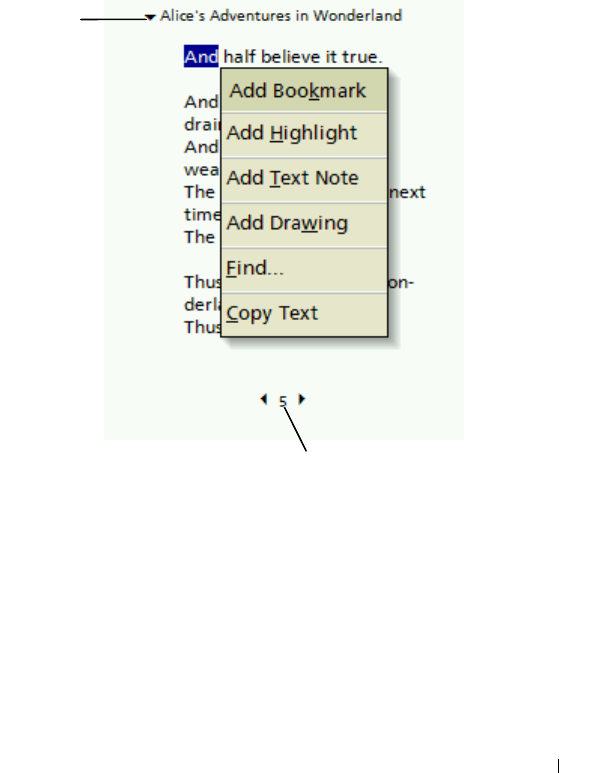
www.dell.com | support.dell.com
Using Companion Programs 101
The first time you open a book, you might want to go to the first page or
to the table of contents, if available. Subsequently, whenever you open the
book, you are automatically taken to the last page read.
In addition to text, each book page includes a page number and book title.
You can also page through a book by using the up/down control on your
device.
Using Reader Features
Reading a book electronically gives you several options not available with
paper books. The options are available from any book page.
previous/next page
navigation
options

www.dell.com | support.dell.com
102 Using Companion Programs
Select text by dragging across the text on the page. Then tap an option on
the pop-up menu:
•Add Bookmark — When you add a bookmark to a book, a color-
coded bookmark icon appears in the right margin. You can add
multiple bookmarks to a book. From anywhere in the book, tap the
bookmark icon to go to the bookmarked page.
•Add Highlight — When you highlight text, it appears with a colored
background.
•Add Text Note — When you attach a note to text, you enter the text
in a note pad that appears on top of the book page. A note icon
displays in the left margin. To show or hide the note, tap the icon.
•Add Drawing — When you add a drawing, a drawing icon appears
on the page. Draw by dragging your stylus.
•Find — Tap Find on the pop-up menu to find text in a book. Enter
the word that you want to search for and tap a Find option. Reader
highlights text found on the page. To close Find, tap outside the box.
To return to your original page, tap the title and tap Return on the
pop-up menu.
•Copy Text — You can copy text from books that support this feature
into any program that accepts text. On a book page, select the text
you want to copy. Then tap Copy Text on the pop-up menu. The text
can be pasted into the program of your choice.
• To see a list of a book's annotations, including bookmarks, highlights,
text notes, and drawings, tap Annotations in the navigation menu.
You can tap an entry in the list to go to the annotated page.

www.dell.com | support.dell.com
Using Companion Programs 103
Removing a Book
When you finish reading a book, you can delete it to conserve space on
your device. If a copy of the book is stored on your computer, you can
download it again at any time.
To remove a book from your device, tap and hold the title in the Library
list, and tap Delete on the pop-up menu.

www.dell.com | support.dell.com
104 Using Companion Programs

9
SECTION 9
Using Microsoft®
Pocket Internet
Explorer
Mobile Favorites
Using AvantGo Channels
Browsing Mobile Favorites and the Web

www.dell.com | support.dell.com
106 Using Microsoft® Pocket Internet Explorer
Use Pocket Internet Explorer to view Web or WAP pages:
• During synchronization with your computer, download your favorite
links and mobile favorites that are stored in the Mobile Favorites
subfolder in Internet Explorer on your computer.
• Connect to an Internet service provider (ISP) or network and browse
the Web. For more information on connecting to the Internet, see
"Getting Connected" on page 113.
When the device is connected to an ISP or network, you can also
download files and programs from the Internet or intranet.
To switch to Pocket Internet Explorer, tap the Start button and tap
Internet Explorer.
Mobile Favorites
If you are using Microsoft Internet Explorer 5.0 or later on your computer,
you can download mobile favorites to your device. Synchronizing mobile
favorites downloads Web content to your device so that you can view
pages while you are disconnected from your ISP and computer. Use the
Internet Explorer plug-in installed with Microsoft ActiveSync® to create
mobile favorites quickly.
To create a mobile favorite on your computer and download it to your
device:
1On your computer, open Internet Explorer and click Tools→ Create
Mobile Favorite.
2To change the link name, enter a new name in the Name box.
3Specify an update schedule next to Update (optional).
4Click OK.
Internet Explorer downloads the latest version of the page to your
computer.

www.dell.com | support.dell.com
Using Microsoft® Pocket Internet Explorer 107
5In Internet Explorer on the computer, right-click the mobile favorite
and click Properties.
6On the Download tab, specify the number of levels deep you want to
download. To conserve device memory, go only one level deep.
7Synchronize your device and computer.
Mobile favorites that are stored in the Mobile Favorites folder in
Internet Explorer are downloaded to your device.
If you did not specify an update schedule in step 3, you need to manually
download content to keep the information updated on your computer and
device. Before synchronizing with your device, click Tools in Internet
Explorer on your computer and click Synchronize. The date in the Last
Updated column was the last time content was downloaded to the
computer. You can manually download content, if necessary.
NOTE: You can add an icon to the Internet Explorer toolbar for
creating mobile favorites. In Internet Explorer on your computer,
click View→Toolbars, and then click Customize.
Conserving Memory
Mobile favorites take up storage memory on your device. To minimize the
amount of memory used:
• Turn off pictures and sounds or stop some mobile favorites from
being downloaded to the device in the Favorites settings in the
ActiveSync options. For more information, see ActiveSync Help on
your computer.
• Limit the number of downloaded linked pages. In Internet Explorer
on the computer, right-click the mobile favorite you want to change
and click Properties. On the Download tab, specify 0 or 1 for the
number of linked pages you want to download.

www.dell.com | support.dell.com
108 Using Microsoft® Pocket Internet Explorer
Mobile Favorites Folder
Only items stored in the Mobile Favorites subfolder (in the Favorites
folder) in Internet Explorer on your computer are synchronized with your
device. The folder was created automatically when you installed
ActiveSync.
Favorite Links
During synchronization, the list of favorites in the Mobile Favorites folder
on your computer is synchronized with Pocket Internet Explorer on your
device. The computer and the device are updated with changes made to
either list each time you synchronize. Unless you mark the favorite link as
a mobile favorite, only the link is downloaded to your device—you need to
connect to your ISP or network to view the content. For more information
on synchronization, see ActiveSync Help on your computer.
Using AvantGo Channels
AvantGo is a free interactive service that gives you access to personalized
content and thousands of popular websites. You subscribe to AvantGo
channels directly from your device. Then synchronize your device and
computer, or connect to the Internet to download the content. For more
information, see the AvantGo website.
To sign up for AvantGo:
1In ActiveSync options on your computer, turn on synchronization for
the AvantGo information type.
2In Pocket Internet Explorer on your device, tap Favorites to display
your list of favorites.
3Tap the AvantGo Channels link.
4Ta p Activate.

www.dell.com | support.dell.com
Using Microsoft® Pocket Internet Explorer 109
5Follow the directions on the screen.
You need to synchronize your device with your computer and then
tap the My Channels to complete the AvantGo setup.
When synchronization is complete, tap the AvantGo Channels link in
your list of favorites to see a few of the most popular channels. To add or
remove channels, tap the Add or Remove link.
Browsing Mobile Favorites and the
Web
You can use Pocket Internet Explorer to browse mobile favorites and
channels that you have downloaded to your device without connecting to
the Internet. You can also connect to the Internet through an ISP or a
network connection and browse the Web.
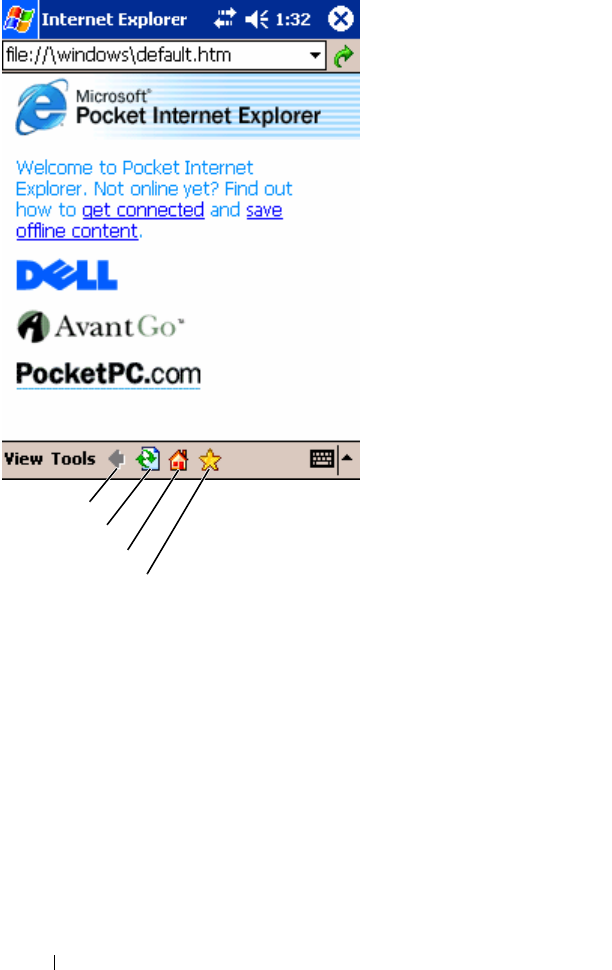
www.dell.com | support.dell.com
110 Using Microsoft® Pocket Internet Explorer
To view mobile favorites and channels:
1Tap the favorites icon to display your list of favorites.
2Tap the page you want to view.
The page that was downloaded the last time you synchronized with your
computer appears. If the page is not on your device, the favorite is
dimmed. You need to synchronize with your computer again to download
the page to your device, or connect to the Internet to view the page.
favorites icon
home icon
refresh icon
back icon

www.dell.com | support.dell.com
Using Microsoft® Pocket Internet Explorer 111
To browse the Internet, set up a connection to your ISP or corporate
network using Connections, as described in "Getting Connected" on
page 113.
NOTE: To add a favorite link, go to the page that you want to add,
tap and hold the page, and then tap Add to Favorites.
To connect and browse the Internet:
• Tap the favorites icon and tap the favorite you want to view.
•Tap View and tap Address Bar. In the address bar that appears at the
top of the screen, enter the Web address that you want to see and tap
Go. Tap the arrow to select previously entered addresses.

www.dell.com | support.dell.com
112 Using Microsoft® Pocket Internet Explorer

10
SECTION 10
Getting Connected
Using Infrared
Using Wi-Fi (802.11b)
Creating a Modem Connection
Creating an Ethernet Connection
Creating a VPN Connection
Ending a Connection
Connecting Directly to an E-Mail Server
Getting Help on Connecting

www.dell.com | support.dell.com
114 Getting Connected
You can use your device to exchange information with other mobile
devices or with a computer, a network, or the Internet. You can use any of
the following connection options:
• Use the infrared (IR) port on your device to send and receive files
between two devices. See the following section, "Using Infrared," for
more information.
• Connect to your Internet service provider (ISP). Once you are
connected, you can send and receive e-mail messages by using Inbox,
and view Web or WAP pages by using Microsoft® Pocket Internet
Explorer. The communication software for creating an ISP
connection is already installed on your device. Your service provider
provides software needed to install other services, such as paging and
fax services.
• Connect to the network at your company or organization where you
work. Once you are connected, you can send and receive e-mail
messages by using Inbox, view Web or WAP pages by using Pocket
Internet Explorer, and synchronize with your computer.
• Connect to your computer to synchronize remotely. Once you are
connected, you can synchronize information such as your Pocket
Outlook information. See Microsoft ActiveSync® Help on your
computer or Connections Help on the device for more information.
Using Infrared
Using infrared, you can send and receive information, such as contacts
and appointments, between two devices.
To send information:
1Switch to the program where you created the item you want to send
and locate the item in the list.
2Align the infrared sensors so that they are unobstructed and within a
close range.
3Tap and hold the item, and tap Beam Item on the pop-up menu.

www.dell.com | support.dell.com
Getting Connected 115
You can also send items (excluding folders) from File Explorer. Tap and
hold the item you want to send, and tap Beam File on the pop-up menu.
Using Wi-Fi (802.11b)
To configure the Wireless Network in a PocketPC environment:
1Tap the Start button→ Settings→ Connections tab.
2To add, edit, or delete a profile, tap Wireless Ethernet.
3On the Configure Wireless Networks screen, select one of the
available network names.
NOTE: If the network name is not listed, you must add a
configuration profile for each wireless network environment in which
you want to use your (mobile) wireless client station. If you plan to
use your wireless client station in multiple networking environments
that require different configuration settings, you can define
dedicated profiles for each environment. For example, you can
create a configuration profile for your office headquarters, a branch
office, and your home or SOHO network.
aIf there are none listed then tap Add New Settings... Type in the
network name. If this will be Peer-to-Peer connection tap the
"This is a device to computer (ad-hoc) connection" check box.
bTap the Authentication tab if your connection does not require
encryption.
• To disable WEP, tap the Data encryption (WEP enabled) check
box.
• If you are using Network Authentication (Shared mode), tap the
check box.
•Tap the The key is provided for me automatically check box.

www.dell.com | support.dell.com
116 Getting Connected
• If you do require encryption and are provided with the key
automatically, the The key is provided for me automatically
check box, when selected, allows you to enter the encryption key
yourself. You can enter key values in either Alphanumeric Value
or Hexadecimal Value. The encryption key value is case-
sensitive. Consult your LAN Administrator for the correct value.
If you are using IEEE 802.1x option you will first need to get a certificate
through a non 802.1x enabled wireless network connected to a certificate
server. Select or configure a non 802.1x enabled wireless network from the
list.
Creating a Modem Connection
1Obtain the following information from your ISP:
– ISP dial-up access telephone number
– Username and password
– TCP/IP settings
Some ISPs require information in front of the username, such as
MSN/username.
2Install a modem card, or use a null modem cable and appropriate
adapters to connect an external modem to your device through the
serial port.
3Tap the Start button→ Settings→ Connections tab→ Connections.
4Under My ISP or My Work Network, tap Add a new modem
connection.
5Enter a name for the connection, such as ISP Connection.
6From the Select a modem list, select your modem type, and tap
Next.
If your modem type does not appear, try reinserting the modem card.
If you are using an external modem that is connected to your device
with a cable, select Hayes Compatible on COM1.

www.dell.com | support.dell.com
Getting Connected 117
7Enter the access phone number and tap Next.
8Enter your user name, password, and, if applicable, your domain.
NOTE: You should not need to change any settings in Advanced.
Most ISPs now use a dynamically assigned address.
9If the ISP you are connecting to does not use a dynamically assigned
address, tap Advanced, tap the TCP/IP tab, and then enter the
address.
10 Ta p Next.
11 Select other appropriate options and tap Finish.
When you open Inbox, Pocket Internet Explorer, or MSN Messenger, your
device automatically connects. Once you are connected, you can:
• Send and receive e-mail messages using Inbox. Before you can use
Inbox, you need to provide the information Inbox needs to
communicate with the e-mail server. See "Connecting Directly to an
E-Mail Server" on page 120 for more information.
• See Web and WAP pages using Pocket Internet Explorer. For more
information, see "Using Microsoft® Pocket Internet Explorer" on
page 105.
• Send and receive instant messages with MSN Messenger. For more
information, see "MSN Messenger" on page 97.
Creating an Ethernet Connection
1Install the network card driver, if required.
See the documentation that came with your network card.
2Insert the network card into your device.
• If a network with a broadcast SSID is detected, the wireless
network icon, , and the New Network Detected bubble
appear in the navigation bar. Go to step 3.
• If a network with a broadcast SSID is not detected, skip to
step 4.

www.dell.com | support.dell.com
118 Getting Connected
3Ta p The Internet or Work, depending to which type of network you
are connecting. Your device automatically connects to the network.
NOTE: If multiple networks are detected, tap the network to which
you want to connect, tap The Internet or Work, and tap Connect.
4Tap the Start button→ Settings→ Connections tab→ Connections.
5Tap the Wireless Ethernet icon.
6On the Wireless tab, tap New Settings.
7Enter the SSID next to Network Name, and select whether the
network connects to the Internet or work.
8Tap the Authentication tab to enable or disable WEP settings,
depending on your network type.
9Ta p OK.
When your device successfully connects to the network, your
connection status appears under Wireless Networks.
Creating a VPN Connection
1Tap the Start button→ Settings→ Connections tab→ Connections.
2Ta p Add a new VPN server connection.
3Enter a name for the connection, such as your company's name.
4In the Host name/IP field, enter the VPN server name or IP address.
5Next to VPN type, tap IPSec or PPTP, depending on the type of
authentication that you want to use with your device.
If you are unsure about which option to select, ask your network
administrator.
6Ta p Next.
7Enter your username, password, and, if required, domain.
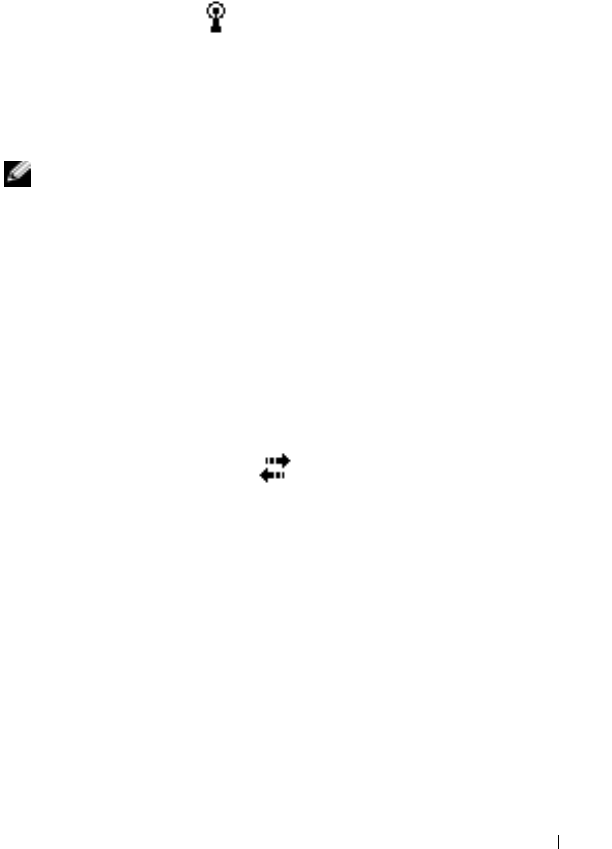
www.dell.com | support.dell.com
Getting Connected 119
8Install the network card driver, if required.
See the documentation that came with your network card.
9Insert the network card into your device.
• If a network with a broadcast SSID is detected, the wireless
network icon, , and the New Network Detected bubble
appear in the navigation bar. Go to step 10.
• If a network with a broadcast SSID is not detected, skip to
step 11.
10 Ta p The Internet.
NOTE: If multiple networks are detected, tap the network to which
you want to connect, tap The Internet, and tap Connect.
11 Tap the Start button→ Settings→ Connections tab→ Connections.
12 Tap the Wireless Ethernet icon.
13 On the Wireless tab, tap New Settings.
14 Enter the SSID next to Network Name, and tap The Internet.
15 Tap the Authentication tab to enable or disable WEP settings,
depending on your network type.
16 Ta p OK.
17 Tap the connection icon, , that appears in the navigation bar.
18 Tap the name of your VPN connection to enable it.
Ending a Connection
To disconnect:
• When connected through dial-up or VPN, tap the Connection icon
on your navigation bar and tap End.
• When connected through a cable or cradle, detach your device from
the cable or cradle.

www.dell.com | support.dell.com
120 Getting Connected
• When connected through the infrared sensor, move the device away
from the computer.
• When connected through a network (Ethernet) card, remove the
card from your device.
Connecting Directly to an E-Mail
Server
You can set up a connection to an e-mail server so that you can send and
receive e-mail messages by using a modem or network connection and
Inbox on your device.
NOTE: The ISP or network must use a POP3 or IMAP4 e-mail
server and an SMTP gateway.
You can use multiple e-mail services to receive your messages. For each
e-mail service you intend to use, you must first set up and name the
e-mail service. If you use the same service to connect to different
mailboxes, set up and name each mailbox connection.
To set up an e-mail service:
1In Inbox on your device, tap Accounts and tap New Account.
2Follow the directions in the E-mail Setup wizard.
For more information, tap the Start button and tap Help.
To connect to your e-mail server, tap Services and tap Connect. For more
information on using the Inbox program, see "Inbox" on page 78.
Getting Help on Connecting
For more information on getting connected, see the following resources:
• "Inbox" on page 78.
• Online Help on the device. Tap the Start button and tap Help. Tap
View, tap All Installed Help, and then tap Inbox or Connections.

www.dell.com | support.dell.com
Getting Connected 121
• ActiveSync Help on your computer. In ActiveSync, click Help and
click Microsoft ActiveSync Help.
•See www.microsoft.com/mobile/pocketpc for troubleshooting
information.

www.dell.com | support.dell.com
122 Getting Connected

11
SECTION 11
Appendix
Specifications
Regulatory Notices
Contacting Dell

www.dell.com | support.dell.com
124 Appendix
Specifications
System Information
Processor Intel® XScale™ processor at
400 or 300 MHz
Memory
RAM 64- or 32-MB SDRAM
ROM 64- or 32-MB Intel® StrataFlash™ ROM
Operating System Microsoft® Pocket PC 2003 Premium
Display
Type QVGA TFT Color 16-bit, touch-
sensitive transflective display
Size 3.5 inches
Resolution 240 x 320 at 65,536 colors
Controls and Lights
Navigation 5-way navigation button
Scroll Dial up, down, action
Buttons: four program buttons: Calendar,
Contacts, Inbox, Home
power on/off
wireless on/off
voice record button
reset button
Lights: synchronization/communication
event notification
charge status

www.dell.com | support.dell.com
Appendix 125
Expansion Slots
Secure Digital one Secure Digital card slot (3.3v)
Ports and Connectors
Infrared standard v1.2 (115 kbps)
Power DC power in
Cradle/synchronization connector 26-pin connector
Audio stereo headphone connector
Physical
Dimensions:
Length 117.0 mm (4.6 inches)
Width 76.0 mm (3.21 inches)
Height 14.8 mm (0.58 inches)
Weight 138 g (0.30 lb) (with standard battery)
Audio
Audio controller AC-97 Codec chip; WM9705 sound
chip
Stereo conversion 16-bit stereo; 8.0, 11.025, 22.05 and
44.1KHz sample rate
Record full duplex record and playback
Microphone/speaker integrated
Headphone stereo connector

www.dell.com | support.dell.com
126 Appendix
Power Supply
Battery type:
Main 950-mAh lithium-ion removable,
rechargeable battery (standard)
1800-mAh lithium-ion removable,
rechargeable battery (optional)
Backup CR2032 lithium battery
AC adapter:
Supply voltage 100–240 VAC
Frequency 50–60 Hz
Current consumption 0.4 A
Output voltage 5.4 VDC
Output current 2.41 A
Environmental
Temperature range:
operating 0° to 40°C (32° to 104°F)
storage –20° to 60°C (–4° to 140°F)
Thermal gradient:
operating 15°C (59°F) per hour maximum
storage 20°C (68°F) per hour maximum
Relative humidity (maximum):
operating 10% to 90% non-condensing
storage 5% to 95% non-condensing
Altitude (maximum):
operating 0 to 3048 m (0 to 10,000 ft)
storage 0 to 12,190 m (0 to 40,000 ft)

www.dell.com | support.dell.com
Appendix 127
Regulatory Notices
Electromagnetic Interference (EMI) is any signal or emission, radiated in
free space or conducted along power or signal leads, that endangers the
functioning of a radio navigation or other safety service or seriously
degrades, obstructs, or repeatedly interrupts a licensed radio
communications service. Radio communications services include but are
not limited to AM/FM commercial broadcast, television, cellular services,
radar, air-traffic control, pager, and Personal Communication Services
(PCS). These licensed services, along with unintentional radiators such as
digital devices, including computers, contribute to the electromagnetic
environment.
Electromagnetic Compatibility (EMC) is the ability of items of electronic
equipment to function properly together in the electronic environment.
While this computer has been designed and determined to be compliant
with regulatory agency limits for EMI, there is no guarantee that
interference will not occur in a particular installation. If this equipment
does cause interference with radio communications services, which can be
determined by turning the equipment off and on, you are encouraged to
try to correct the interference by one or more of the following measures:
• Reorient the receiving antenna.
• Relocate the computer with respect to the receiver.
• Move the computer away from the receiver.
Maximum shock:
operating 200 G
storage 400 G
Maximum vibration:
operating 2.6 GRMS
storage 3.41 GRMS
Environmental
(continued)

www.dell.com | support.dell.com
128 Appendix
• Plug the computer into a different outlet so that the computer and
the receiver are on different branch circuits.
If necessary, consult a Dell Technical Support representative or an
experienced radio/television technician for additional suggestions.
Dell™ computers are designed, tested, and classified for their intended
electromagnetic environment. These electromagnetic environment
classifications generally refer to the following harmonized definitions:
• Class A is typically for business or industrial environments.
• Class B is typically for residential environments.
Information Technology Equipment (ITE), including devices, expansion
cards, printers, input/output (I/O) devices, monitors, and so on, that are
integrated into or connected to the computer should match the
electromagnetic environment classification of the computer.
A Notice About Shielded Signal Cables: Use only shielded cables for
connecting devices to any Dell device to reduce the possibility of
interference with radio communications services. Using shielded cables
ensures that you maintain the appropriate EMC classification for the
intended environment. For parallel printers, a cable is available from
Dell. If you prefer, you can order a cable from Dell on the World Wide
Web at accessories.us.dell.com/sna/category.asp?category_id=4117.
Most Dell computers are classified for Class B environments. However,
the inclusion of certain options can change the rating of some
configurations to Class A. To determine the electromagnetic classification
for your computer or device, see the following sections specific for each
regulatory agency. Each section provides country-specific EMC/EMI or
product safety information.

www.dell.com | support.dell.com
Appendix 129
FCC Notices (U.S. Only)
Most Dell computers are classified by the Federal Communications
Commission (FCC) as Class B digital devices. To determine which
classification applies to your computer, examine all FCC registration
labels located on the bottom, side, or back panel of your computer, on
card-mounting brackets, and on the cards themselves. If any one of the
labels carries a Class A rating, your entire computer is considered to be a
Class A digital device. If all labels carry an FCC Class B rating as
distinguished by either an FCC ID number or the FCC logo, ( ), your
computer is considered to be a Class B digital device.
Once you have determined your computer’s FCC classification, read the
appropriate FCC notice. Note that FCC regulations provide that changes
or modifications not expressly approved by Dell could void your authority
to operate this equipment.
This device complies with Part 15 of the FCC Rules. Operation is subject
to the following two conditions:
• This device may not cause harmful interference.
• This device must accept any interference received, including
interference that may cause undesired operation.
Class B
This equipment has been tested and found to comply with the limits for a
Class B digital device pursuant to Part 15 of the FCC Rules. These limits
are designed to provide reasonable protection against harmful interference
in a residential installation. This equipment generates, uses, and can
radiate radio frequency energy and, if not installed and used in accordance
with the manufacturer’s instruction manual, may cause interference with
radio communications. However, there is no guarantee that interference
will not occur in a particular installation. If this equipment does cause

www.dell.com | support.dell.com
130 Appendix
harmful interference to radio or television reception, which can be
determined by turning the equipment off and on, you are encouraged to
try to correct the interference by one or more of the following measures:
• Reorient or relocate the receiving antenna.
• Increase the separation between the equipment and the receiver.
• Connect the equipment into an outlet on a circuit different from
that to which the receiver is connected.
• Consult the dealer or an experienced radio/television technician for
help.
FCC Identification Information
The following information is provided on the device or devices covered in
this document in compliance with FCC regulations:
• Model number: HC02U
• Company name:
Dell Inc.
One Dell Way
Round Rock, Texas 78682 USA
512-338-4400
IC Notice (Canada Only)
Most Dell computers (and other Dell digital apparatus) are classified by
the Industry Canada (IC) Interference-Causing Equipment Standard #3
(ICES-003) as Class B digital devices. To determine which classification
(Class A or B) applies to your computer (or other Dell digital apparatus),
examine all registration labels located on the bottom, side, or the back
panel of your computer (or other digital apparatus). A statement in the
form of "IC Class A ICES-003" or "IC Class B ICES-003" will be located
on one of these labels. Note that Industry Canada regulations provide that
changes or modifications not expressly approved by Dell could void your
authority to operate this equipment.

www.dell.com | support.dell.com
Appendix 131
CE Notice (European Union)
Marking by the symbol indicates compliance of this Dell computer to
the EMC Directive and the Low Voltage Directive of the European
Union. Such marking is indicative that this Dell system meets the
following technical standards:
• EN 55022 — "Information Technology Equipment — Radio
Disturbance Characteristics — Limits and Methods of
Measurement."
• EN 55024 — "Information Technology Equipment - Immunity
Characteristics - Limits and Methods of Measurement."
• EN 61000-3-2 — "Electromagnetic Compatibility (EMC) - Part 3:
Limits - Section 2: Limits for Harmonic Current Emissions
(Equipment Input Current Up to and Including 16 A Per Phase)."
• EN 61000-3-3 — "Electromagnetic Compatibility (EMC) - Part 3:
Limits - Section 3: Limitation of Voltage Fluctuations and Flicker in
Low-Voltage Supply Systems for Equipment With Rated Current Up
to and Including 16 A."
• EN 60950 — "Safety of Information Technology Equipment."
NOTE: EN 55022 emissions requirements provide for two classifications:
• Class A is for typical commercial areas.
• Class B is for typical domestic areas.
This Class B (or Class A, if so indicated on the registration label) digital
apparatus meets the requirements of the Canadian Interference-
Causing Equipment Regulations.
Cet appareil numérique de la Classe B (ou Classe A, si ainsi indiqué sur
l’étiquette d’enregistration) respecte toutes les exigences du Reglement
sur le Materiel Brouilleur du Canada.
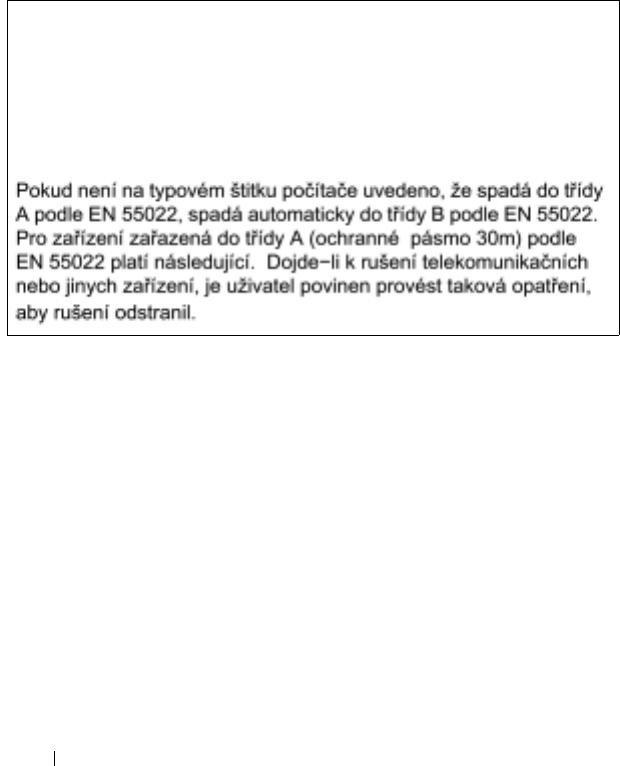
www.dell.com | support.dell.com
132 Appendix
This Dell device is classified for use in a typical Class B domestic
environment.
A "Declaration of Conformity" in accordance with the preceding directives
and standards has been made and is on file at Dell Inc. Products Europe
BV, Limerick, Ireland.
EN 55022 Compliance (Czech Republic Only)
VCCI Notice (Japan Only)
Most Dell computers are classified by the Voluntary Control Council for
Interference (VCCI) as Class B information technology equipment (ITE).
However, the inclusion of certain options can change the rating of some
configurations to Class A. ITE, including devices, expansion cards,
printers, input/output (I/O) devices, monitors, and so on, integrated into
or connected to the computer should match the electromagnetic
environment classification (Class A or B) of the computer.
This device belongs to Class B devices as described in EN 55022, unless
it is specifically stated that it is a Class A device on the specification
label. The following applies to devices in Class A of EN 55022 (radius of
protection up to 30 meters). The user of the device is obliged to take all
steps necessary to remove sources of interference to telecommunication
or other devices.
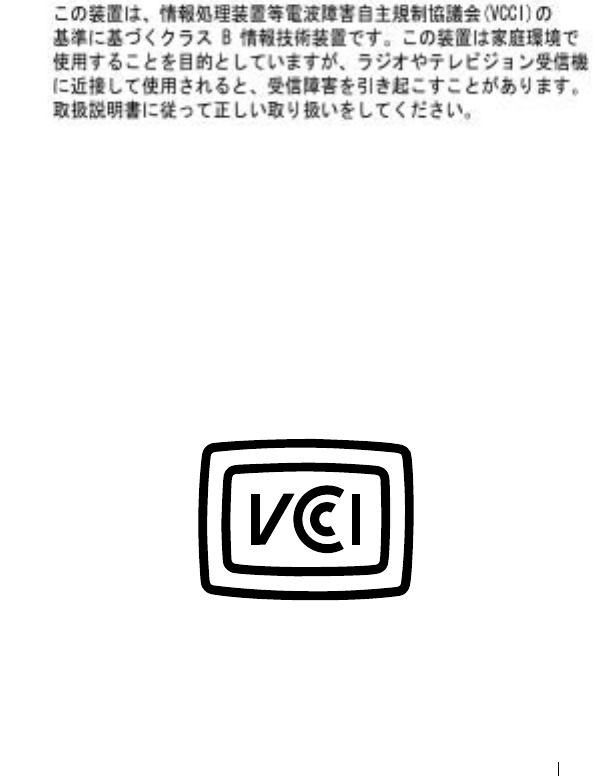
www.dell.com | support.dell.com
Appendix 133
To determine which classification applies to your computer, examine the
regulatory labels/markings (see "VCCI Class A ITE Regulatory Mark" and
"VCCI Class B ITE Regulatory Mark") located on the bottom, side, or
back panel of your computer. Once you have determined your computer’s
VCCI classification, read the appropriate VCCI notice.
Class B ITE
This is a Class B product based on the standard of the Voluntary Control
Council for Interference (VCCI) for information technology equipment.
If this equipment is used near a radio or television receiver in a domestic
environment, it may cause radio interference. Install and use the
equipment according to the instruction manual.
VCCI Class B ITE Regulatory Mark
If the regulatory label includes the following marking, your computer is a
Class B product:
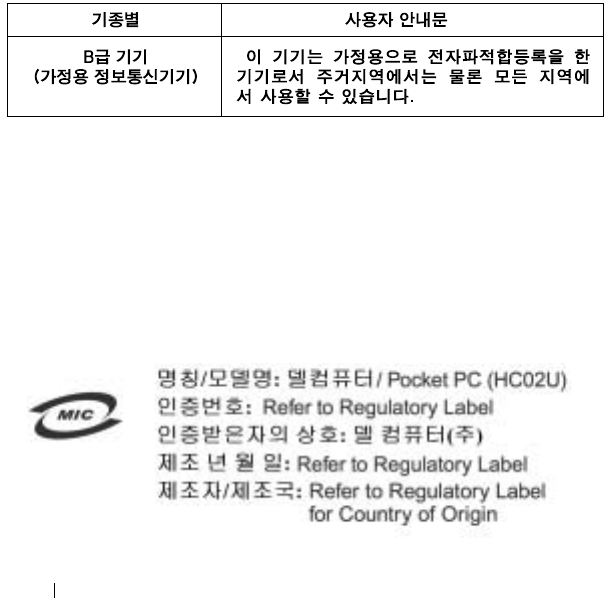
www.dell.com | support.dell.com
134 Appendix
MIC Notice (Republic of Korea Only)
To determine which classification (Class A or B) applies to your computer
(or other Dell digital device), examine the Republic of Korean Ministry of
Information and Communications (MIC) registration labels located on
your computer (or other Dell digital device). The MIC label may be
located separately from the other regulatory marking applied to your
product. Line two of the label identifies the emissions class for the
product—"(A)" for Class A products or "(B)" for Class B products.
NOTE: MIC emissions requirements provide for two classifications:
• Class A devices are for business purposes.
• Class B devices are for nonbusiness purposes.
Class B Device
Please note that this device has been approved for nonbusiness purposes
and may be used in any environment, including residential areas.
MIC Class B Regulatory Label
If the regulatory label includes the following marking, your computer is a
Class B product.

www.dell.com | support.dell.com
Appendix 135
Polish Center for Testing and Certification Notice
The equipment should draw power from a socket with an attached
protection circuit (a 3-prong socket). All equipment that works together
(computer, monitor, printer, and so on) should have the same power
supply source.
The phasing conductor of the room’s electrical installation should have a
reserve short-circuit protection device in the form of a fuse with a nominal
value no larger than 16 amperes (A).
To completely switch off the equipment, the power supply cable must be
removed from the power supply socket, which should be located near the
equipment and easily accessible.
A protection mark "B" confirms that the equipment is in compliance with
the protection usage requirements of standards PN-93/T-42107 and
PN-EN 55022.
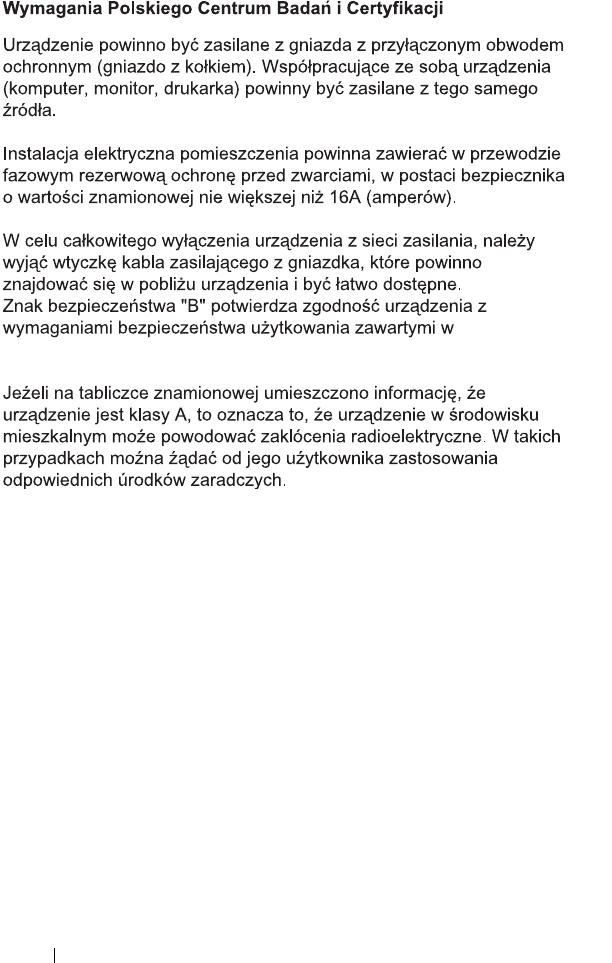
www.dell.com | support.dell.com
136 Appendix
PN–EN 60950:2000 i PN–EN 55022:2000.
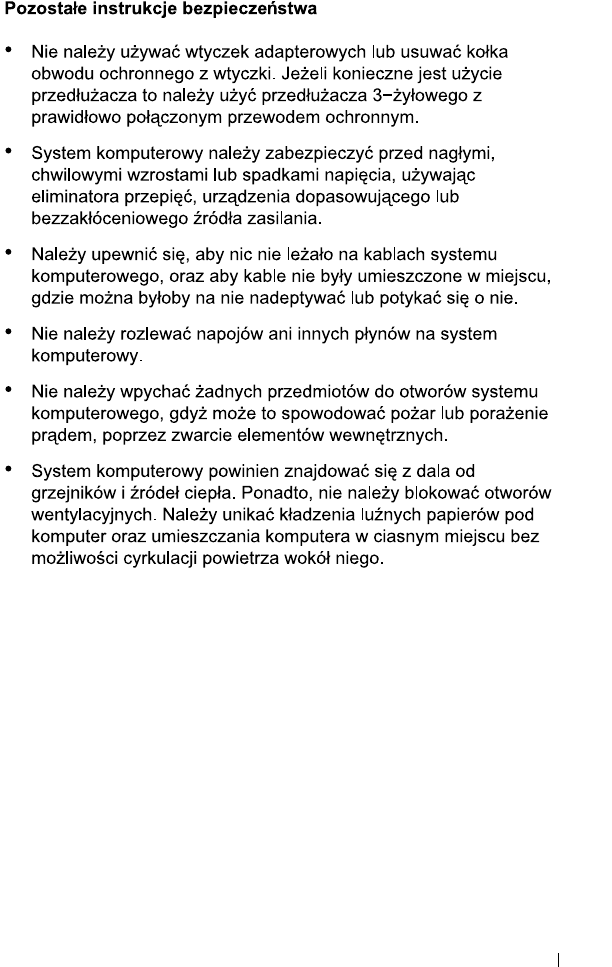
www.dell.com | support.dell.com
Appendix 137
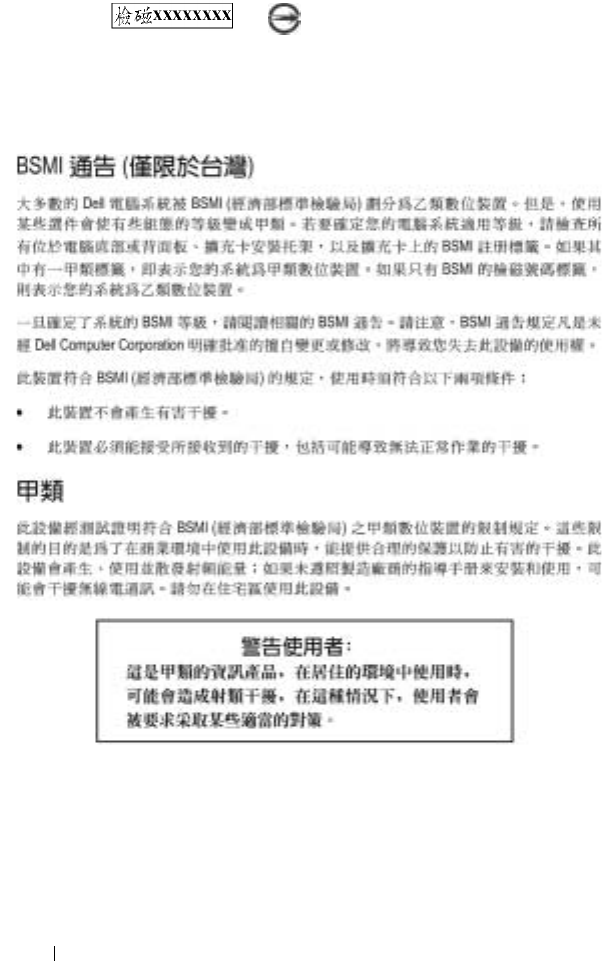
www.dell.com | support.dell.com
138 Appendix
BSMI Notice (Taiwan Only)
If you find a or mark on the regulatory
label on the bottom, side, or back panel of your computer, the following
section is applicable:

www.dell.com | support.dell.com
Appendix 139

www.dell.com | support.dell.com
140 Appendix
NOM Information (Mexico Only)
The following information is provided on the device(s) described in this
document in compliance with the requirements of the official Mexican
standards (NOM):
Wireless Regulatory Information
The Dell™ Axim™ X3 device must be used in strict accordance with the
manufacturer's instructions as described in the user documentation that
comes with the product. For country-specific approvals, see Radio
approvals. Dell Inc. is not responsible for any radio or television
interference caused by unauthorized modification of the device, or the
Exporter: Dell Inc.
One Dell Way
Round Rock, TX 78682
Importer: Dell Computer de México,
S.A. de C.V.
Paseo de la Reforma 2620 - 11° Piso
Col. Lomas Altas
11950 México, D.F.
Ship to: Dell Computer de México,
S.A. de C.V. al Cuidado de Kuehne &
Nagel de México S. de R.I.
Avenida Soles No. 55
Col. Peñon de los Baños
15520 México, D.F.
Model number: HC02U
Supply voltage: 100–240 VAC
Frequency: 50–60 Hz
Current Consumption: 0.4 A
Output voltage: 5.4 VDC
Output current: 2.41 A

www.dell.com | support.dell.com
Appendix 141
substitution or attachment of connecting cables and equipment other
than that specified by Dell Inc. The correction of interference caused by
such unauthorized modification, substitution or attachment is the
responsibility of the user. Dell Inc. and its authorized resellers or
distributors are not liable for any damage or violation of government
regulations that may arise from the user failing to comply with these
guidelines.
Europe—CE Declaration of Conformity
EN 301 489-1(2000-7), EN 301 489-17 (2000-9),EN 300 328-2(2000-7),
EN60950 (06-2000)
English Hereby, Dell Inc. declares that this TM1200 is in
compliance with the essential requirements and other
relevant provisions of Directive 1999/5/EC.
Finnish Dell Inc. vakuuttaa täten että TM1200 tyyppinen laite on
direktiivin 1999/5/EY oleellisten vaatimusten ja sitä
koskevien direktiivin muiden ehtojen mukainen.
Dutch Hierbij verklaart Dell Inc. dat het toestel TM1200 in
overeenstemming is met de essentiële eisen en de andere
relevante bepalingen van richtlijn 1999/5/EG
Bij deze verklaart Dell Inc. dat deze TM1200 voldoet aan
de essentiële eisen en aan de overige relevante bepalingen
van Richtlijn 1999/5/EC.
French Par la présente Dell Inc. déclare que l'appareil TM1200 est
conforme aux exigences essentielles et aux autres
dispositions pertinentes de la directive 1999/5/CE

www.dell.com | support.dell.com
142 Appendix
Par la présente, Dell Inc. déclare que ce TM1200 est
conforme aux exigences essentielles et aux autres
dispositions de la directive 1999/5/CE qui lui sont
applicables
Swedish Härmed intygar Dell Inc. att denna TM1200 står I
överensstämmelse med de väsentliga egenskapskrav och
övriga relevanta bestämmelser som framgår av direktiv
1999/5/EG.
Danish Undertegnede Dell Inc. erklærer herved, at følgende udstyr
TM1200 overholder de væsentlige krav og øvrige relevante
krav i direktiv 1999/5/EF
German Hiermit erklärt Dell Inc., dass sich dieser/diese/dieses
TM1200 in Übereinstimmung mit den grundlegenden
Anforderungen und den anderen relevanten Vorschriften
der Richtlinie 1999/5/EG befindet". (BMWi)
Hiermit erklärt Dell Inc. die Übereinstimmung des Gerätes
TM1200 mit den grundlegenden Anforderungen und den
anderen relevanten Festlegungen der Richtlinie 1999/5/EG.
(Wien)
Greek ΜΕ ΤΗΝ ΠΑΡΟΥΣΑ Dell Inc. ∆ΗΛΩΝΕΙ ΟΤΙ TM1200
ΣΥΜΜΟΡΦΩΝΕΤΑΙ ΠΡΟΣ ΤΙΣ ΟΥΣΙΩ∆ΕΙΣ
ΑΠΑΙΤΗΣΕΙΣ ΚΑΙ ΤΙΣ ΛΟΙΠΕΣ ΣΧΕΤΙΚΕΣ ∆ΙΑΤΑΞΕΙΣ
ΤΗΣ Ο∆ΗΓΙΑΣ 1999/5/ΕΚ
Italian Con la presente Dell Inc. dichiara che questo TM1200 è
conforme ai requisiti essenziali ed alle altre disposizioni
pertinenti stabilite dalla direttiva 1999/5/CE.
Spanish Por medio de la presente Dell Inc. declara que el TM1200
cumple con los requisitos esenciales y cualesquiera otras
disposiciones aplicables o exigibles de la Directiva
1999/5/CE
Portuguese Dell Inc. declara que este TM1200 está conforme com os
requisitos essenciais e outras disposições da Directiva
1999/5/CE.

www.dell.com | support.dell.com
Appendix 143
France
Some areas of France have a restricted frequency band. The worst case
maximum authorised power indoors is:
10 mW for the entire 2.4 GHz band (2400 MHz–2483.5 MHz)
100 mW for frequencies between 2446.5 MHz and 2483.5 MHz
(NOTE—Channels 10 through 13 inclusive operate in the band
2446.6 MHz to 2483.5 MHz)
There are few possibilities for outdoor use: On private property or on the
private property of public persons, use is subject to a preliminary
authorisation procedure by the Ministry of Defence, with maximum
authorised power of 100 mW in the 2446.5–2483.5 MHz band. Use
outdoors on public property is not permitted.
In the departments listed below, for the entire 2.4 GHz band:
Maximum authorized power indoors is 100 mW
Maximum authorized power outdoors is 10 mW
Departments in which the use of the 2400–2483.5 MHz band is permitted
with an EIRP of less than 100 mW indoors and less than 10 mW
outdoors:
01 Ain
Orientales 36 Indre 66 Pyrénées
02 Aisne 37 Indre et Loire 67 Bas Rhin
03 Allier 41 Loir et Cher 68 Haut Rhin
05 Hautes Alpes 42 Loire 70 Haute Saône
08 Ardennes 45 Loiret 71 Saône et Loire
09 Ariège 50 Manche 75 Paris
11 Aude 55 Meuse 82 Tarn et Garonne

www.dell.com | support.dell.com
144 Appendix
This requirement is likely to change over time, allowing to use your
wireless LAN card in more areas within France. Please check with ART for
the latest information (www.art-telecom.fr)
NOTE—Your Dell Axim X3 transmits less than 100 mW, but more than
10 mW.
Japan Standard
STD-33 (Ver5.0), STD-T66 (Ver1.0)
Canada—Industry Canada (IC)
This device complies with RSS210 of Industry Canada. (1999)
FCC Standard
47 CFR Part 15, Subpart C (Section 15.247)
12 Aveyron 58 Nièvre 84 Vaucluse
16 Charente 59 Nord 88 Vosges
24 Dordogne 60 Oise 89 Yonne
25 Doubs 61 Orne 90 Territoire de
Belfort
26 Drôme 63 Puy du Dôme 94 Val de Marne
32 Gers 64 Pyrénées
Atlantique
Italia A license is required for indoor use. Outdoor use is prohibited.
E' necessaria la concessione ministeriale anche per l'uso interno.
Verificare con i rivenditori la procedura da seguire. L'uso per
installazione in esterni non e' permessa.

www.dell.com | support.dell.com
Appendix 145
Federal Communications Commission (FCC)
This device complies with Part 15 of the FCC Rules. Operation of the
device is subject to the following two conditions:
• This device may not cause harmful interference.
• This device must accept any interference that may cause undesired
operation.
NOTE—The radiated output power of this Dell Axim X3 device is far
below the FCC radio frequency exposure limits. Nevertheless, the Dell
Axim X3 device should be used in such a manner that the potential for
human contact during normal operation is minimized. To determine the
location of the antenna within your computer, check the information
posted on the general Dell support site at support.dell.com.
Interference Statement
This equipment has been tested and found to comply with the limits for a
Class B digital device, pursuant to Part 15 of the FCC Rules. These limits
are designed to provide reasonable protection against harmful interference
in a residential installation. This equipment generates, uses, and can
radiate radio frequency energy. If the equipment is not installed and used
in accordance with the instructions, the equipment may cause harmful
interference to radio communications. There is no guarantee, however,
that such interference will not occur in a particular installation. If this
equipment does cause harmful interference to radio or television
reception (which can be determined by turning the equipment off and
on), the user is encouraged to try to correct the interference by taking one
or more of the following measures:
• Reorient or relocate the receiving antenna.
• Increase the distance between the equipment and the receiver.
• Connect the equipment to an outlet on a circuit different from that
to which the receiver is connected.
• Consult the dealer or an experienced radio/TV technician for help.
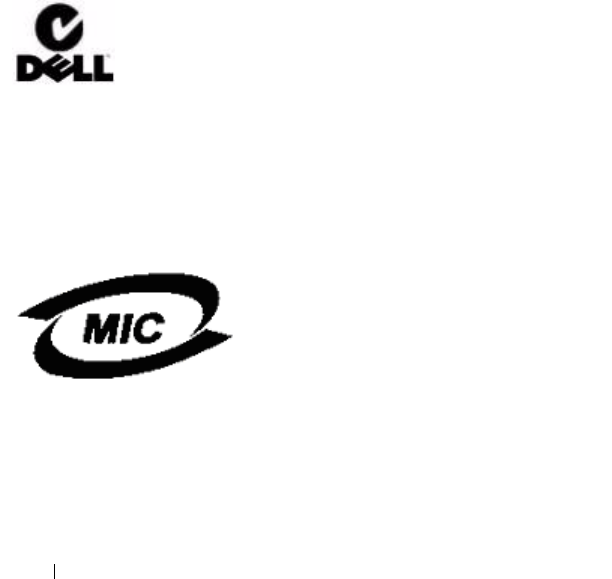
www.dell.com | support.dell.com
146 Appendix
NOTE—This Dell Axim X3 device must be installed and used in strict
accordance with the manufacturer's instructions as described in the user
documentation that comes with the product. Any other installation or use
will violate FCC Part 15 regulations.
NOTE—FCC Radiation Exposure Statement:
This equipment complies with FCC radiation exposure limits set forth for
an uncontrolled environment. End users must follow the specific
operating instructions for satisfying RF exposure compliance.
Mexico
MEC SCT RCPUSCF02-609
Australia and New Zealand
Singapore—Approved by IDA for use in Singapore
DA102617
Korea
R-LARN-03-0166

www.dell.com | support.dell.com
Appendix 147
Radio Approvals
To determine whether you are allowed to use your wireless network device
in a specific country, please check to see if the radio type number that is
printed on the identification label of your device is listed on the radio
approval list posted on the general Dell support site at
www.support.dell.com.
Contacting Dell
To contact Dell electronically, you can access the following websites:
•www.dell.com
•support.dell.com (technical support)
•premiersupport.dell.com (technical support for educational,
government, healthcare, and medium/large business customers,
including Premier, Platinum, and Gold customers)
For specific web addresses for your country, find the appropriate country
section in the table below.
NOTE: Toll-free numbers are for use within the country for which they are
listed.
When you need to contact Dell, use the electronic addresses, telephone
numbers, and codes provided in the following table. If you need assistance
in determining which codes to use, contact a local or an international
operator.

www.dell.com | support.dell.com
148 Appendix
Country (City)
International
Access Code
Country Code
City Code
Department Name or Service
Area,
Website and E-Mail Address
Area Codes,
Local Numbers,
and
Toll-Free Numbers
Australia (Sydney)
International Access
Code: 0011
Country Code: 61
City Code: 2
E-mail (Australia):
au_tech_support@dell.com
E-mail (New Zealand):
nz_tech_support@dell.com
Home and Small Business 1-300-65-55-33
Government and Business toll-free: 1-800-633-
559
Preferred Accounts Division
(PAD) toll-free: 1-800-060-
889
Customer Care toll-free: 1-800-819-
339
Corporate Sales toll-free: 1-800-808-
385
Transaction Sales toll-free: 1-800-808-
312
Fax toll-free: 1-800-818-
341

www.dell.com | support.dell.com
Appendix 149
Austria (Vienna)
International Access
Code: 900
Country Code: 43
City Code: 1
Website: support.euro.dell.com
E-mail:
tech_support_central_europe@d
ell.com
Home/Small Business Sales 0820 240 530 00
Home/Small Business Fax 0820 240 530 49
Home/Small Business Customer
Care 0820 240 530 14
Preferred Accounts/Corporate
Customer Care 0820 240 530 16
Home/Small Business Technical
Support 0820 240 530 14
Preferred Accounts/Corporate
Technical Support 0660 8779
Switchboard 0820 240 530 00
Belgium (Brussels)
International Access
Code: 00
Country Code: 32
City Code: 2
Website: support.euro.dell.com
E-mail: tech_be@dell.com
E-mail for French Speaking
Customers:
support.euro.dell.com/be/fr/email
dell/
Technical Support 02 481 92 88
Customer Care 02 481 91 19
Corporate Sales 02 481 91 00
Fax 02 481 92 99
Switchboard 02 481 91 00
Country (City)
International
Access Code
Country Code
City Code
Department Name or Service
Area,
Website and E-Mail Address
Area Codes,
Local Numbers,
and
Toll-Free Numbers

www.dell.com | support.dell.com
150 Appendix
Canada (North York,
Ontario)
International Access
Code: 011
Online Order Status:
www.dell.ca/ostatus
AutoTech (automated technical
support) toll-free: 1-800-247-
9362
TechFax toll-free: 1-800-950-
1329
Customer Care (Home
Sales/Small Business) toll-free: 1-800-847-
4096
Customer Care (med./large
business, government) toll-free: 1-800-326-
9463
Technical Support (Home
Sales/Small Business) toll-free: 1-800-847-
4096
Technical Support (med./large
bus., government) toll-free: 1-800-387-
5757
Sales (Home Sales/Small
Business) toll-free: 1-800-387-
5752
Sales (med./large bus.,
government) toll-free: 1-800-387-
5755
Spare Parts Sales & Extended
Service Sales 1 866 440 3355
Czech Republic
(Prague)
International Access
Code: 00
Country Code: 420
City Code: 2
Website: support.euro.dell.com
E-mail: czech_dell@dell.com
Technical Support 02 2186 27 27
Customer Care 02 2186 27 11
Fax 02 2186 27 14
TechFax 02 2186 27 28
Switchboard 02 2186 27 11
Country (City)
International
Access Code
Country Code
City Code
Department Name or Service
Area,
Website and E-Mail Address
Area Codes,
Local Numbers,
and
Toll-Free Numbers

www.dell.com | support.dell.com
Appendix 151
Denmark
(Copenhagen)
International Access
Code: 00
Country Code: 45
Website: support.euro.dell.com
E-mail Support (portable
computers):
den_nbk_support@dell.com
E-mail Support (desktop
computers):
den_support@dell.com
E-mail Support (servers):
Nordic_server_support@dell.com
Technical Support 7023 0182
Customer Care (Relational) 7023 0184
Home/Small Business Customer
Care 3287 5505
Switchboard (Relational) 3287 1200
Fax Switchboard (Relational) 3287 1201
Switchboard (Home/Small
Business) 3287 5000
Fax Switchboard (Home/Small
Business) 3287 5001
Country (City)
International
Access Code
Country Code
City Code
Department Name or Service
Area,
Website and E-Mail Address
Area Codes,
Local Numbers,
and
Toll-Free Numbers

www.dell.com | support.dell.com
152 Appendix
Finland (Helsinki)
International Access
Code: 990
Country Code: 358
City Code: 9
Website: support.euro.dell.com
E-mail: fin_support@dell.com
E-mail Support (servers):
Nordic_support@dell.com
Technical Support 09 253 313 60
Technical Support Fax 09 253 313 81
Relational Customer Care 09 253 313 38
Home/Small Business Customer
Care 09 693 791 94
Fax 09 253 313 99
Switchboard 09 253 313 00
Country (City)
International
Access Code
Country Code
City Code
Department Name or Service
Area,
Website and E-Mail Address
Area Codes,
Local Numbers,
and
Toll-Free Numbers

www.dell.com | support.dell.com
Appendix 153
France (Paris)
(Montpellier)
International Access
Code: 00
Country Code: 33
City Codes: (1) (4)
Website: support.euro.dell.com
E-mail:
support.euro.dell.com/fr/fr/email
dell/
Home and Small Business
Technical Support 0825 387 270
Customer Care 0825 823 833
Switchboard 0825 004 700
Switchboard (calls from outside
of France) 04 99 75 40 00
Sales 0825 004 700
Fax 0825 004 701
Fax (calls from outside of France) 04 99 75 40 01
Corporate
Technical Support 0825 004 719
Customer Care 0825 338 339
Switchboard 0155947100
Sales 0155947100
Fax 0155947101
Country (City)
International
Access Code
Country Code
City Code
Department Name or Service
Area,
Website and E-Mail Address
Area Codes,
Local Numbers,
and
Toll-Free Numbers

www.dell.com | support.dell.com
154 Appendix
Germany (Langen)
International Access
Code: 00
Country Code: 49
City Code: 6103
Website: support.euro.dell.com
E-mail:
tech_support_central_europe@d
ell.com
Technical Support 06103 766-7200
Home/Small Business Customer
Care 0180-5-224400
Global Segment Customer Care 06103 766-9570
Preferred Accounts Customer
Care 06103 766-9420
Large Accounts Customer Care 06103 766-9560
Public Accounts Customer Care 06103 766-9555
Switchboard 06103 766-7000
Greece
International Access
Code: 00
Country Code: 30
Website: support.euro.dell.com
E-mail:
support.euro.dell.com/gr/en/email
dell/
Technical Support 080044149518
Gold Technical Support 08844140083
Switchboard 2108129800
Sales 2108129800
Fax 2108129812
Country (City)
International
Access Code
Country Code
City Code
Department Name or Service
Area,
Website and E-Mail Address
Area Codes,
Local Numbers,
and
Toll-Free Numbers

www.dell.com | support.dell.com
Appendix 155
Ireland (Cherrywood)
International Access
Code: 16
Country Code: 353
City Code: 1
Website: support.euro.dell.com
E-mail:
dell_direct_support@dell.com
Ireland Technical Support 1850 543 543
U.K. Technical Support (dial
within U.K. only) 0870 908 0800
Home User Customer Care 01 204 4014
Small Business Customer Care 01 204 4014
U.K. Customer Care (dial within
U.K. only) 0870 906 0010
Corporate Customer Care 1850 200 982
Corporate Customer Care (dial
within U.K. only) 0870 907 4499
Ireland Sales 01 204 4444
U.K. Sales (dial within U.K. only) 0870 907 4000
Fax/SalesFax 01 204 0103
Switchboard 01 204 4444
Country (City)
International
Access Code
Country Code
City Code
Department Name or Service
Area,
Website and E-Mail Address
Area Codes,
Local Numbers,
and
Toll-Free Numbers

www.dell.com | support.dell.com
156 Appendix
Italy (Milan)
International Access
Code: 00
Country Code: 39
City Code: 02
Website: support.euro.dell.com
E-mail:
support.euro.dell.com/it/it/email
dell/
Home and Small Business
Technical Support 02 577 826 90
Customer Care 02 696 821 14
Fax 02 696 821 13
Switchboard 02 696 821 12
Corporate
Technical Support 02 577 826 90
Customer Care 02 577 825 55
Fax 02 575 035 30
Switchboard 02 577 821
Country (City)
International
Access Code
Country Code
City Code
Department Name or Service
Area,
Website and E-Mail Address
Area Codes,
Local Numbers,
and
Toll-Free Numbers

www.dell.com | support.dell.com
Appendix 157
Japan (Kawasaki)
International Access
Code: 001
Country Code: 81
City Code: 44
Website: support.jp.dell.com
Technical Support (servers) toll-free: 0120-198-
498
Technical Support outside of
Japan (servers) 81-44-556-4162
Technical Support (Dimension™
and Inspiron™) toll-free: 0120-198-
226
Technical Support outside of
Japan (Dimension and Inspiron) 81-44-520-1435
Technical Support (Dell
Precision™, OptiPlex™, and
Latitude™)
toll-free:0120-198-
433
Technical Support outside of
Japan (Dell Precision, OptiPlex,
and Latitude)
81-44-556-3894
Faxbox Service 044-556-3490
24-Hour Automated Order
Service 044-556-3801
Customer Care 044-556-4240
Business Sales Division (up to 400
employees) 044-556-1465
Preferred Accounts Division Sales
(over 400 employees) 044-556-3433
Large Corporate Accounts Sales
(over 3500 employees) 044-556-3430
Public Sales (government
agencies, educational institutions,
and medical institutions)
044-556-1469
Global Segment Japan 044-556-3469
Individual User 044-556-1760
Country (City)
International
Access Code
Country Code
City Code
Department Name or Service
Area,
Website and E-Mail Address
Area Codes,
Local Numbers,
and
Toll-Free Numbers

www.dell.com | support.dell.com
158 Appendix
Korea (Seoul)
International Access
Code: 001
Country Code: 82
City Code: 2
Technical Support toll-free: 080-200-
3800
Sales toll-free: 080-200-
3600
Customer Service (Seoul, Korea) toll-free: 080-200-
3800
Customer Service (Penang,
Malaysia) 604 633 4949
Fax 2194-6202
Switchboard 2194-6000
Luxembourg
International Access
Code: 00
Country Code: 352
Website: support.euro.dell.com
E-mail: tech_be@dell.com
Technical Support (Brussels,
Belgium) 3420808075
Home/Small Business Sales
(Brussels, Belgium) toll-free: 080016884
Corporate Sales (Brussels,
Belgium) 02 481 91 00
Customer Care (Brussels,
Belgium) 02 481 91 19
Fax (Brussels, Belgium) 02 481 92 99
Switchboard (Brussels, Belgium) 02 481 91 00
Malaysia (Penang)
International Access
Code: 00
Country Code: 60
City Code: 4
Technical Support tol l-
free: 1 800 888 298
Customer Service 04 633 4949
Transaction Sales toll-
free: 1 800 888 202
Corporate Sales toll-
free: 1 800 888 213
Country (City)
International
Access Code
Country Code
City Code
Department Name or Service
Area,
Website and E-Mail Address
Area Codes,
Local Numbers,
and
Toll-Free Numbers

www.dell.com | support.dell.com
Appendix 159
Mexico
International Access
Code: 00
Country Code: 52
Customer Technical Support 001-877-384-8979
or 001-877-269-3383
Sales 50-81-8800
or 01-800-888-3355
Customer Service 001-877-384-8979
or 001-877-269-3383
Main 50-81-8800
or 01-800-888-3355
Netherlands Antilles General Support 001-800-882-1519
Country (City)
International
Access Code
Country Code
City Code
Department Name or Service
Area,
Website and E-Mail Address
Area Codes,
Local Numbers,
and
Toll-Free Numbers

www.dell.com | support.dell.com
160 Appendix
Netherlands
(Amsterdam)
International Access
Code: 00
Country Code: 31
City Code: 20
Website: support.euro.dell.com
E-mail (Technical Support):
(Enterprise):
nl_server_support@dell.com
(Latitude):
nl_latitude_support@dell.com
(Inspiron):
nl_inspiron_support@dell.com
(Dimension):
nl_dimension_support@dell.com
(OptiPlex):
nl_optiplex_support@dell.com
(Dell Precision):
nl_workstation_support@dell.co
m
Technical Support 020 674 45 00
Technical Support Fax 020 674 47 66
Home/Small Business Customer
Care 020 674 42 00
Relational Customer Care 020 674 4325
Home/Small Business Sales 020 674 55 00
Relational Sales 020 674 50 00
Home/Small Business Sales Fax 020 674 47 75
Relational Sales Fax 020 674 47 50
Switchboard 020 674 50 00
Switchboard Fax 020 674 47 50
Country (City)
International
Access Code
Country Code
City Code
Department Name or Service
Area,
Website and E-Mail Address
Area Codes,
Local Numbers,
and
Toll-Free Numbers

www.dell.com | support.dell.com
Appendix 161
New Zealand
International Access
Code: 00
Country Code: 64
E-mail (New Zealand):
nz_tech_support@dell.com
E-mail (Australia):
au_tech_support@dell.com
Home and Small Business 0800 446 255
Government and Business 0800 444 617
Sales 0800 441 567
Fax 0800 441 566
Norway (Lysaker)
International Access
Code: 00
Country Code: 47
Website: support.euro.dell.com
E-mail Support (portable
computers):
nor_nbk_support@dell.com
E-mail Support (desktop
computers):
nor_support@dell.com
E-mail Support (servers):
nordic_server_support@dell.com
Technical Support 671 16882
Relational Customer Care 671 17514
Home/Small Business Customer
Care 23162298
Switchboard 671 16800
Fax Switchboard 671 16865
Country (City)
International
Access Code
Country Code
City Code
Department Name or Service
Area,
Website and E-Mail Address
Area Codes,
Local Numbers,
and
Toll-Free Numbers

www.dell.com | support.dell.com
162 Appendix
Singapore (Singapore)
International Access
Code: 005
Country Code: 65
Technical Support toll-
free: 800 6011 051
Customer Service (Penang,
Malaysia) 604 633 4949
Transaction Sales toll-
free: 800 6011 054
Corporate Sales toll-
free: 800 6011 053
Spain (Madrid)
International Access
Code: 00
Country Code: 34
City Code: 91
Website: support.euro.dell.com
E-mail:
support.euro.dell.com/es/es/email
dell/
Home and Small Business
Technical Support 902 100 130
Customer Care 902 118 540
Sales 902 118 541
Switchboard 902 118 541
Fax 902 118 539
Corporate
Technical Support 902 100 130
Customer Care 902 118 546
Switchboard 91 722 92 00
Fax 91 722 95 83
Country (City)
International
Access Code
Country Code
City Code
Department Name or Service
Area,
Website and E-Mail Address
Area Codes,
Local Numbers,
and
Toll-Free Numbers

www.dell.com | support.dell.com
Appendix 163
Sweden (Upplands
Vasby)
International Access
Code: 00
Country Code: 46
City Code: 8
Website: support.euro.dell.com
E-mail: swe_support@dell.com
E-mail Support for Latitude and
Inspiron:
Swe-nbk_kats@dell.com
E-mail Support for OptiPlex:
Swe_kats@dell.com
E-mail Support for Servers:
Nordic_server_support@dell.com
Technical Support 08 590 05 199
Relational Customer Care 08 590 05 642
Home/Small Business Customer
Care 08 587 70 527
Employee Purchase Program
(EPP) Support 20 140 14 44
Fax Technical Support 08 590 05 594
Sales 08 590 05 185
Country (City)
International
Access Code
Country Code
City Code
Department Name or Service
Area,
Website and E-Mail Address
Area Codes,
Local Numbers,
and
Toll-Free Numbers

www.dell.com | support.dell.com
164 Appendix
Switzerland (Geneva)
International Access
Code: 00
Country Code: 41
City Code: 22
Website: support.euro.dell.com
E-mail: swisstech@dell.com
E-mail for French-speaking HSB
and Corporate Customers:
support.euro.dell.com/ch/fr/email
dell/
Technical Support (Home and
Small Business) 0844 811 411
Technical Support (Corporate) 0844 822 844
Customer Care (Home and Small
Business) 0848 802 202
Customer Care (Corporate) 0848 821 721
Fax 022 799 01 90
Switchboard 022 799 01 01
Turks and Caicos
Islands General Support toll-free: 1-866-540-
3355
Country (City)
International
Access Code
Country Code
City Code
Department Name or Service
Area,
Website and E-Mail Address
Area Codes,
Local Numbers,
and
Toll-Free Numbers

www.dell.com | support.dell.com
Appendix 165
U.K. (Bracknell)
International Access
Code: 00
Country Code: 44
City Code: 1344
Website: support.euro.dell.com
Customer Care website:
support.euro.dell.com/uk/en/ECare/Form/Home.asp
E-mail:
dell_direct_support@dell.com
Technical Support
(Corporate/Preferred
Accounts/PAD [1000+
employees])
0870 908 0500
Technical Support (direct/PAD
and general) 0870 908 0800
Global Accounts Customer Care 01344 373 186
Home and Small Business
Customer Care 0870 906 0010
Corporate Customer Care 01344 373 185
Preferred Accounts (500–5000
employees) Customer Care 0870 906 0010
Central Government Customer
Care 01344 373 193
Local Government & Education
Customer Care 01344 373 199
Health Customer Care 01344 373 194
Home and Small Business Sales 0870 907 4000
Corporate/Public Sector Sales 01344 860 456
Country (City)
International
Access Code
Country Code
City Code
Department Name or Service
Area,
Website and E-Mail Address
Area Codes,
Local Numbers,
and
Toll-Free Numbers

www.dell.com | support.dell.com
166 Appendix
U.S.A. (Austin, Texas)
International Access
Code: 011
Country Code: 1
Automated Order-Status Service toll-free: 1-800-433-
9014
AutoTech (portable and desktop
computers) toll-free: 1-800-247-
9362
Consumer (Home and Home Office)
Technical Support toll-free: 1-800-624-
9896
Customer Service toll-free: 1-800-624-
9897
DellNet™ Service and Support toll-free: 1-877-Dell-
net
(1-877-335-5638)
Employee Purchase Program
(EPP) Customers toll-free: 1-800-695-
8133
Financial Services website:
www.dellfinancialservices.com
Financial Services (lease/loans) toll-free: 1-877-577-
3355
Financial Services (Dell Preferred
Accounts [DPA]) toll-free: 1-800-283-
2210
Business
Customer Service and Technical
Support toll-free: 1-800-822-
8965
Employee Purchase Program
(EPP) Customers toll-free: 1-800-695-
8133
Projectors Technical Support toll-free: 1-877-459-
7298
Public (government, education, and healthcare)
Country (City)
International
Access Code
Country Code
City Code
Department Name or Service
Area,
Website and E-Mail Address
Area Codes,
Local Numbers,
and
Toll-Free Numbers

www.dell.com | support.dell.com
Appendix 167
Country (City)
International
Access Code
Country Code
City Code
Department Name or Service
Area,
Website and E-Mail Address
Area Codes,
Local Numbers,
and
Toll-Free Numbers
Customer Service and Technical
Support toll-free: 1-800-456-
3355
Employee Purchase Program
(EPP) Customers toll-free: 1-800-234-
1490
Dell Sales toll-free: 1-800-289-
3355
or toll-free: 1-800-
879-3355
Dell Outlet Store (Dell
refurbished computers) toll-free: 1-888-798-
7561
Software and Peripherals Sales toll-free: 1-800-671-
3355
Spare Parts Sales toll-free: 1-800-357-
3355
Extended Service and Warranty
Sales toll-free: 1-800-247-
4618
Fax toll-free: 1-800-727-
8320
Dell Services for the Deaf, Hard-
of-Hearing, or Speech-Impaired toll-free: 1-877-
DELLTTY
(1-877-335-5889)

www.dell.com | support.dell.com
168 Appendix

www.dell.com | support.dell.com
Limited Warranties and Return Policy 169
Limited Warranties and Return Policy
Dell-branded hardware products purchased in the U.S. or Canada come with either a 90-day,
1-year, 2-year, 3-year, or 4-year limited warranty. To determine which warranty came with
your hardware product(s), see your packing slip or invoice. The following sections describe
the limited warranties and return policy for the U.S., the limited warranties and return policy
for Canada, the manufacturer guarantee for Latin America and the Caribbean, and the
Intel® Pentium® and Celeron® warranty for the U.S. and Canada.
Limited Warranty for Dell-Branded Hardware Products
(U.S. Only)
What is covered by this limited warranty?
This limited warranty covers defects in materials and workmanship in your—our end-user
customer's—Dell-branded hardware products, including Dell-branded peripheral products.
What is not covered by this limited warranty?
This limited warranty does not cover:
• Software, including the operating system and software added to the Dell-branded
hardware products through our factory-integration system, third-party software, or the
reloading of software
• Non-Dell-branded and Solution Provider Direct products and accessories
• Problems that result from:
– External causes such as accident, abuse, misuse, or problems with electrical
power
– Servicing not authorized by Dell
– Usage that is not in accordance with product instructions
– Failure to follow the product instructions or failure to perform preventive
maintenance
– Problems caused by using accessories, parts, or components not supplied by Dell
• Products with missing or altered Service Tags or serial numbers
• Products for which Dell has not received payment

www.dell.com | support.dell.com
170 Limited Warranties and Return Policy
THIS WARRANTY GIVES YOU SPECIFIC LEGAL RIGHTS, AND YOU MAY ALSO
HAVE OTHER RIGHTS WHICH VARY FROM STATE TO STATE (OR
JURISDICTION TO JURISDICTION). DELL'S RESPONSIBILITY FOR
MALFUNCITONS AND DEFECTS IN HARDWARE IS LIMITED TO REPAIR AND
REPLACEMENT AS SET FORTH IN THIS WARRANTY STATEMENT. ALL
EXPRESS AND IMPLIED WARRANTIES FOR THE PRODUCT, INCLUDING BUT
NOT LIMITED TO ANY IMPLIED WARRANTIES AND CONDITIONS OF
MERCHANTABILITY AND FITNESS FOR A PARTICULAR PURPOSE, ARE
LIMITED IN TIME TO THE TERM OF THE LIMITED WARRANTY PERIOD
REFLECTED ON YOUR PACKING SLIP OR INVOICE. NO WARRANTIES,
WHETHER EXPRESS OR IMPLIED, WILL APPLY AFTER THE LIMITED
WARRANTY PERIOD HAS EXPIRED. SOME STATES DO NOT ALLOW
LIMITATIONS ON HOW LONG AN IMPLIED WARRANTY LASTS, SO THIS
LIMITATION MAY NOT APPLY TO YOU.
WE DO NOT ACCEPT LIABILITY BEYOND THE REMEDIES PROVIDED FOR IN
THIS LIMITED WARRANTY OR FOR CONSEQUENTIAL OR INCIDENTAL
DAMAGES, INCLUDING, WITHOUT LIMITATION, ANY LIABILTY FOR THIRD-
PARTY CLAIMS AGAINST YOU FOR DAMAGES, FOR PRODUCTS NOT BEING
AVAILABLE FOR USE, OR FOR LOST DATA OR LOST SOFTWARE. OUR
LIABILITY WILL BE NO MORE THAN THE AMOUNT YOU PAID FOR THE
PRODUCT THAT IS THE SUBJECT OF A CLAIM. THIS IS THE MAXIMUM
AMOUNT FOR WHICH WE ARE RESPONSIBLE.
SOME STATES DO NOT ALLOW THE EXCLUSION OR LIMITATION OF
INCIDENTAL OR CONSEQUENTIAL DAMAGES, SO THE ABOVE LIMITATION
OR EXCLUSION MAY NOT APPLY TO YOU.
How long does this limited warranty last?
This limited warranty lasts for the time period indicated on your packing slip or invoice,
except that the limited warranty on Dell-branded batteries lasts only 1 year and the limited
warranty on the lamps for Dell-branded projectors lasts only 90 days. The limited warranty
begins on the date of the packing slip or invoice. The warranty period is not extended if we
repair or replace a warranted product or any parts. Dell may change the availability of limited
warranties, at its discretion, but any changes will not be retroactive.

www.dell.com | support.dell.com
Limited Warranties and Return Policy 171
What do I do if I need warranty service?
Before the warranty expires, please call us at the relevant number listed in the following
table. Please also have your Dell Service Tag or order number available.
What will Dell do?
During the 90 days of the 90-day limited warranty and the first year of all other limited
warranties: During the 90 days of the 90-day limited warranty and the first year of all other
limited warranties, we will repair any Dell-branded hardware products returned to us that
prove to be defective in materials or workmanship. If we are not able to repair the product,
we will replace it with a comparable product that is new or refurbished.
When you contact us, we will issue a Return Material Authorization Number for you to
include with your return. You must return the products to us in their original or equivalent
packaging, prepay shipping charges, and insure the shipment or accept the risk if the product
is lost or damaged in shipment. We will return the repaired or replacement products to you.
We will pay to ship the repaired or replaced products to you if you use an address in the
United States (excluding Puerto Rico and U.S. possessions and territories). Otherwise, we
will ship the product to you freight collect.
If we determine that the product is not covered under this warranty, we will notify you and
inform you of service alternatives that are available to you on a fee basis.
Individual Home Consumers: U.S. Only
Technical Support 1-800-624-9896
Customer Service 1-800-624-9897
Individual Home Consumers who purchased
through an Employee Purchase Program:
Technical Support and Customer Service 1-800-822-8965
Home and Small Business Commercial Customers:
Technical Support and Customer Service 1-800-456-3355
Medium, Large, or Global Commercial Customers,
Healthcare Customers, and Value-Added Resellers
(VARs):
Technical Support and Customer Service 1-800-822-8965
Government and Education Customers:
Technical Support and Customer Service 1-800-234-1490
Dell-Branded Memory 1-888-363-5150

www.dell.com | support.dell.com
172 Limited Warranties and Return Policy
NOTE: Before you ship the product(s) to us, make sure to back up the data on the hard
drive(s) and any other storage device(s) in the product(s). Remove any confidential,
proprietary, or personal information and removable media such as floppy disks, CDs, or PC
Cards. We are not responsible for any of your confidential, proprietary, or personal
information; lost or corrupted data; or damaged or lost removable media.
During the remaining years: For the remaining period of the limited warranty, we will replace
any defective part with new or refurbished parts, if we agree that it needs to be replaced.
When you contact us, we will require a valid credit card number at the time you request a
replacement part, but we will not charge you for the replacement part as long as you return
the original part to us within 30 days after we ship the replacement part to you. If we do not
receive the original part within 30 days, we will charge to your credit card the then-current
standard price for that part.
We will pay to ship the part to you if you use an address in the United States (excluding
Puerto Rico and U.S. possessions and territories). Otherwise, we will ship the part freight
collect. We will also include a prepaid shipping container with each replacement part for
your use in returning the replaced part to us.
NOTE: Before you replace parts, make sure to back up the data on the hard drive(s) and any
other storage device(s) in the product(s). We are not responsible for lost or corrupted data.
What if I purchased a service contract?
If your service contract is with Dell, service will be provided to you under the terms of the
service agreement. Please refer to that contract for details on how to obtain service.
If you purchased through us a service contract with one of our third-party service providers,
please refer to that contract for details on how to obtain service.
How will you fix my product?
We use new and refurbished parts made by various manufacturers in performing warranty
repairs and in building replacement parts and systems. Refurbished parts and systems are
parts or systems that have been returned to Dell, some of which were never used by a
customer. All parts and systems are inspected and tested for quality. Replacement parts and
systems are covered for the remaining period of the limited warranty for the product you
bought. Dell owns all parts removed from repaired products.
May I transfer the limited warranty?
Limited warranties on systems may be transferred if the current owner transfers ownership of
the system and records the transfer with us. The limited warranty on Dell-branded memory
may not be transferred. You may record your transfer by going to Dell's website:
• If you are an Individual Home Consumer, go to
www.dell.com/us/en/dhs/topics/sbtopic_015_ccare.htm

www.dell.com | support.dell.com
Limited Warranties and Return Policy 173
• If you are a Home Office, Small, Medium, Large, or Global Commercial Customer, go
to www.dell.com/us/en/biz/topics/sbtopic_ccare_nav_015_ccare.htm
• If you are a Government, Education, or Healthcare Customer, or an Individual Home
Consumer who purchased through an Employee Purchase Program, go to
www.dell.com/us/en/pub/topics/sbtopic_015_ccare.htm
If you do not have Internet access, call your customer care representative or
call 1-800-624-9897.
"Total Satisfaction" Return Policy (U.S. Only)
We value our relationship with you and want to make sure that you're satisfied with your
purchases. That's why we offer a "Total Satisfaction" return policy for most products that
you—the end-user customer—purchase directly from Dell. Under this policy, you may return
to Dell products that you purchased directly from Dell for a credit or a refund of the
purchase price paid, less shipping and handling and applicable restocking fees as follows:
•New Hardware Products and Accessories — All new hardware, accessories, parts, and
unopened software still in its sealed package, excluding the products listed below, may
be returned within 30 days from the date on the packing slip or invoice. To return
applications software or an operating system that has been installed by Dell, you must
return the entire computer. A different return policy applies to nondefective products
purchased through Dell's Software and Peripherals division by customers of our Small
and Medium Business divisions. Those products may be returned within 30 days from
the date on the packing slip or invoice, but a fifteen percent (15%) restocking fee will
be deducted from any refund or credit. The "Total Satisfaction" Return Policy and
Software and Peripherals division return policy are not available for Dell | EMC
storage products, EMC-branded products, or enterprise software.
•Reconditioned or Refurbished Dell-Branded Hardware Products and Parts — All
reconditioned or refurbished Dell-branded server and storage products may be
returned within 30 days from the date on the packing slip or invoice. All other
reconditioned or refurbished Dell-branded hardware products and parts may be
returned within 14 days of the date on the packing slip or invoice.
To return products, e-mail or call Dell customer service to receive a Credit Return
Authorization Number within the return policy period applicable to the product you want to
return. You must obtain a Credit Return Authorization Number in order to return the
product. See "Contacting Dell" or "Getting Help" in your customer documentation (or
www.dell.com/us/en/gen/contact.htm) to find the appropriate contact information for
obtaining customer assistance.
You must ship the products to Dell within 5 days of the date that Dell issues the Credit
Return Authorization Number. You must also return the products to Dell in their original
packaging, in as-new condition along with any media, documentation, and all other items
that were included in the original shipment, prepay shipping charges, and insure the
shipment or accept the risk of loss or damage during shipment.

www.dell.com | support.dell.com
174 Limited Warranties and Return Policy
Limited Warranty Terms for Dell-Branded Hardware Products
(Canada Only)
What is covered by this limited warranty?
This limited warranty covers defects in materials and workmanship in your—our end-user
customer's—Dell-branded hardware products, including Dell-branded peripheral products.
What is not covered by this limited warranty?
This limited warranty does not cover:
• Software, including the operating system and software added to the Dell-branded
hardware products through our factory-integration system, or the reloading of the
software
• Non-Dell branded and Solution Provider Direct products and accessories
• Problems that result from:
– External causes such as accident, abuse, misuse, or problems with electrical
power
– Servicing not authorized by Dell
– Usage that is not in accordance with product instructions
– Failure to follow the product instructions or failure to perform preventive
maintenance
– Problems caused by using accessories, parts, or components not supplied by Dell
• Products with missing or altered Service Tags or serial numbers
• Products for which Dell has not received payment
THIS WARRANTY GIVES YOU SPECIFIC LEGAL RIGHTS, AND YOU MAY ALSO
HAVE OTHER RIGHTS WHICH VARY FROM PROVINCE TO PROVINCE. DELL'S
RESPONSIBILITY FOR MALFUNCTIONS AND DEFECTS IN PRODUCT IS LIMITED
TO REPAIR AND REPLACEMENT AS SET FORTH IN THIS WARRANTY
STATEMENT, FOR THE TERM OF THE WARRANTY PERIOD REFLECTED ON
YOUR PACKING SLIP OR INVOICE. EXCEPT FOR THE EXPRESS WARRANTIES
CONTAINED IN THIS WARRANTY STATEMENT, DELL DISCLAIMS ALL OTHER
WARRANTIES AND CONDITIONS, EXPRESS OR IMPLIED, INCLUDING WITHOUT
LIMITATION IMPLIED WARRANTIES AND CONDITIONS OF MERCHANTABILITY
AND FITNESS FOR A PARTICULAR PURPOSE, STATUTORY OR OTHERWISE.
SOME PROVINCES DO NOT ALLOW THE EXCLUSION OF CERTAIN IMPLIED
WARRANTIES OR CONDITIONS, OR LIMITATIONS ON HOW LONG AN IMPLIED
WARRANTY OR CONDITION LASTS. THEREFORE, THE FOREGOING
EXCLUSIONS AND LIMITATIONS MAY NOT APPLY TO YOU.

www.dell.com | support.dell.com
Limited Warranties and Return Policy 175
WE DO NOT ACCEPT LIABILITY BEYOND THE REMEDIES PROVIDED FOR IN
THIS WARRANTY STATEMENT OR FOR SPECIAL, INDIRECT, CONSEQUENTIAL,
OR INCIDENTAL DAMAGES, INCLUDING, WITHOUT LIMITATION, ANY LIABILTY
FOR THIRD-PARTY CLAIMS AGAINST YOU FOR DAMAGES, FOR PRODUCTS NOT
BEING AVAILABLE FOR USE, OR FOR LOST DATA OR LOST SOFTWARE. OUR
LIABILITY WILL BE NO MORE THAN THE AMOUNT YOU PAID FOR THE
PRODUCT THAT IS THE SUBJECT OF A CLAIM. THIS IS THE MAXIMUM AMOUNT
FOR WHICH WE ARE RESPONSIBLE.
SOME PROVINCES DO NOT ALLOW THE EXCLUSION OR LIMITATION OF
SPECIAL, INDIRECT, INCIDENTAL, OR CONSEQUENTIAL DAMAGES, SO THE
ABOVE LIMITATION OR EXCLUSION MAY NOT APPLY TO YOU.
How long does this limited warranty last?
This limited warranty lasts for the time period indicated on your packing slip or invoice,
except that the limited warranty on Dell-branded batteries lasts only 1 year and the limited
warranty on the lamps for Dell-branded projectors lasts only 90 days. The limited warranty
begins on the date of the packing slip or invoice. The warranty period is not extended if we
repair or replace a warranted product or any parts. Dell may change the terms and availability
of limited warranties, at its discretion, but any changes will not be retroactive (that is, the
warranty terms in place at the time of purchase will apply to your purchase).
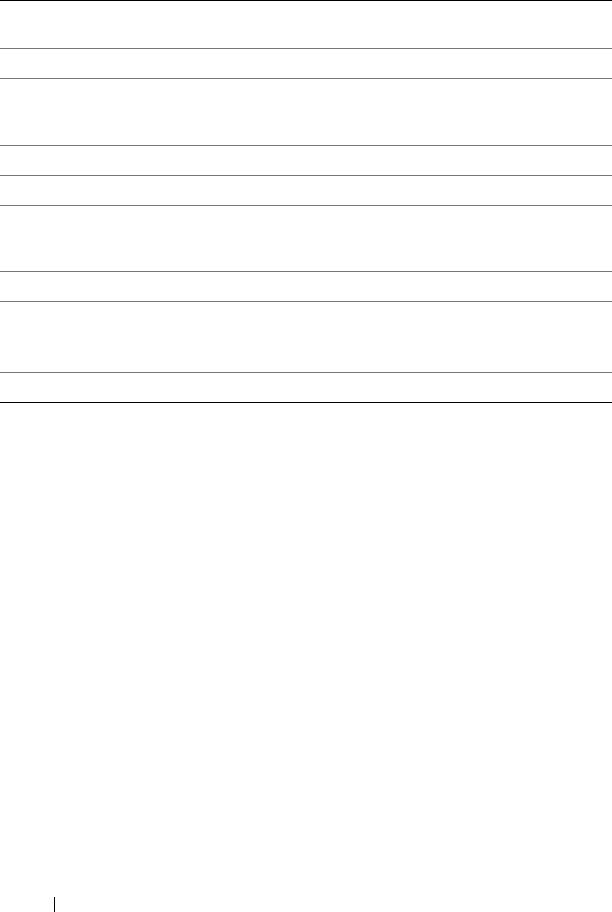
www.dell.com | support.dell.com
176 Limited Warranties and Return Policy
What do I do if I need warranty service?
Before the warranty expires, please call us at the relevant number listed in the following
table. Please also have your Dell Service Tag or order number available.
What will Dell do?
During the 90 days of the 90-day limited warranty and the first year of all other limited
warranties: During the 90 days of the 90-day limited warranty and the first year of all other
limited warranties, we will repair any Dell-branded hardware products returned to us that
prove to be defective in materials or workmanship. If we are not able to repair the product,
we will replace it with a comparable product that is new or refurbished.
When you contact us, we will issue a Return Material Authorization Number for you to
include with your return. You must return the products to us in their original or equivalent
packaging, prepay shipping charges, and insure the shipment or accept the risk if the product
is lost or damaged in shipment. We will return the repaired or replacement products to you.
We will pay to ship the repaired or replaced products to you if you use an address in Canada.
Otherwise, we will ship the product to you freight collect.
If we determine that the problem is not covered under this warranty, we will notify you and
inform you of service alternatives that are available to you on a fee basis.
Individual Home Consumers; Home Office and
Small Business Customers: Canada Only
Technical Support and Customer Service 1-800-847-4096
Medium, Large, and Global Commercial Customers;
Government, Education, and Healthcare
Customers; and Value-Added Resellers (VARs):
Technical Support 1-800-387-5757
Customer Service 1-800-326-9463
Government or Education Customers, or Individual
Home Consumers who purchased through an
Employee Purchase Program:
Technical Support 1-800-387-5757
Customer Service 1-800-326-9463 (Extension
8221 for Individual
Consumers)
Dell-Branded Memory 1-888-363-5150

www.dell.com | support.dell.com
Limited Warranties and Return Policy 177
NOTE: Before you ship the product(s) to us, make sure to back up the data on the hard
drive(s) and any other storage device(s) in the product(s). Remove any confidential,
proprietary or personal information, removable media, such as floppy disks, CDs, or PC
Cards. We are not responsible for any of your confidential, proprietary or personal
information; lost or corrupted data; or damaged or lost removable media.
During the remaining years following the first year of all limited warranties: We will replace
any defective part with new or refurbished parts, if we agree that it needs to be replaced.
When you contact us, we will require a valid credit card number at the time you request a
replacement part, but we will not charge you for the replacement part as long as you return
the original part to us within 30 days after we ship the replacement part to you. If we do not
receive the original part within 30 days, we will charge to your credit card the then-current
standard price for that part.
We will pay to ship the part to you if you use an address in Canada. Otherwise, we will ship
the part freight collect. We will also include a prepaid shipping container with each
replacement part for your use in returning the replaced part to us.
NOTE: Before you replace parts, make sure to back up the data on the hard drive(s) and any
other storage device(s) in the product(s). We are not responsible for lost or corrupted data.
What if I purchased a service contract?
If your service contract is with Dell, service will be provided to you under the terms of the
service contract. Please refer to that contract for details on how to obtain service. Dell's
service contracts can be found online at www.dell.ca or by calling Customer Care at 1-800-
847-4096. If you purchased through us a service contract with one of our third-party service
providers, please refer to that contract (mailed to you with your packing slip or invoice) for
details on how to obtain service.
How will you fix my product?
We use new and refurbished parts made by various manufacturers in performing warranty
repairs and in building replacement parts and systems. Refurbished parts and systems are
parts or systems that have been returned to Dell, some of which were never used by a
customer. All parts and systems are inspected and tested for quality. Replacement parts and
systems are covered for the remaining period of the limited warranty for the product you
bought. Dell owns all parts removed from repaired products.

www.dell.com | support.dell.com
178 Limited Warranties and Return Policy
May I transfer the limited warranty?
Limited warranties on systems may be transferred if the current owner transfers ownership of
the system and records the transfer with us. The limited warranty on Dell-branded memory
may not be transferred. You may record your transfer by going to Dell’s website:
• For Canada-purchased computers (in-country transfers) and to transfer from one
customer to another, go to
www.dell.ca/ca/en/gen/topics/segtopic_ccare_nav_013_ccare.htm
• For out-of-country transfers (outside of the original country of purchase), go to
www.dell.com/us/en/biz/topics/sbtopic_ccare_nav_016_ccare.htm
If you do not have Internet access, call Dell at 1-800-847-4096 (Home Consumer customers)
or 1-800-326-9463 (Corporate Commercial or Government customers).
"Total Satisfaction" Return Policy (Canada Only)
If you are an end-user customer who bought new products directly from Dell, you may return
them to Dell up to 30 days after you receive them for a refund or credit of the product
purchase price. If you are an end-user customer who bought reconditioned or refurbished
products from Dell, you may return them to Dell within 14 days after the date on the
packing slip or invoice for a refund or credit of the product purchase price. In either case, the
refund or credit will not include any shipping and handling charges shown on your packing
slip or invoice and will be subject to a fifteen percent (15%) restocking fee, unless otherwise
prohibited by law. If you are an organization that bought the products under a written
agreement with Dell, the agreement may contain different terms for the return of products
than specified by this policy.
To return products, you must call Dell Customer Service at 1-800-847-4096 to receive a
Credit Return Authorization Number. To expedite the process of your refund or credit, Dell
expects you to return the products to Dell in their original packaging within 5 days of the
date that Dell issues the Credit Return Authorization Number. You must also prepay
shipping charges and insure the shipment or accept the risk of loss or damage during
shipment. You may return software for a refund or credit only if the sealed package
containing the floppy disk(s) or CD(s) is unopened. Returned products must be in as-new
condition, and all of the manuals, floppy disk(s), CD(s), power cables, and other items
included with a product must be returned with it. For customers who want to return, for
refund or credit only, either application or operating system software that has been installed
by Dell, the whole system must be returned, along with any media and documentation that
may have been included in the original shipment.
The "Total Satisfaction" Return Policy does not apply to Dell | EMC storage products. It also
does not apply to products purchased through Dell's Software and Peripherals division. For
those products, please instead refer to Dell's Software and Peripheral's then-current return
policy (see the following section, "Dell Software and Peripherals (Canada Only)").

www.dell.com | support.dell.com
Limited Warranties and Return Policy 179
Dell Software and Peripherals (Canada Only)
Third-Party Software and Peripherals Products
Similar to other resellers of software and peripherals, Dell does not warrant third-party
products. Third-party software and peripheral products are covered by the warranties
provided by the original manufacturer or publisher only. Third-party manufacturer
warranties vary from product to product. Consult your product documentation for specific
warranty information. More information may also be available from the manufacturer or
publisher.
While Dell offers a wide selection of software and peripheral products, we do not specifically
test or guarantee that all of the products we offer work with any or all of the various models
of Dell computers, nor do we test or guarantee all of the products we sell on the hundreds of
different brands of computers available today. If you have questions about compatibility, we
recommend and encourage you to contact the third-party software and peripheral product
manufacturer or publisher directly.
Dell-Branded Peripheral Products
Dell does provide a limited warranty for new Dell-branded peripheral products (products for
which Dell is listed as the manufacturer) such as monitors, batteries, memory, docking
stations, and projectors. To determine which limited warranty applies to the product you
purchased, see the Dell packing slip or invoice and/or the product documentation that
accompanied your product. Descriptions of Dell's limited warranties are described in
preceding sections.
Return Policy
If you are an end-user customer who bought Dell Software and Peripherals products directly
from a Dell company, you may return Dell Software and Peripherals products that are in as-
new condition to Dell up to 30 days from the date on the packing slip or invoice for a refund
of the product purchase price if already paid. This refund will not include any shipping and
handling charges shown on your packing slip or invoice; you are responsible for those.
To return products, you must call Dell Customer Service at 1-800-387-5759 to receive a
Credit Return Authorization Number. You must ship the Dell Software and Peripherals
products back to Dell in their original manufacturer's packaging (which must be in as-new
condition), prepay shipping charges, and insure the shipment or accept the risk of loss or
damage during shipment.
To qualify for refund or replacement, returned products must be in as-new condition,
software products must be unopened, and all of the manuals, floppy disk(s), CD(s), power
cables, and other items included with a product must be returned with it.

www.dell.com | support.dell.com
180 Limited Warranties and Return Policy
1-Year End-User Manufacturer Guarantee (Latin America and
the Caribbean Only)
Guarantee
Dell Inc. ("Dell") warrants to the end user in accordance with the following provisions that
its branded hardware products, purchased by the end user from a Dell company or an
authorized Dell distributor in Latin America or the Caribbean, will be free from defects in
materials, workmanship, and design affecting normal use, for a period of 1 year from the
original purchase date. Products for which proper claims are made will, at Dell’s option, be
repaired or replaced at Dell’s expense. Dell owns all parts removed from repaired products.
Dell uses new and reconditioned parts made by various manufacturers in performing repairs
and building replacement products.
Exclusions
This Guarantee does not apply to defects resulting from: improper or inadequate
installation, use, or maintenance; actions or modifications by unauthorized third parties or
the end user; accidental or willful damage; or normal wear and tear.
Making a Claim
Claims must be made in Latin America or the Caribbean by contacting the Dell point of sale
within the guarantee period. The end user must always supply proof of purchase, indicating
name and address of the seller, date of purchase, model and serial number, name and address
of the customer, and details of symptoms and configuration at the time of malfunction,
including peripherals and software used. Otherwise, Dell may refuse the guarantee claim.
Upon diagnosis of a warranted defect, Dell will make arrangements and pay for ground
freight and insurance to and from Dell’s repair/replacement center. The end user must
ensure that the defective product is available for collection properly packed in original or
equally protective packaging together with the details listed above and the return number
provided to the end user by Dell.
Limitation and Statutory Rights
Dell makes no other warranty, guarantee or like statement other than as explicitly stated
above, and this Guarantee is given in place of all other guarantees whatsoever, to the fullest
extent permitted by law. In the absence of applicable legislation, this Guarantee will be the
end user’s sole and exclusive remedy against Dell or any of its affiliates, and neither Dell nor
any of its affiliates shall be liable for loss of profit or contracts, or any other indirect or
consequential loss arising from negligence, breach of contract, or howsoever.
This Guarantee does not impair or affect mandatory statutory rights of the end user against
and/or any rights resulting from other contracts concluded by the end user with Dell and/or
any other seller.

www.dell.com | support.dell.com
Limited Warranties and Return Policy 181
Dell World Trade LP
One Dell Way, Round Rock, TX 78682, USA
Dell Computadores do Brasil Ltda (CNPJ No. 72.381.189/0001-10)/
Dell Commercial do Brasil Ltda (CNPJ No. 03 405 822/0001-40)
Avenida Industrial Belgraf, 400
92990-000 - Eldorado do Sul – RS - Brasil
Dell Computer de Chile Ltda
Coyancura 2283, Piso 3- Of.302,
Providencia, Santiago - Chile
Dell Computer de Colombia Corporation
Carrera 7 #115-33 Oficina 603
Bogota, Colombia
Dell Computer de Mexico SA de CV
Paseo de la Reforma 2620 - 11° Piso
Col. Lomas Altas
11950 México, D.F.

www.dell.com | support.dell.com
182 Limited Warranties and Return Policy

www.dell.com | support.dell.com
Glossary 183
Glossary
802.11 (WI-FI)—A wireless technology standard for mid-range networking
devices that allows for enabled devices to automatically recognize each other.
BLUETOOTH™—A wireless technology standard for short-range (10 m [30 ft])
networking devices that allows for enabled devices to automatically recognize each
other.
COMPACTFLASH CARD —A removable card that is used to expand the
capabilities of a device. Common types of CompactFlash cards include memory
and wireless cards.
CRADLE —A device that allows your handheld device to synchronize with a
computer, recharge its battery, and run on AC power.
DHCP — dynamic host configuration protocol — A communication protocol
that allows network administrators to manage and automate the assignment of
Internet Protocol addresses to computers in a network.
IMAP — Internet message access protocol — A standard client/server protocol
that allows you to access your e-mail from a server. Using IMAP, you can store and
browse your e-mail on the server.
INFRARED SENSOR —A port that allows you to transfer data between the
computer and infrared-compatible devices without using a cable connection.
ISP — Internet service provider — A company that allows you to access its host
server to connect directly to the Internet, send and receive e-mail, and access
websites. The ISP typically provides you with a software package, username, and
access phone numbers for a fee.
LAN — local area network — A computer network covering a small area. A LAN
usually is confined to a building or a few nearby buildings. A LAN can be
connected to another LAN over any distance via telephone lines and radio waves
to form a wide area network (WAN).
PIM — personal information manager — A program that stores and organizes
your personal information, such as Calendar, Contacts, Inbox, and Tasks.
POP3 — post office protocol 3 — A standard client/server protocol that allows
you to access your e-mail from a server. Using POP3, you must download your
e-mail to your local system to view and browse your messages.
RAM — random-access memory — The primary temporary storage area for
program instructions and data. Any information stored in RAM is lost when you
perform a reset.

www.dell.com | support.dell.com
184 Glossary
RAS — remote access server — A type of server that allows users to access a
network from a remote location.
ROM — read-only memory — Memory that stores data and programs that
cannot be deleted or written to by the device. ROM, unlike RAM, retains its
contents after you perform a reset. Some programs essential to the operation of
your device reside in ROM.
SDRAM — synchronous dynamic random-access memory — A type of DRAM
that is synchronized with the optimal clock speed of the microprocessor.
SECURE DIGITAL CARD —A type of removable memory commonly used in
digital cameras, handheld devices, cell phones, and other devices. Secure Digital
cards are approximately the size of a postage stamp.
SERIAL CONNECTOR —An I/O port often used to connect devices such as a
handheld digital device or digital camera to your computer.
SMS — short message service — A service that is capable of sending short
messages to wireless devices.
SMTP — simple mail transfer protocol — A type of protocol used for sending
and receiving e-mail. SMTP is typically coupled with POP3 or IMAP.
SYNC CABLE —A cable through which you can connect a handheld device to a
computer to transfer or synchronize files.
SYNCHRONIZATION —An automated process that replaces the files in one
location with the most updated files from another location. For example, you can
synchronize the files on your computer with the files on your handheld device.
TCP/IP — transmission control protocol/Internet protocol — The basic
communication language of the Internet. TCP/IP can also be used as a
communication protocol in an intranet or extranet.
USB — universal serial bus — A hardware interface for a low-speed device such
as a USB-compatible keyboard, mouse, joystick, scanner, set of speakers, printer,
broadband devices (DSL and cable modems), imaging devices, or storage devices.
Devices are plugged directly into a 4-pin socket on your computer or into a
multiport hub that plugs into your computer. USB devices can be connected and
disconnected while the computer is turned on, and they can also be daisy-chained
together.
VPN — virtual private network — A set of communication protocols that allows
remote users to securely access a network.
WAP — wireless application protocol — A standardization for the way that
wireless devices access the Internet.

Index 185
Index
A
ActiveSync
about 65
installing 67
appointments
scheduling 71
audio
Media player 99
notifications 84
AvantGo
about 108
B
battery
charging 26
main 25
using and installing 25
block recognizer 51
Bluetooth
settings 63
books
library 100
Reader 99
reading ebooks 100
removing 103
buttons
about 36
Calendar 23
Contacts 23
Home 23
Inbox 23
locations 22
navigator 23
power 23
program buttons 39
record 23
reset 24
scroll dial 23
C
Calendar
about 70
appointments 71
meeting requests 72
command bar 41
communicating
with other devices 113
CompactFlash
slot 22
computer
connecting to 27

186 Index
Contacts
about 73
creating 74
finding 74
cradle
connecting to a computer 27
D
data
backing up 45
disconnecting
dial-up connection 119
from a cable or cradle 119
from a network 119
infrared sensor 119
drawing
creating 56
E
editing
written text 53
e-mail
composing messages 81
connecting to a server 79, 120
Inbox 78
message list 79
organizing 83
synchronizing 78
ethernet connection 117
Excel
about 94
tips 96
expansion slots
locations 22
F
files
backing up 45
File Explorer 88
finding 88
finding and organizing 44
synchronizing 65
finding information 18
contacting Dell 147
H
help
ActiveSync Help 120
contacting Dell 147
finding 120
Pocket PC Help 18
I
icons
program 40
status 38
Inbox
about 78

Index 187
infrared
using 114
input panel 48
Internet
connecting to 113
Internet Explorer
about 105
browsing the web 109
favorite links 108
mobile favorites 106, 108
K
keyboard
soft 50
L
letter recognizer 50
M
Media Player
about 99
meeting requests
creating 72
memory
conserving 107
microphone
recording a message 58
modem connection 116
MSN Messenger
about 97
setting up 97
working with contacts 98
My Text
inserting 59
N
navigation bar 41
network
connecting to 113
Notes
creating 76
notifications
about 84
P
Pocket Outlook
about 70
Pocket PC
getting started 35
pop-up menus 43
print-style text
converting written text to 50, 51

188 Index
programs
accessing 39
ActiveSync 65
adding and removing 85
adding programs using
ActiveSync 86
AvantGo 108
Calendar 70
Contacts 73
downloading 87
Inbox 78
Media Player 99
MSN Messenger 97
Notes 76
Pocket Excel 94
Pocket Internet Explorer 105
Pocket Outlook 70
Pocket Word 92
Reader 99
removing 89
Start menu 88
Switcher Bar 40
Tasks 75
R
Reader
about 99
features 101
recording
voice messages 58
reminders. See notifications
reset
button 24
performing 33
resources
finding 18
S
safety instructions 11
scroll dial 23
Secure Digital card slot
installing cards 32
location 22
service tag 19, 26
settings
adjusting 61
Connections tab 63
Personal tab 62
System tab 62
software. See programs
specifications 124
stylus
using 36
writing methods 47
Switcher Bar 40
sync cable
connecting to a computer 30
synchronizing
with your computer 27

Index 189
T
Tasks
about 75
creating 75
text
converting written text to
print-style text 50, 51
editing 52, 53
input panel 48
typing 50
written 50, 51, 52
Today screen 36
transcriber 51
V
video
Media Player 99
VPN connection 118
W
warranty 169
Word
about 92
writing
block recognizer 51
converting written text to
print-style text 50, 51
drawing 56
editing 52
letter recognizer 50
methods 47
on the screen 52
transcriber 51

190 Index